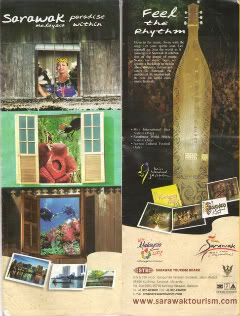Borneo Again
#1
Original Poster
Join Date: Feb 2000
Location: Lake Oswego, OR
Programs: UA 1K 2MM, Marriott Lifetime Platinum, Hilton Diamond
Posts: 3,202
Borneo Again
Mapping My Way to Borneo
This is the story of how a map of the Malaysian state of Sarawak helped me to find my way home to Portland, OR. On one side of the map is an overview of all of the major highways, parks, lakes and towns that comprise the state in the northwestern corner of the island of Borneo. The Malaysian state of Sabah borders Sarawak to the east, the Indonesian states of East and West Kalimantan border it to the south and the South China Sea frames its coast to the north. Sarawak entirely engulfs the tiny country of Brunei, which resides in its northeast corner.
The other side of the map contains a detailed view of Kuching, its largest city. The map shows all of Kuchingís major roadways and includes a number of important tourist landmarks, including parks, museums, hotels and restaurants.
As would be expected, there is nothing at all on the map that mentions Portland, OR. In fact, it should come as no surprise that it doesnít show anything at all about Oregon, the United States, North America or even the western hemisphere. The map doesnít show any other location in Asia nor even Peninsular Malaysia. Yet, if it was not for this map of Sarawak, I might have been stranded there.
I had never visited Malaysia prior to October of 2007 but I have been there four times in the ensuing six months. Kuala Lumpur has proven to be an excellent city in which to undertake mattress runs because hotel rates are not as expensive as they are in other major Asian cities and, as a participant in both the SPG and Hilton HHonors hotel loyalty programs, the city presented me with four different properties from which to choose.
The Hilton Kuala Lumpur Hotel and the Le Mťridien Kuala Lumpur are very conveniently located next to KL Sentral, thereby affording inexpensive and frequent access to both the Low Cost Carrier Terminal and main terminal of Kuala Lumpur International Airport. Even better, these two properties share the same entrance, thus facilitating easy transfers between the two hotels.
The Hotel Imperial is part of the SPG Luxury Collection and can be accessed from KL Sentral either by KL Monorail by taking the LRT three stops to the Dang Wangi station, followed by a short walk. The Westin Kuala Lumpur is somewhat less conveniently located but is about a 10 minute walk from nearest monorail station at Bukit Bintang.
During my first visit to Malaysia, I wandered around Kuala Lumpur and then journeyed to Borneo, spending a few days each in Sabah and Sarawak. On my second visit, I spent a couple of more days in Kuala Lumpur and then spent a full week in Kota Kinabalu in Sabah, from which I engaged in day trips to various parts of the Malaysian state. I arrived in Kuala Lumpur for my third visit in late February of 2008. My final destination for that trip was actually Bali, where I spent a week sightseeing and monkeying around. During that trip, I was walking past the Convention Centre one hot and steamy morning and noticed a large sign outside advertising the Malaysia Airlines Travel Fair. From the looks of a nearby street sign, at first I thought the whole thing was some kind of trick.
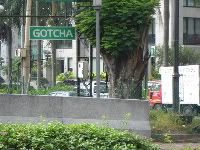
Furthermore, given that Malaysia Airlines is not a Star Alliance partner and I had no plans to fly them anytime soon, at first I hesitated to enter the facility but I eventually coughed up the hefty two ringgit entry fee and wandered on in anyway.
What I found inside the cavernous convention hall was not entirely unexpected. There were hundreds of independent travel agencies, all hawking flights on Malaysia Airlines to various areas of the planet. Just for variety, some of the vendors were also promoting timeshares to various Malaysian resort properties. For the most part, all of the vendors were very friendly and I stopped to chat with a few of them from time to time, asking them whether they had any good fares on airlines other than MAS.
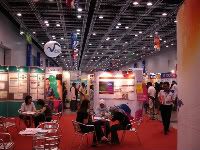

A full hour had elapsed by the time I reached the far corner of the convention centre and just as I was about to turn back, I spotted a booth sponsored by the Sarawak Tourism Board. I had already been planning a visit to Sarawak in early April, so I stopped for a while to chat with the friendly representative. In the course of our conversation she gave me a great map of Sarawak and I then continued on my way. It was this map that turned out to be so very important to me once I had arrived in Sarawak in April. In fact, it actually proved to be much more important than I could have imagined at the time.
Third Timeís a Charm
I have previously documented all of the many difficulties I have encountered in my efforts to fly to Singapore on United Airlines this year. In my two prior attempts thus far, UA cancelled my flight from SFO to NRT, forcing me to undertake some very fast running and quick thinking in order to salvage the outbound component of my trip.
When I entered the PDX Red Carpet Club early in the morning of April 2, the concierge asked me where I was heading today and her amiable expression changed noticeably when I told her, "Singapore." After pausing for a few seconds, she told me that there might be a problem with my flight and asked me to take a seat, adding that she would get back to me shortly.
This would make three cancellations in a row, I thought to myself, as I shuffled nervously towards the back of club and began to contemplate alternative ways to reach Singapore. About 10 minutes later, the concierge came to my seat and informed me that everything appeared to be just fine with my flight. ^ She explained that she had just learned that there was a system wide inspection issue affecting all 777s in UA's fleet, causing all such planes to be grounded! In my case, I was saved by the fact that my flight from SFO to HKG was on a 747 today, a somewhat ironic fact considering that the myriad mechanical issues I have endured thus far had all been confined to 747 metal. She further explained that UA only possessed a total of six specialized tool kits required to undertake the inspections, which implied that there most likely would be numerous 777 cancellations or delays that day.
I boarded my 757 flight to SFO on time and soon settled into seat 2D. Unlike my last such flight, I could see no evidence of crossword puzzles or sudukos deployed on the jumpseat so I figured that perhaps in flight service would not be as bad as it was last time. The sky was very clear during liftoff and we were treated to a very nice view of the Portland metropolitan area as we circled around and headed south at 7:45 AM.

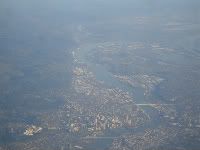
Despite very smooth skies, the initial and only beverage service did not begin until 45 minutes later. Given that two flight attendants were working the F cabin that morning, they soon settled down to chat amongst themselves for the remainder of the flight.
I wanted another beverage and, though this is something I rarely ever do, I felt compelled to ring the call button. A male flight attendant came over to my seat within a few seconds and asked me, in a pleasant tone, "Are you feeling unloved?" Indeed I was but I felt ever so slightly loved again when he brought me another beverage.
My seat opponent turned out to be a very interesting fellow. He lived in Vancouver, WA and was flying to Asia where he was working on a gig as a professional underwater photographer, a skill he first acquired at age 60! I learned that he was also flying to Singapore and then continuing on to Manado so I asked him when his flight was scheduled to depart from SFO. He answered that he thought it departed at about 1:40 PM and then dug out his itinerary to confirm it. His response initially surprised me because UA does not have any flights that depart to either NRT or HKG at that time of day. He responded that he was flying Singapore Airlines in first class! I told him that I was very jealous because I was merely flying in UA business class. We exchanged our names and other pleasantries and soon went on our respective ways upon landing at the domestic terminal of SFO.
The shuttle to the international terminal had already started its morning service by the time I got there so there was no need for me to re-clear security as I had to do for my international trips earlier this year. Given that the Silver Kris Lounge was already operating under summer hours, I hung around the international Red Carpet Club for over an hour until the Singapore lounge opened, at around at 10:50 AM. Upon entering the Silver Kris Lounge, I dutifully presented my UA boarding pass to the concierge and just as I was about to turn right into the lounge, I had a brilliant idea. @:-) I mentioned to the concierge that I planned to visit a friend of mine, properly remembering the name of my seat opponent from the PDX flight. And thatís how I found myself directed towards the left and into the first class section of the Silver Kris Lounge.
We chatted pleasantly for a while and I enjoyed a nice assortment of adult beverages and very tasty munchies over the next hour and a half.
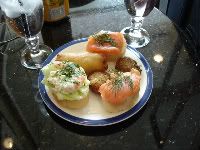

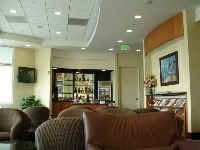
During that time, not a single other passenger entered the lounge. By 12:10 PM, I figured that it was time for me to board my 12:40 PM flight to HKG so I bid my lounge mate goodbye and began walking towards the exit. Just as I reached the threshold, he had a sudden flash of cognizance and asked me, "By the way, how did you get into the first class lounge?" I replied, honestly, that I had told the concierge I was here see to him. I then left the club and ambled over towards my flight, which had already finished boarding by the time I got there.
I then left the club and ambled over towards my flight, which had already finished boarding by the time I got there.
The 14 hour flight from SFO to HKG arrived nearly on time and was served by some very nice and friendly Hong Kong based flight attendants. I found one FA in particular to be especially interesting. She grew up in Paris, is based in HKG but has lived in Bangkok for the past 10 years, which makes for a fairly lengthy commute to her job in HKG. The only downside of this flight was that the entertainment system was inoperative, a very long time to be without audio. Nevertheless, I was quite happy that the flight wasnít canceled, which is more than many other UA travelers could say that day.
Once successfully past HKG security, I had enough time to take a shower in the RCC and relax a little bit before boarding my flight to SIN. Actually, it turned out that I had to relax somewhat more than a little bit because the flight to SIN was delayed. Given that my objective was to board this flight as late as possible, I was struck by the shear inability of the RCC concierges to offer any useful information at all regarding expected boarding and departure times. I tried and failed several times to determine exactly when boarding would begin for my flight, which was originally slated to depart at 8:00 PM. Some of the responses were humorously ludicrous. When I approached the desk at 7:55 PM, the concierge studied her monitor and told me that boarding had not begun yet but the system was still showing an on time departure of 8:00 PM!
I wound up making my best guestimate about boarding and left the club at 8:40 PM. By the time I arrived at the gate, it was clear that boarding had just commenced and the line to enter the jetway could have easily exceeded 200 passengers. Then I remembered that I could avail myself of the special red carpet boarding that UA had implemented last year for 1K, GS, C and F passengers and was able to amble onto the jetway unimpeded with no wait whatsoever. ^
Kuala Lumpur Revisited
After a bit of rest in the Terminal 3 transit hotel at Changi, I caught up with email for a while before attempting to secure a boarding pass for my Air Asia flight to Kuala Lumpur. At the time that I purchased this ticket, Air Asia was in the midst of a zero ringgit fare sale so I was able to pick up this ticket for $61 SGD, a fare comprised only of taxes and fees. Air Asia does not maintain an airside transfer desk so obtaining a boarding pass necessitated exiting through customs and immigration, wading through the scrum amassed at the check-in counter in terminal 1 and then re-entering the airport 15 minutes later.
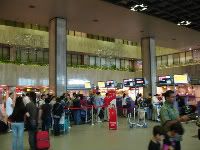
Once back inside the civilized space of Changi, I figured that it might be fun to look for my "friend" who had unwittingly hosted me into the first class SKL lounge at SFO, since I knew he had another flight scheduled for this morning. However, the staff manning the SKL lounge explained that he was flying to Manado on Silk Air and that lounge did not permit guests because they are not part of the Star Alliance. Oh well, I guess I would have to slum it using one of the hundreds of free computers that populate terminal 1 at Changi.
Air Asia traditionally never uses jetways in order to process their "self loading cargo." Instead, after a plane lands, portable stairs are towed to both the front and rear exits and passengers quickly and efficiently deboard. Just as soon as the last passenger trundles off the plane, it is immediately ready for boarding by outbound passengers. It is actually a relatively orderly process and is surprisingly fast and efficient. As a "low cost" carrier, there are no assigned seats in the single class cabin so its first come, first served.
However, you can get an early crack at specific seats, either if you are over 65 or if you purchase Xpress Boarding at the time you book your flight. Passengers over 55 years old can purchase Xpress Boarding at a substantial discount. Quite frankly, Xpress Boarding without the discount is not terribly expensive but it turned out to be quite a bit cheaper when Air Asiaís web site simply forgot to charge the fee for my flight from SIN to KUL. Coupled with the zero dollar fare sale that was in affect at the time, my SGD 61 total fare was quite a bargain.
Coupled with the zero dollar fare sale that was in affect at the time, my SGD 61 total fare was quite a bargain. 
At most other airports, Air Asia has managed to coerce the local authorities to build a special low cost terminal just for them or at the very least to carve out a section all to themselves. However, one unique aspect of SIN is that the airline shares the very same terminal (T1) as all of the other "high cost" carriers and were thus obliged to use an actual jetway.
I have carefully studied the Xpress Boarding process many times and I have never seen the Air Asia staff manage the queue the same way twice in a row. Sometimes two lines form in front of the exit door but at other times, two separate gates are used but which one will be assigned to Xpress Boarding seems to remain a closely guarded state secret up until the last minute. At SIN, Air Asia is only assigned a single gate so they separate the Xpress Boarding wheat from the non-express boarding chaff, by handing out little red and white stickers bearing the words, "Xpress Boarding." All passengers proudly wearing this sticker are then invited to board as soon as the doors to the jetway are opened.
The problem is that when a lane has not been explicitly assigned to Xpress Boarding, a long queue may have already formed, comprised of a mixture of passengers, both Xpress and local. My solution today was to stand right next to the lengthy queue, proudly displaying my Xpress Boarding sticker and as soon as the doors to the jetway opened, I was invited to board first. Incidentally, I still have the Air Asia Xpress Boarding sticker, should anyone need it.

Today, my Air Asia flight actually boarded on time and I was able to snag an aisle seat in the bulkhead row, which, I am certain has considerably more legroom that most other rows on the plane. Just before the doors were about to close, three passengers suddenly walked on board, escorted by a fellow in uniform. He was clutching some forms in his hand and as he walked by, I could easily see the words, "deported" in bold letters at the top of the paperwork.
Twenty minutes after boarding had commenced, we were already pulling away from the gate and five minutes after that we were airborne. I am always amazed that Air Asia manages to serve (i.e. sell) meals on all flights regardless of duration, in the case of the KUL flight, barely a half hour of actual flight time. American carriers often whinge about serving food on flights spanning many hours, even in first class. On the other hand, Air Asia charges for water and forbids passengers from consuming their own food or beverages on board.
On the other hand, Air Asia charges for water and forbids passengers from consuming their own food or beverages on board.
Soon enough, we had landed at the Low Cost Carrier Terminal of KUL. The moment we touched down, the three deportees and their custodian materialized at the front of the plane, even though it was still meandering around the tarmac at considerable speed.
I transited through immigration very quickly, the process facilitated by the fact that Malaysia no longer requires passengers to fill out immigration forms. A short while later, I boarded the yellow 8 ringgit bus that leaves very frequently from the low cost carrier terminal on its way to KL Sentral. From the train station, I walked across the street to the Brickfields terminus of the KL Monorail and took the cramped conveyance five stops to the Bukit Bintang station. From there, I walked about 10 minutes into the cool embraces of the Westin, where I planned to spend the next three nights using a 50% off platinum award. This is the fourth Starwood/Hilton hotel I have enjoyed in Kuala Lumpur and they treated me quite well, providing me a beautiful suite and a very pleasant lounge that provided munchies and beverages in the evening.
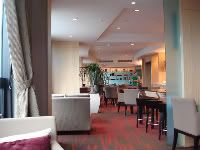


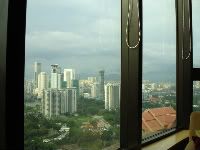
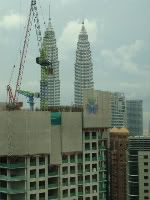
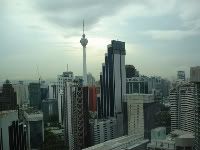
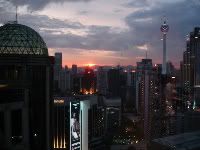
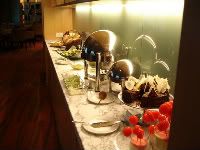
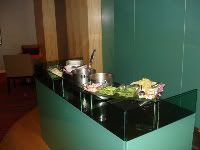
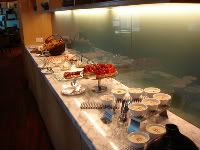
In the morning, I was offered a choice of breakfast either in the lounge or in the restaurant. I opted for the restaurant, which was absolutely amazing, comprised of room after room offering a huge array of foods, including Malaysian, Chinese, Indian, Western and a separate bakery room offering hundreds of choices.
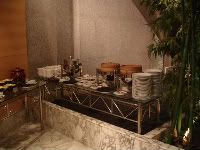
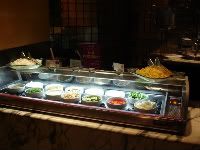
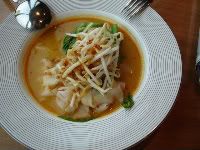

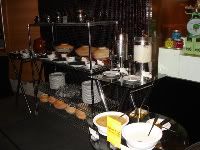
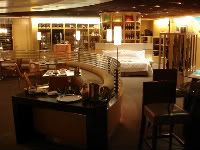

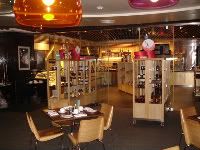

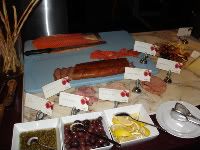
I had been in Kuala Lumpur several times before so I spent my days just wandering around, visiting every corner of the city that had thus far eluded me, including Pudu Prison and the Sze Ya temple.

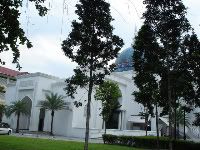
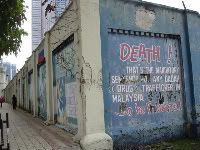
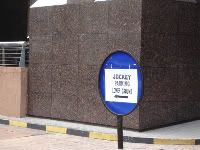
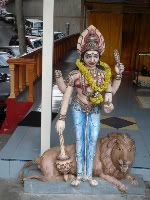
Into the Mines
I had run out of new sites to see in Kuala Lumpur and still had one more day to kill so I figured I would spend a few hours journeying to a nearby shopping center called The Mines. To get there required taking the KL Monorail to the KL Sentral train station and then hopping aboard one of the crowded and chronically delayed commuter railroads for the short ride to Serdang, about 20 minutes south of Kuala Lumpur. From there, I would need to take a water taxi to get to the mall!
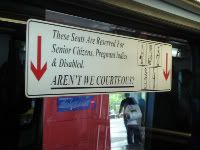
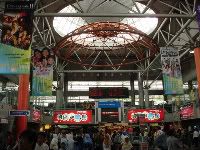


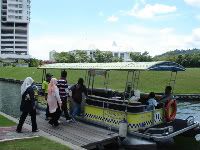
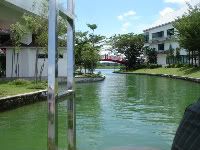

The reason is that The Mines was actually built on the former site of the Hong Fatt Tin Mine, the largest open cast tin mine in the world. When the mine shut down, a 150-acre man-made lake was left behind and around this lake was built two hotels, a shopping center, an ice-skating rink, a cinema, a golf course and a "Wonderland" theme park. The theme park contains a "snow house" that maintains a temperature of between -10įC to -15įC and houses ice carvings such as the Petronas Twin Towers, KL Tower and KLIA. The four storey mall encloses 250 shops surrounding a canal that can be accessed via water taxi, a short walk from the Serdang train station. So, I guess in some cosmic sense, the site still functions metaphorically as mine, but this time harvesting the gold in the pocket rather than the ore in the earth.
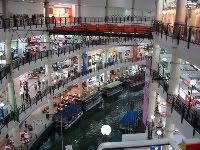
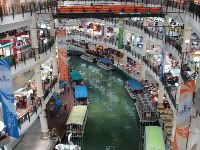
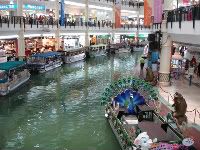
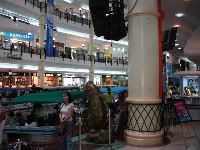
The mall itself is so large that the kiddies can even take light rail to get around:

It boasts every conceivable store, where one can purchase 15 ringgit haircuts:
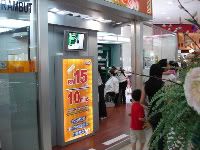
An electronics and appliance store where it looks like one can ride on the most modern of toilets:

and a store where one can purchase the best rejects available this side of the Klang River:
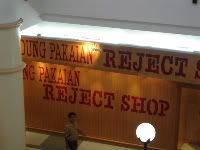
As would be expected of any mall on a busy Sunday, The Mines was teaming with hordes of families and free range children. However, I noticed that many of them were fairly well-behaved, no doubt due to the fact that the proprietors clearly took discipline very seriously here. It appeared that any children caught misbehaving were condemned to a small island in the middle of the canal and were then unceremoniously turned to stone, appropriately symbolic of the mallís former venue as a tin mine.
And should any of these stoned children attempt to escape, the water was teaming with a vicious mass of voracious catfish, eagerly waiting to consume anything and everything that should enter into the waterís dark and turbid depths. The hapless children would certainly be easy pickings by the catfish, who could easily crawl up on land at night and simply walk over to the immobilized children and devour them!
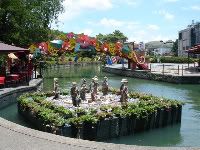

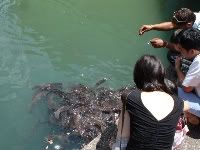

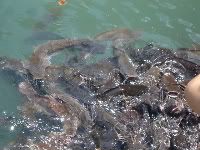
On the video, you can watch as parents point towards the island of stoned children and warn their brood that they too will end of up there if they donít toe the line. If you listen carefully, you can actually hear the children screaming in terror as the parents warn them about the horrors that await them in the murky depths:

Once back inside the cooler confines of the mall, I discovered that the food court was populated by more than a few fish head curry establishments. I watched as plate after plate of fish were greedily consumed by numerous young and hungry mouths, all of which knew that they had better watch their step lest they get turned to stone and sentenced to the rocky isle in the middle of the canal, guarded by the hungry and vicious catfish, source of the very same fish heads upon which they were eagerly feeding. Circle of life and all that.
The fish actually looked rather tasty and I thought briefly about ordering some and then complaining to the wait staff that I had found a fish head in my food. However, I was still quite full from my amazing Westin breakfast and decided to meander off and annoy these people some other day.
Next Chapter: From Catfish to Cat City Ö
This is the story of how a map of the Malaysian state of Sarawak helped me to find my way home to Portland, OR. On one side of the map is an overview of all of the major highways, parks, lakes and towns that comprise the state in the northwestern corner of the island of Borneo. The Malaysian state of Sabah borders Sarawak to the east, the Indonesian states of East and West Kalimantan border it to the south and the South China Sea frames its coast to the north. Sarawak entirely engulfs the tiny country of Brunei, which resides in its northeast corner.
The other side of the map contains a detailed view of Kuching, its largest city. The map shows all of Kuchingís major roadways and includes a number of important tourist landmarks, including parks, museums, hotels and restaurants.
As would be expected, there is nothing at all on the map that mentions Portland, OR. In fact, it should come as no surprise that it doesnít show anything at all about Oregon, the United States, North America or even the western hemisphere. The map doesnít show any other location in Asia nor even Peninsular Malaysia. Yet, if it was not for this map of Sarawak, I might have been stranded there.

I had never visited Malaysia prior to October of 2007 but I have been there four times in the ensuing six months. Kuala Lumpur has proven to be an excellent city in which to undertake mattress runs because hotel rates are not as expensive as they are in other major Asian cities and, as a participant in both the SPG and Hilton HHonors hotel loyalty programs, the city presented me with four different properties from which to choose.
The Hilton Kuala Lumpur Hotel and the Le Mťridien Kuala Lumpur are very conveniently located next to KL Sentral, thereby affording inexpensive and frequent access to both the Low Cost Carrier Terminal and main terminal of Kuala Lumpur International Airport. Even better, these two properties share the same entrance, thus facilitating easy transfers between the two hotels.
The Hotel Imperial is part of the SPG Luxury Collection and can be accessed from KL Sentral either by KL Monorail by taking the LRT three stops to the Dang Wangi station, followed by a short walk. The Westin Kuala Lumpur is somewhat less conveniently located but is about a 10 minute walk from nearest monorail station at Bukit Bintang.
During my first visit to Malaysia, I wandered around Kuala Lumpur and then journeyed to Borneo, spending a few days each in Sabah and Sarawak. On my second visit, I spent a couple of more days in Kuala Lumpur and then spent a full week in Kota Kinabalu in Sabah, from which I engaged in day trips to various parts of the Malaysian state. I arrived in Kuala Lumpur for my third visit in late February of 2008. My final destination for that trip was actually Bali, where I spent a week sightseeing and monkeying around. During that trip, I was walking past the Convention Centre one hot and steamy morning and noticed a large sign outside advertising the Malaysia Airlines Travel Fair. From the looks of a nearby street sign, at first I thought the whole thing was some kind of trick.

Furthermore, given that Malaysia Airlines is not a Star Alliance partner and I had no plans to fly them anytime soon, at first I hesitated to enter the facility but I eventually coughed up the hefty two ringgit entry fee and wandered on in anyway.

What I found inside the cavernous convention hall was not entirely unexpected. There were hundreds of independent travel agencies, all hawking flights on Malaysia Airlines to various areas of the planet. Just for variety, some of the vendors were also promoting timeshares to various Malaysian resort properties. For the most part, all of the vendors were very friendly and I stopped to chat with a few of them from time to time, asking them whether they had any good fares on airlines other than MAS.



A full hour had elapsed by the time I reached the far corner of the convention centre and just as I was about to turn back, I spotted a booth sponsored by the Sarawak Tourism Board. I had already been planning a visit to Sarawak in early April, so I stopped for a while to chat with the friendly representative. In the course of our conversation she gave me a great map of Sarawak and I then continued on my way. It was this map that turned out to be so very important to me once I had arrived in Sarawak in April. In fact, it actually proved to be much more important than I could have imagined at the time.
Third Timeís a Charm
I have previously documented all of the many difficulties I have encountered in my efforts to fly to Singapore on United Airlines this year. In my two prior attempts thus far, UA cancelled my flight from SFO to NRT, forcing me to undertake some very fast running and quick thinking in order to salvage the outbound component of my trip.
When I entered the PDX Red Carpet Club early in the morning of April 2, the concierge asked me where I was heading today and her amiable expression changed noticeably when I told her, "Singapore." After pausing for a few seconds, she told me that there might be a problem with my flight and asked me to take a seat, adding that she would get back to me shortly.
This would make three cancellations in a row, I thought to myself, as I shuffled nervously towards the back of club and began to contemplate alternative ways to reach Singapore. About 10 minutes later, the concierge came to my seat and informed me that everything appeared to be just fine with my flight. ^ She explained that she had just learned that there was a system wide inspection issue affecting all 777s in UA's fleet, causing all such planes to be grounded! In my case, I was saved by the fact that my flight from SFO to HKG was on a 747 today, a somewhat ironic fact considering that the myriad mechanical issues I have endured thus far had all been confined to 747 metal. She further explained that UA only possessed a total of six specialized tool kits required to undertake the inspections, which implied that there most likely would be numerous 777 cancellations or delays that day.
I boarded my 757 flight to SFO on time and soon settled into seat 2D. Unlike my last such flight, I could see no evidence of crossword puzzles or sudukos deployed on the jumpseat so I figured that perhaps in flight service would not be as bad as it was last time. The sky was very clear during liftoff and we were treated to a very nice view of the Portland metropolitan area as we circled around and headed south at 7:45 AM.


Despite very smooth skies, the initial and only beverage service did not begin until 45 minutes later. Given that two flight attendants were working the F cabin that morning, they soon settled down to chat amongst themselves for the remainder of the flight.

I wanted another beverage and, though this is something I rarely ever do, I felt compelled to ring the call button. A male flight attendant came over to my seat within a few seconds and asked me, in a pleasant tone, "Are you feeling unloved?" Indeed I was but I felt ever so slightly loved again when he brought me another beverage.

My seat opponent turned out to be a very interesting fellow. He lived in Vancouver, WA and was flying to Asia where he was working on a gig as a professional underwater photographer, a skill he first acquired at age 60! I learned that he was also flying to Singapore and then continuing on to Manado so I asked him when his flight was scheduled to depart from SFO. He answered that he thought it departed at about 1:40 PM and then dug out his itinerary to confirm it. His response initially surprised me because UA does not have any flights that depart to either NRT or HKG at that time of day. He responded that he was flying Singapore Airlines in first class! I told him that I was very jealous because I was merely flying in UA business class. We exchanged our names and other pleasantries and soon went on our respective ways upon landing at the domestic terminal of SFO.
The shuttle to the international terminal had already started its morning service by the time I got there so there was no need for me to re-clear security as I had to do for my international trips earlier this year. Given that the Silver Kris Lounge was already operating under summer hours, I hung around the international Red Carpet Club for over an hour until the Singapore lounge opened, at around at 10:50 AM. Upon entering the Silver Kris Lounge, I dutifully presented my UA boarding pass to the concierge and just as I was about to turn right into the lounge, I had a brilliant idea. @:-) I mentioned to the concierge that I planned to visit a friend of mine, properly remembering the name of my seat opponent from the PDX flight. And thatís how I found myself directed towards the left and into the first class section of the Silver Kris Lounge.

We chatted pleasantly for a while and I enjoyed a nice assortment of adult beverages and very tasty munchies over the next hour and a half.



During that time, not a single other passenger entered the lounge. By 12:10 PM, I figured that it was time for me to board my 12:40 PM flight to HKG so I bid my lounge mate goodbye and began walking towards the exit. Just as I reached the threshold, he had a sudden flash of cognizance and asked me, "By the way, how did you get into the first class lounge?" I replied, honestly, that I had told the concierge I was here see to him.
 I then left the club and ambled over towards my flight, which had already finished boarding by the time I got there.
I then left the club and ambled over towards my flight, which had already finished boarding by the time I got there.The 14 hour flight from SFO to HKG arrived nearly on time and was served by some very nice and friendly Hong Kong based flight attendants. I found one FA in particular to be especially interesting. She grew up in Paris, is based in HKG but has lived in Bangkok for the past 10 years, which makes for a fairly lengthy commute to her job in HKG. The only downside of this flight was that the entertainment system was inoperative, a very long time to be without audio. Nevertheless, I was quite happy that the flight wasnít canceled, which is more than many other UA travelers could say that day.

Once successfully past HKG security, I had enough time to take a shower in the RCC and relax a little bit before boarding my flight to SIN. Actually, it turned out that I had to relax somewhat more than a little bit because the flight to SIN was delayed. Given that my objective was to board this flight as late as possible, I was struck by the shear inability of the RCC concierges to offer any useful information at all regarding expected boarding and departure times. I tried and failed several times to determine exactly when boarding would begin for my flight, which was originally slated to depart at 8:00 PM. Some of the responses were humorously ludicrous. When I approached the desk at 7:55 PM, the concierge studied her monitor and told me that boarding had not begun yet but the system was still showing an on time departure of 8:00 PM!
I wound up making my best guestimate about boarding and left the club at 8:40 PM. By the time I arrived at the gate, it was clear that boarding had just commenced and the line to enter the jetway could have easily exceeded 200 passengers. Then I remembered that I could avail myself of the special red carpet boarding that UA had implemented last year for 1K, GS, C and F passengers and was able to amble onto the jetway unimpeded with no wait whatsoever. ^
Kuala Lumpur Revisited
After a bit of rest in the Terminal 3 transit hotel at Changi, I caught up with email for a while before attempting to secure a boarding pass for my Air Asia flight to Kuala Lumpur. At the time that I purchased this ticket, Air Asia was in the midst of a zero ringgit fare sale so I was able to pick up this ticket for $61 SGD, a fare comprised only of taxes and fees. Air Asia does not maintain an airside transfer desk so obtaining a boarding pass necessitated exiting through customs and immigration, wading through the scrum amassed at the check-in counter in terminal 1 and then re-entering the airport 15 minutes later.

Once back inside the civilized space of Changi, I figured that it might be fun to look for my "friend" who had unwittingly hosted me into the first class SKL lounge at SFO, since I knew he had another flight scheduled for this morning. However, the staff manning the SKL lounge explained that he was flying to Manado on Silk Air and that lounge did not permit guests because they are not part of the Star Alliance. Oh well, I guess I would have to slum it using one of the hundreds of free computers that populate terminal 1 at Changi.

Air Asia traditionally never uses jetways in order to process their "self loading cargo." Instead, after a plane lands, portable stairs are towed to both the front and rear exits and passengers quickly and efficiently deboard. Just as soon as the last passenger trundles off the plane, it is immediately ready for boarding by outbound passengers. It is actually a relatively orderly process and is surprisingly fast and efficient. As a "low cost" carrier, there are no assigned seats in the single class cabin so its first come, first served.
However, you can get an early crack at specific seats, either if you are over 65 or if you purchase Xpress Boarding at the time you book your flight. Passengers over 55 years old can purchase Xpress Boarding at a substantial discount. Quite frankly, Xpress Boarding without the discount is not terribly expensive but it turned out to be quite a bit cheaper when Air Asiaís web site simply forgot to charge the fee for my flight from SIN to KUL.
 Coupled with the zero dollar fare sale that was in affect at the time, my SGD 61 total fare was quite a bargain.
Coupled with the zero dollar fare sale that was in affect at the time, my SGD 61 total fare was quite a bargain. 
At most other airports, Air Asia has managed to coerce the local authorities to build a special low cost terminal just for them or at the very least to carve out a section all to themselves. However, one unique aspect of SIN is that the airline shares the very same terminal (T1) as all of the other "high cost" carriers and were thus obliged to use an actual jetway.
I have carefully studied the Xpress Boarding process many times and I have never seen the Air Asia staff manage the queue the same way twice in a row. Sometimes two lines form in front of the exit door but at other times, two separate gates are used but which one will be assigned to Xpress Boarding seems to remain a closely guarded state secret up until the last minute. At SIN, Air Asia is only assigned a single gate so they separate the Xpress Boarding wheat from the non-express boarding chaff, by handing out little red and white stickers bearing the words, "Xpress Boarding." All passengers proudly wearing this sticker are then invited to board as soon as the doors to the jetway are opened.
The problem is that when a lane has not been explicitly assigned to Xpress Boarding, a long queue may have already formed, comprised of a mixture of passengers, both Xpress and local. My solution today was to stand right next to the lengthy queue, proudly displaying my Xpress Boarding sticker and as soon as the doors to the jetway opened, I was invited to board first. Incidentally, I still have the Air Asia Xpress Boarding sticker, should anyone need it.


Today, my Air Asia flight actually boarded on time and I was able to snag an aisle seat in the bulkhead row, which, I am certain has considerably more legroom that most other rows on the plane. Just before the doors were about to close, three passengers suddenly walked on board, escorted by a fellow in uniform. He was clutching some forms in his hand and as he walked by, I could easily see the words, "deported" in bold letters at the top of the paperwork.

Twenty minutes after boarding had commenced, we were already pulling away from the gate and five minutes after that we were airborne. I am always amazed that Air Asia manages to serve (i.e. sell) meals on all flights regardless of duration, in the case of the KUL flight, barely a half hour of actual flight time. American carriers often whinge about serving food on flights spanning many hours, even in first class.
 On the other hand, Air Asia charges for water and forbids passengers from consuming their own food or beverages on board.
On the other hand, Air Asia charges for water and forbids passengers from consuming their own food or beverages on board.Soon enough, we had landed at the Low Cost Carrier Terminal of KUL. The moment we touched down, the three deportees and their custodian materialized at the front of the plane, even though it was still meandering around the tarmac at considerable speed.
I transited through immigration very quickly, the process facilitated by the fact that Malaysia no longer requires passengers to fill out immigration forms. A short while later, I boarded the yellow 8 ringgit bus that leaves very frequently from the low cost carrier terminal on its way to KL Sentral. From the train station, I walked across the street to the Brickfields terminus of the KL Monorail and took the cramped conveyance five stops to the Bukit Bintang station. From there, I walked about 10 minutes into the cool embraces of the Westin, where I planned to spend the next three nights using a 50% off platinum award. This is the fourth Starwood/Hilton hotel I have enjoyed in Kuala Lumpur and they treated me quite well, providing me a beautiful suite and a very pleasant lounge that provided munchies and beverages in the evening.










In the morning, I was offered a choice of breakfast either in the lounge or in the restaurant. I opted for the restaurant, which was absolutely amazing, comprised of room after room offering a huge array of foods, including Malaysian, Chinese, Indian, Western and a separate bakery room offering hundreds of choices.










I had been in Kuala Lumpur several times before so I spent my days just wandering around, visiting every corner of the city that had thus far eluded me, including Pudu Prison and the Sze Ya temple.





Into the Mines
I had run out of new sites to see in Kuala Lumpur and still had one more day to kill so I figured I would spend a few hours journeying to a nearby shopping center called The Mines. To get there required taking the KL Monorail to the KL Sentral train station and then hopping aboard one of the crowded and chronically delayed commuter railroads for the short ride to Serdang, about 20 minutes south of Kuala Lumpur. From there, I would need to take a water taxi to get to the mall!







The reason is that The Mines was actually built on the former site of the Hong Fatt Tin Mine, the largest open cast tin mine in the world. When the mine shut down, a 150-acre man-made lake was left behind and around this lake was built two hotels, a shopping center, an ice-skating rink, a cinema, a golf course and a "Wonderland" theme park. The theme park contains a "snow house" that maintains a temperature of between -10įC to -15įC and houses ice carvings such as the Petronas Twin Towers, KL Tower and KLIA. The four storey mall encloses 250 shops surrounding a canal that can be accessed via water taxi, a short walk from the Serdang train station. So, I guess in some cosmic sense, the site still functions metaphorically as mine, but this time harvesting the gold in the pocket rather than the ore in the earth.




The mall itself is so large that the kiddies can even take light rail to get around:

It boasts every conceivable store, where one can purchase 15 ringgit haircuts:

An electronics and appliance store where it looks like one can ride on the most modern of toilets:

and a store where one can purchase the best rejects available this side of the Klang River:

As would be expected of any mall on a busy Sunday, The Mines was teaming with hordes of families and free range children. However, I noticed that many of them were fairly well-behaved, no doubt due to the fact that the proprietors clearly took discipline very seriously here. It appeared that any children caught misbehaving were condemned to a small island in the middle of the canal and were then unceremoniously turned to stone, appropriately symbolic of the mallís former venue as a tin mine.
And should any of these stoned children attempt to escape, the water was teaming with a vicious mass of voracious catfish, eagerly waiting to consume anything and everything that should enter into the waterís dark and turbid depths. The hapless children would certainly be easy pickings by the catfish, who could easily crawl up on land at night and simply walk over to the immobilized children and devour them!





On the video, you can watch as parents point towards the island of stoned children and warn their brood that they too will end of up there if they donít toe the line. If you listen carefully, you can actually hear the children screaming in terror as the parents warn them about the horrors that await them in the murky depths:

Once back inside the cooler confines of the mall, I discovered that the food court was populated by more than a few fish head curry establishments. I watched as plate after plate of fish were greedily consumed by numerous young and hungry mouths, all of which knew that they had better watch their step lest they get turned to stone and sentenced to the rocky isle in the middle of the canal, guarded by the hungry and vicious catfish, source of the very same fish heads upon which they were eagerly feeding. Circle of life and all that.

The fish actually looked rather tasty and I thought briefly about ordering some and then complaining to the wait staff that I had found a fish head in my food. However, I was still quite full from my amazing Westin breakfast and decided to meander off and annoy these people some other day.

Next Chapter: From Catfish to Cat City Ö
Last edited by LarryU; May 17, 2008 at 1:04 pm
#3
Join Date: Aug 2001
Location: Portland, OR
Programs: NW Plat (now they call it DL Diamond) 1MM, soon to be DL Plat, Hilton Diamond, SPG Gold, Dusit Gold
Posts: 2,706
So far, pretty good
Greetings from the Westin Chosun Pusan, Korea executive floor. This hotel as not nearly as welcoming as those in SE Asia. Before I got in the front door, the bellman announced that check-in was 2 p.m. and since it was before noon my arrival was unacceptable. Having explained that there was no control over Korean Airline's schedule from ICN-PUS, the desk clerk mentioned the same fact in a somewhat more amenable fashion. Being resilient, a 40 minute wait ensued, he brought the Herald Tribune and a bottle of cold water since it was 68 degrees F outside and proceded to assign a room directly opposite the elevators, facing the sea, and amidst a scrum of recently released mental patients from a Korean insane asylum. A 2 a.m. call to "Charley" the duty manager resulted in a request from him to join me in my room to check out the believability of my tale of the complete lack of sound-proofing in this "super deluxe" Pusan hotel-so states the tourist brochure.
Thus this morning resulted in a transfer to the "executive floor" which even has a sign reading "Starwood Preferred Guest" and Aveda amenities. Wow!!!
And I do not need a map of Sarawak to find my way home.
Thus this morning resulted in a transfer to the "executive floor" which even has a sign reading "Starwood Preferred Guest" and Aveda amenities. Wow!!!
And I do not need a map of Sarawak to find my way home.
#4
Original Poster
Join Date: Feb 2000
Location: Lake Oswego, OR
Programs: UA 1K 2MM, Marriott Lifetime Platinum, Hilton Diamond
Posts: 3,202
Greetings from the Westin Chosun Pusan, Korea executive floor. This hotel as not nearly as welcoming as those in SE Asia. Before I got in the front door, the bellman announced that check-in was 2 p.m. and since it was before noon my arrival was unacceptable. Having explained that there was no control over Korean Airline's schedule from ICN-PUS, the desk clerk mentioned the same fact in a somewhat more amenable fashion. Being resilient, a 40 minute wait ensued, he brought the Herald Tribune and a bottle of cold water since it was 68 degrees F outside and proceded to assign a room directly opposite the elevators, facing the sea, and amidst a scrum of recently released mental patients from a Korean insane asylum. A 2 a.m. call to "Charley" the duty manager resulted in a request from him to join me in my room to check out the believability of my tale of the complete lack of sound-proofing in this "super deluxe" Pusan hotel-so states the tourist brochure.
Thus this morning resulted in a transfer to the "executive floor" which even has a sign reading "Starwood Preferred Guest" and Aveda amenities. Wow!!!
And I do not need a map of Sarawak to find my way home.
Thus this morning resulted in a transfer to the "executive floor" which even has a sign reading "Starwood Preferred Guest" and Aveda amenities. Wow!!!
And I do not need a map of Sarawak to find my way home.

Meanwhile, I plan to have the trip report updated with the next chapter of the saga sometime on Saturday morning (PDT). It will also include a revelation of the deep dark secret of how Kuching really got its name.

#5
Original Poster
Join Date: Feb 2000
Location: Lake Oswego, OR
Programs: UA 1K 2MM, Marriott Lifetime Platinum, Hilton Diamond
Posts: 3,202
From Catfish to Cat City
Your Flight Has Been Retimed
In order to appreciate and understand much of this tale, you must successfully pass this very complicated multiple choice test:
What is the most common phrase enunciated by Air Asia personnel:
A) Please take your assigned seat.
B) Would you like to have some complimentary water?
C) You may carry onboard as much baggage you wish.
D) Your upgrade has cleared.
E) Your flight has been retimed.
If you answered A, B, C or D, then you might as well just stay home Ė your intra-Asian travels will be fraught with nothing but surprise, despair and disappointment. If you answered "E," then you wonít be surprised, though you might still have your fair share of despair and disappointment.
This was the second time I was flying to Kuching on Air Asia. The first time was in early November and when I showed up at terminal 2 in Kota Kinabalu, I was told, in a very matter of fact tone, that my flight had been "retimed." Whether or not this phraseology is any more polite than the somewhat more familiar terminology, "delayed," is open to debate but the full affects and consequences are all pretty much the same. In the previous instance, the retiming was initially a mere 20 minutes or so but it didnít take very long for that to morph into a full five hours!
From my long and tiring experience as a UA traveler, I can certainly attest to the fact that Air Asia does not hold a monopoly on flight delays. However, what really sets them apart, in my humble opinion, is their abject unwillingness to provide any flight status updates whatsoever and to act acutely surprised whenever passengers ask gate personnel whether or not they are likely to actually get to their destination that day.
In the case of the Kota Kinabalu trip, the flight had already been "retimed" for a full two hours and none of the staff could agree on from where the plane was actually flying and whether or not it had already departed. Over the next couple of hours, I was told, in turn, that "it was on its way from Kuala Lumpur," followed by "it had not yet left Kuala Lumpur" and finally, "it was flying in from Vietnam." The correct answer turned out to be, "none of the above;" the flight was coming from Shenzhen and it had not yet departed at the time that I framed my original query.
The information gleaned from the flight status monitor proved to be quite interesting as well, especially when I looked up at one point and noticed that it was actually playing a Bollywood movie. I recall thinking to myself at the time that the information provided by the Bollywood movie on the flight status monitor was no less accurate than any of the flight information that I had gleaned from my discussions with the Air Asia personnel. Perhaps it was even a little more accurate.
I recall thinking to myself at the time that the information provided by the Bollywood movie on the flight status monitor was no less accurate than any of the flight information that I had gleaned from my discussions with the Air Asia personnel. Perhaps it was even a little more accurate. 
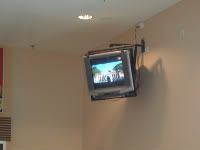
Other than the flight status monitor, terminal 2 in Kota Kinabalu certainly did not provide much in the way of entertainment or diversions to while away the time. If one was hungry, there was a solitary restaurant in the waiting area, however, their catchy slogan, "Get Filled and Feel It With Us," certainly made me somewhat hesitant about digging in. I don't know about you, but I definitely prefer not to feel my food after eating it.
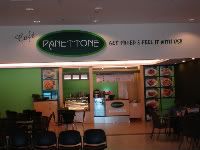
Now that I was flying to Kuching again, I thought that it would be nice if I could arrive while it was still daylight this time around. I was looking forward to relaxing in the club lounge at the Hilton Kuching and watching the sun set as I enjoyed some munchies and a cocktail or few. I figured that my chances for an on time arrival were fairly decent today because Air Asia has many more flights from Kuala Lumpur to Kuching than they have to Kota Kinabalu plus the former is a much quicker trip as well.
But it was not to be. I arrived in the low cost carrier terminal after a 50 minute ride on the yellow Aerobus from KL Sentral for 8 ringgit, found my flight listed on the arrivals board, cleared baggage prescreening and then dutifully waited in line at the counter for check-in for my flight to commence. And then waited some more. It was less than two hours before scheduled departure and check-in should have long since started but I still saw no sign of life behind the counter. When I sought out some supervisory personnel to find out the score, I was told, "Your flight has been retimed," in a very dispassionate tone.
I knew enough not to waste any more time asking additional questions so I dutifully waited for the counter to open, which it did eventually. Once through security and inside the waiting area, I discovered that my flight had been retimed once again, which I managed to figure out for myself without requiring any additional assistance from Air Asia personnel. I knew when it was time to board, because, suddenly, all of the other passengers arose from their respective seats and formed a long line at the gate, as if they had received a secret signal for which I was completely unaware. The bottom line is that we wound up landing in Kuching at about 5:30 PM, much later than I had hoped to arrive but still allowing a little time in which to enjoy the lounge for a while.
Upon arriving at the Hilton, I was whisked up to the club lounge on the twelfth floor, where I was greeted warmly by Rashid and several of the other club floor concierges, who had remembered me from my brief visit in November. Whatís most fascinating is that they remembered me but still permitted me to return.
The Hilton had treated me well during my earlier trip but they treated me exceptionally well this time around. On each of my four one-night stays, I was provided with a full suite on one of the upper floors and on my last night I was assigned a large suite with expansive views in both directions. The club lounge was available in the evening for snacks and cocktails and in the morning for a very nice and expansive breakfast. Two computers were provided from which I could check email and catch up on Flyertalk.
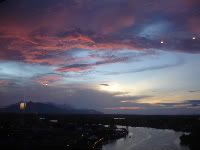
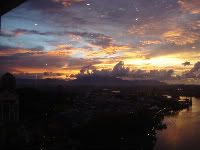
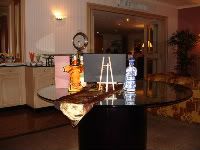
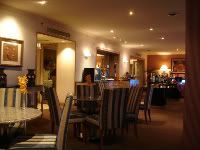
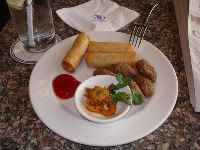

During my earlier stay at the Hilton, I often found the lounge in the evening to be very smoky and frequently inhabited by loud and boisterous guests, some acting as if it was their own private club. This was not the case this time around and I was, in fact, advised by Rashid that smoking in the lounge is no longer permitted in the morning at all. As a matter of fact, I was not disturbed by smoking at any time of day so I am not sure whether smoking has been banned entirely or whether everyone had just decided to kick the habit.
Rashid was very friendly and personable and I spoke with him quite a bit during my stay. I showed him the map of Sarawak that I had picked up in Kuala Lumpur and he said that it was much nicer than anything they currently had on the club floor. I told him that I planned to walk around town for a while in the morning and promised that I would try to obtain another copy of the map for him. I then mentioned that I had just purchased a new quad band cell phone and asked him where would be the best place for me to obtain a Malaysian SIM. It turned out that he was able to loan me a spare SIM so all I would need to do is get it topped off with some additional ringgits and I would be all set.
Kuching is the Catís Meow
The word Kuching literally translates into "Cat City" in Malay but there is significant debate about how it earned its moniker. Some people believe that when the Rajah James Brooke first sailed into the settlement on the Sungai Sarawak, he asked about the name of the town but a local guide thought he was pointing towards a nearby cat. Other people have suggested that the area was first settled by Indian traders and believe that Kuching is named after the southern Indian city of Chochin. Still others have hypothesized that it was named after the catís eye fruit, known as "mata kucing" in the local lingo, that once grew abundantly along the river banks.
No matter what the origins of the name, it is quite clear that the "Cat City" has been around for a very long time, as can be easily seen in this recently unearthed ancient photograph.

Today, the profound obsession of the cityís denizens with the domestic cat is abundantly clear everywhere one walks.
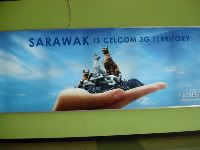

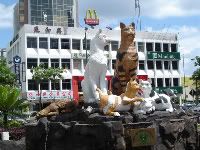
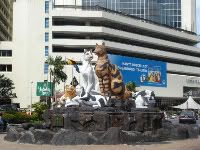
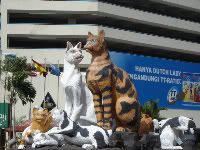
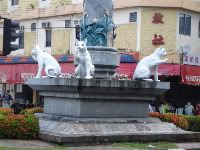
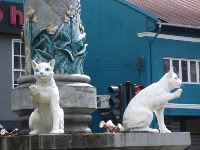
To me, the most interesting question is where did all those furry felines come from in the first place? I could not help but notice that there were very few monkeys to be seen wandering around the streets of Kuching, in contrast with some of my earlier forays in Kuala Lumpur and Bali. At first, I thought that the paucity of monkeys might be due to my recent deployment of this amazing new product:

But upon further scrutiny, the real story turned out to be much more complicated than that. From very painstaking and exhaustive scientific research that spanned a lengthy period well in excess of five minutes, I came to conclude that the absence of monkeys in Kuching must be due to the devout worship of cats by its citizenry. I would hypothesize that once upon a time, the city of Kuching was crawling with evil monkeys but had no cats whatsoever. One day, Eleanor Abernathy flew in from Springfield in order to celebrate her graduation from Harvard Medical School and Yale Law school at the ripe old age of 24. She brought along with her a couple of her feline friends and, somehow, a few of them got loose:


At first the monkeys and the cats seemed to get along with one another reasonably well.

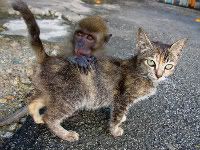
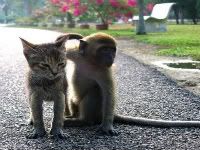





But soon enough, the monkeys turned on the cats. Why? Because thatís what monkeys do.





It was quite a catastrophe but soon enough the cats began to fight back, raising a huge cat army to battle the evil monkeys.
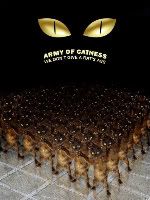
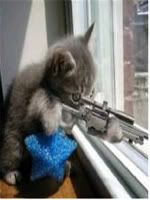



If for no other reason, the cats ultimately conquered the monkeys by virtue of sheer numbers given that its common knowledge that, just like tribbles, many cats appear to be born pregnant.
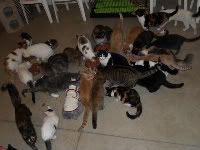
And thatís the categorically true story of why the city of Kuching has very few monkeys and now worships the domestic cat. Once they took over, the cats at first proved to be quite courteous, refined and well mannered.

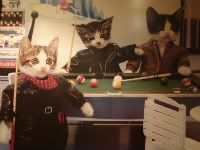

But all is not catnip and kitty litter in the cat city.







Some people believe that the cats are getting a little out of hand and are beginning to cause a significant problem of their own. But thatís a "tail" for another time.





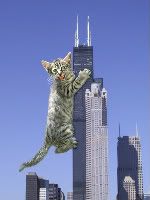
Personally, I cannot help but wonder how things would have turned out had a Crazy Dog Lady visited Kuching instead of Eleanor Abernathy so many years ago. Perhaps the city would have been named anjing and giant dog icons would now be guarding its buildings, streets and alleyways. One thing is for sure -- there is certainly no doubt that the majority of dogs would have proved to be significantly more genteel than most cats:

The Kuching Cat Walk
I had dined in the club lounge for breakfast during my previous visit and found the food to be excellent, providing an abundant and diverse buffet of good quality fare.
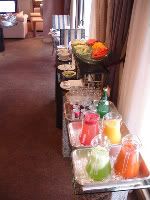
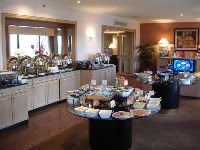
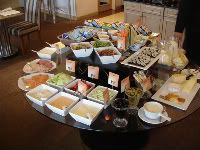
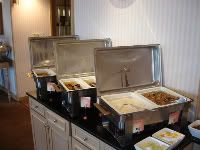
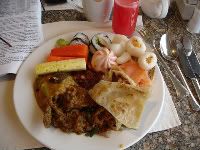
However, this time around, I opted for breakfast in the restaurant instead because it opened much earlier than the lounge and I had already been awake for quite a while, courtesy of the 16 hour time difference. The choices available in the restaurant were very extensive and included Malaysian, Indian, Chinese, Japanese and western cuisines. In addition to the obligatory chefs cooking a wide variety of omelettes and other egg dishes, there was even a station brewing up fresh Sarawak Laksa, accompanied by its usual cast of condiments.
There was an assortment of fresh juices that could be squeezed to order but I was especially intrigued by the sugar "can" juice, figuring that a beverage such as this must be packed with a huge amount of minerals. I admit that I didnít actually see them squeeze the juice but I would imagine that the freshly harvested cans must be especially difficult to blend. Under the circumstances, I wouldnít be at all surprised if they had to avail themselves of the services of Blendtec in order to accomplish the task.
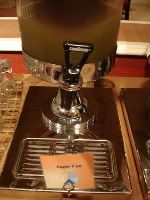
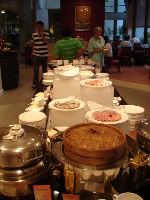
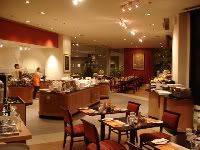
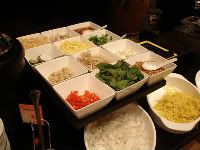
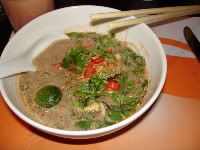
After breakfast, I set about on my walk through Kuching, already quite warm and steamy by 8:30 in the morning. I walked along the waterfront for a while, observing sampans as they ferried passengers across the Sungai Sarawak for 30 sen each. I spent a few minutes viewing Fort Margherita, built by the White Rajah, Charles Brooke in 1879 and named after his wife, Margaret. As I studied the White Castle-like edifice, I could not help but wonder whether they served hamburgers inside. Perhaps accompanied by an ice cold margarita?
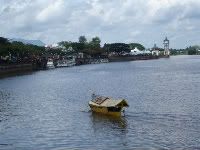
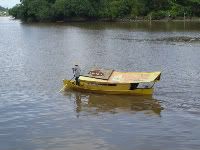
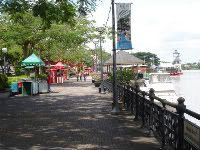

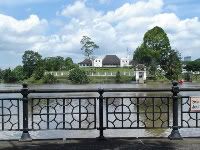
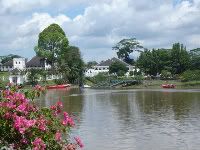
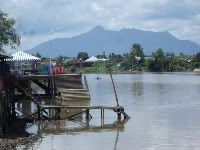

Dominating the vista on the opposing river bank, there was no way to miss the massive futuristic megastructure that will be home to the new Sarawak State Legislative Assembly (Dewan Undangan Negeri) once its completed sometime later this year.
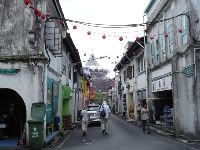
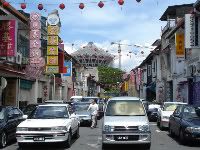
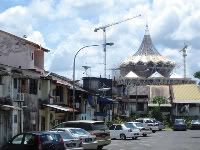

At the far reaches of my stroll along the Kuching riverside promenade, I soon found myself on Jalan Gambier, a street comprised of a dense concentration of colorful and fragrant spice shops and an even more profoundly odiferous wet market. The complex scents wafting from the wet market constituted a very unique bouquet, composed of equal mixtures of aging fresh fish, pungent sun dried fish and the ubiquitous belacan, the fermented shrimp paste that provides such an important foundation to much Malaysian cuisine.
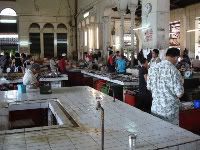
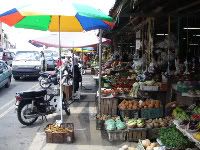

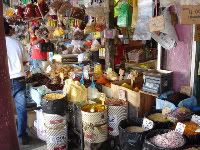
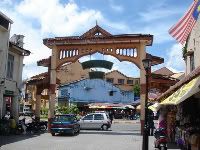
One block inland is Jalan India, the heart of "Little India," a pedestrian mall that turned out to be much more Chinese than it was Indian. My wanderings then took me near the Kuchinq Mosque and Chinatown.
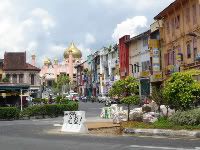
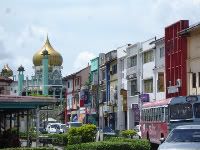
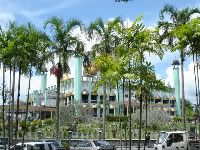
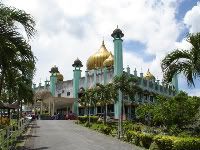
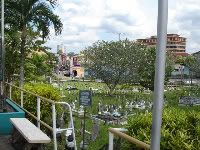
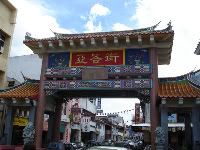
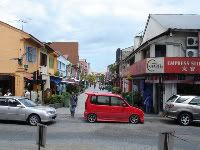
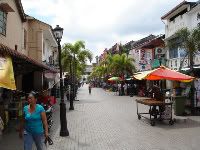
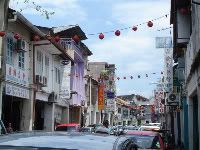
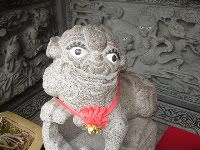
I then continued my journey away from the waterfront and wandered amongst the busy streets and alleyways for another hour or so. By then I was feeling quite ready for a break from the heat.
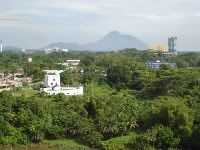
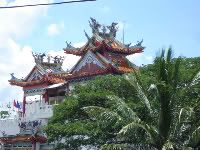
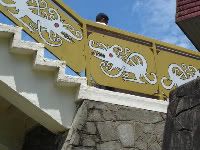

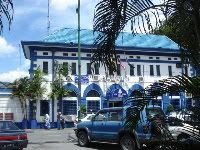
I had spent all morning prowling around the cat city and figured it was time to start heading back and cool off at the Hilton for a bit. On my return journey to the hotel, my wanderings brought me within the vicinity of the old courthouse, a white colonial style building nestled in a courtyard adjacent to the Little Lebanon restaurant. The sign in front of the building indicated that it was the Sarawak Visitors Information Centre so, given that I was indeed a visitor seeking information about Sarawak, I figured this was the place for me.
As soon as I walked in the door, I was greeted by Angela. I told her that I had been to Kuching for a couple of days last fall and explained that my main interests during this visit were mostly wildlife and scenery. We reviewed some of the national parks in the area and she provided me with a comprehensive bus and transportation schedule so that I would be able to get to the parks on my own in case I could not arrange a tour and guide.
Just as I was about to leave the visitors centre, I remembered that I had promised to pick up a copy of the Sarawak map for Rashid at the Hilton. I showed Angela the map, explaining that I had picked it up in late February when I was visiting Kuala Lumpur. As we talked about the Malaysia Airlines Travel Fair, it turned out that Angela was the very same person who had given me the map in the first place! She showed me a detailed travel schedule that indicated that she had indeed been assigned to staff the travel fair on those dates.
Angela went on to explain that her husband is also in the tourism business and was, in fact, manning the fort in Kuala Lumpur right now. She mentioned that a few years ago, he was actually assigned to Los Angeles but was forced to leave the United States when our government decided that everyone living in a whole host of countries, including Malaysia, were terrorists!

I spoke with Angela for a bit longer but I noticed that other visitors were beginning to amass in the waiting area. So we decided that we would hook up later that afternoon for some additional conversation and a brief ride around Kuching. I thanked her for her help and returned, somewhat reluctantly, to the hot and steamy street and began my long torrid walk back to the Hilton. Once in the vicinity of the hotel, I dashed into a mall across the street, where I purchased 20 ringgits worth of time for my cell phone. I then scurried back to the Hilton club lounge to give Rashid his map and to cool off for a bit before checking out. I was planning to spend that night at the Crowne Plaza, part of a mattress run crafted to maximize my Hilton stays while in Kuching.

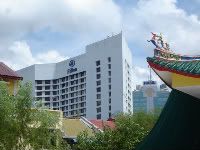
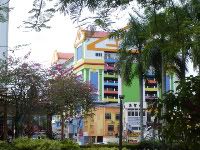
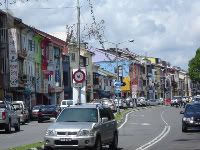

After Angela met me at the Crowne Plaza later that afternoon, we picked up two visitors from Ireland, who had just arrived in Kuching and were also the beneficiaries of her hospitality. After driving around for a while, all four of us meandered over to a guest house operated by Angelaís aunty. We were soon joined by some other visitors and all of us talked for a while, our dialog suitably lubricated by generous supplies of tuak. As it grew dark, Angela and I drove into Chinatown, where I enjoyed a cup of coffee and Angela sipped on an unusual wheat based beverage. Nearby, in an adjacent alleyway, I noticed that some tables and chairs had been gathered together and I watched as a Kung Fu was projected on the side of a building.
As we were wrapping up, I asked Angela if she wanted to get a bite to eat. She replied that she was heading to the airport that evening in order to meet a couple of dozen VIPs that were flying in from Indonesia. She added that If I wanted to hook up later, the whole gang would be assembled at Top Spot Seafood Court, perhaps by 9:30 PM, where a set meal had already been ordered for everybody. Angela said that the entire entourage would be flying in on Air Asia, which had just established a new route from Kuching to Jakarta.
According to the official press release, Tony Fernandes, the CEO of Air Asia would be flying in the next day. Given my own recent experiences with the timing and timeliness of Air Asia flights, I asked Angela how she could be so sure that they wouldnít be late. "They wonít be late," she replied with an air of great confidence. She said that the regional head of Air Asiaís Kuching office will be there and this event is just too important for them to allow that to happen.
I had visited Top Spot Seafood Court previously and found it to be a great place to obtain fresh seafood at fairly reasonable prices. Located on the roof of a six story parking garage, the open air seafood court is comprised of an assemblage of individual hawkers who aggressively compete for the attention of anyone walking within their vicinity. I had always lamented the fact that, as a visitor dining alone, I was unable to sample the myriad varieties of delicious looking offerings that danced around my table on the way to the gaping mouths of other hungry diners. Angelaís offer was just too tasty to refuse so I said I would be there.
Top Cat at the Top Spot
When I emerged onto the roof of the Pelita Car Park a little before 9:30 PM, I was immediately surrounded by hordes of seafood purveyors, all tenaciously hawking their respective establishments that lined the perimeter of the food court. I fled to a table well away from the fray and gave Angela a quick call to find out her ETA. As she had emphatically predicted, the Air Asia flight from Jakarta had landed on time, and they were currently finalizing arrangements at the Hilton before heading over for dinner. About 20 minutes later, the Indonesian entourage marched into the seafood court and were escorted to two large tables managed by stall # 25, the very popular Bukit Mata Seafood Centre.

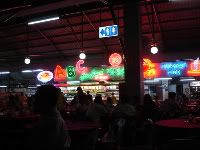
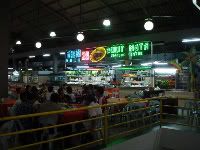
I settled into a smaller table nearby, where I was soon joined by Angela, the driver of the Indonesian VIPs plus a couple of other staff members. Their meal had already been preordered but Angela accompanied me to the front counter, where she helped me decide between a bewildering away of fish from which to choose my dinner.
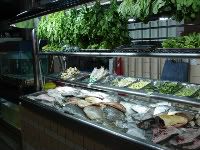

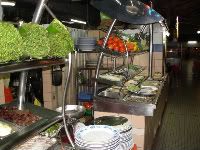
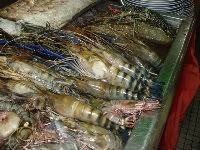

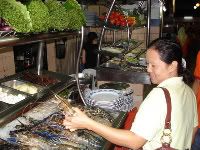

Once settled back at my table, I was able to share some of the other goodies, including tom yum soup, jungle ferns prepared two different ways plus a couple of other dishes.
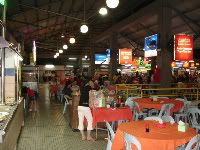
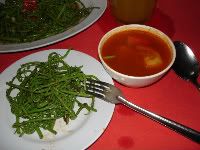
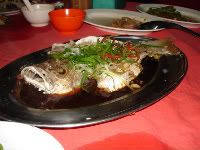
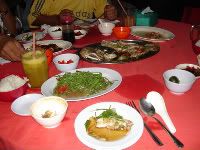
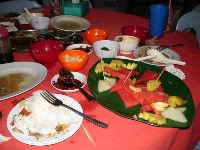
Towards the end of the meal, another fellow sat down by my table and was introduced to me by Angela as Shanmuganathan, the station manager of Air Asiaís office in Kuching. Shan told me that the official inauguration of the new Jakarta route was planned for the following day. As part of the celebration, Air Asia was looking for "a foreigner" to whom they could present an award at an important lunchtime ceremony and he invited me to receive the award. As an officially certified foreigner, I suppose I was fully qualified for the tribute. Not only that, I had actually flown Air Asia and had done so more than once. And lived.
This was certainly an exceptionally tempting honor and, just to add more of an incentive, Angela said they would also give me a free hat! ^ Given that monkeys seem to keep eating my hats, how could I refuse? The problem was that I had already booked and paid for a trip to Bako National Park that was scheduled to leave early the next morning and I would be gone for the entire day. So, I sadly had to turn down the prestigious award, and most important of all, the free hat. Shan was very understanding and gracious and told me that I should let him know if I ever needed anything.
Shan was very understanding and gracious and told me that I should let him know if I ever needed anything.
Shortly thereafter, the Indonesian entourage arose from their tables and gathered together for the return drive back to the Hilton. I stayed behind a while longer picking at the contents of an enormous fruit platter, contemplating honors, awards and hats that were not to be.
Next Chapter: Baked Bako with Belacan Ö
In order to appreciate and understand much of this tale, you must successfully pass this very complicated multiple choice test:
What is the most common phrase enunciated by Air Asia personnel:
A) Please take your assigned seat.
B) Would you like to have some complimentary water?
C) You may carry onboard as much baggage you wish.
D) Your upgrade has cleared.
E) Your flight has been retimed.
If you answered A, B, C or D, then you might as well just stay home Ė your intra-Asian travels will be fraught with nothing but surprise, despair and disappointment. If you answered "E," then you wonít be surprised, though you might still have your fair share of despair and disappointment.
This was the second time I was flying to Kuching on Air Asia. The first time was in early November and when I showed up at terminal 2 in Kota Kinabalu, I was told, in a very matter of fact tone, that my flight had been "retimed." Whether or not this phraseology is any more polite than the somewhat more familiar terminology, "delayed," is open to debate but the full affects and consequences are all pretty much the same. In the previous instance, the retiming was initially a mere 20 minutes or so but it didnít take very long for that to morph into a full five hours!

From my long and tiring experience as a UA traveler, I can certainly attest to the fact that Air Asia does not hold a monopoly on flight delays. However, what really sets them apart, in my humble opinion, is their abject unwillingness to provide any flight status updates whatsoever and to act acutely surprised whenever passengers ask gate personnel whether or not they are likely to actually get to their destination that day.
In the case of the Kota Kinabalu trip, the flight had already been "retimed" for a full two hours and none of the staff could agree on from where the plane was actually flying and whether or not it had already departed. Over the next couple of hours, I was told, in turn, that "it was on its way from Kuala Lumpur," followed by "it had not yet left Kuala Lumpur" and finally, "it was flying in from Vietnam." The correct answer turned out to be, "none of the above;" the flight was coming from Shenzhen and it had not yet departed at the time that I framed my original query.
The information gleaned from the flight status monitor proved to be quite interesting as well, especially when I looked up at one point and noticed that it was actually playing a Bollywood movie.
 I recall thinking to myself at the time that the information provided by the Bollywood movie on the flight status monitor was no less accurate than any of the flight information that I had gleaned from my discussions with the Air Asia personnel. Perhaps it was even a little more accurate.
I recall thinking to myself at the time that the information provided by the Bollywood movie on the flight status monitor was no less accurate than any of the flight information that I had gleaned from my discussions with the Air Asia personnel. Perhaps it was even a little more accurate. 

Other than the flight status monitor, terminal 2 in Kota Kinabalu certainly did not provide much in the way of entertainment or diversions to while away the time. If one was hungry, there was a solitary restaurant in the waiting area, however, their catchy slogan, "Get Filled and Feel It With Us," certainly made me somewhat hesitant about digging in. I don't know about you, but I definitely prefer not to feel my food after eating it.


Now that I was flying to Kuching again, I thought that it would be nice if I could arrive while it was still daylight this time around. I was looking forward to relaxing in the club lounge at the Hilton Kuching and watching the sun set as I enjoyed some munchies and a cocktail or few. I figured that my chances for an on time arrival were fairly decent today because Air Asia has many more flights from Kuala Lumpur to Kuching than they have to Kota Kinabalu plus the former is a much quicker trip as well.
But it was not to be. I arrived in the low cost carrier terminal after a 50 minute ride on the yellow Aerobus from KL Sentral for 8 ringgit, found my flight listed on the arrivals board, cleared baggage prescreening and then dutifully waited in line at the counter for check-in for my flight to commence. And then waited some more. It was less than two hours before scheduled departure and check-in should have long since started but I still saw no sign of life behind the counter. When I sought out some supervisory personnel to find out the score, I was told, "Your flight has been retimed," in a very dispassionate tone.
I knew enough not to waste any more time asking additional questions so I dutifully waited for the counter to open, which it did eventually. Once through security and inside the waiting area, I discovered that my flight had been retimed once again, which I managed to figure out for myself without requiring any additional assistance from Air Asia personnel. I knew when it was time to board, because, suddenly, all of the other passengers arose from their respective seats and formed a long line at the gate, as if they had received a secret signal for which I was completely unaware. The bottom line is that we wound up landing in Kuching at about 5:30 PM, much later than I had hoped to arrive but still allowing a little time in which to enjoy the lounge for a while.
Upon arriving at the Hilton, I was whisked up to the club lounge on the twelfth floor, where I was greeted warmly by Rashid and several of the other club floor concierges, who had remembered me from my brief visit in November. Whatís most fascinating is that they remembered me but still permitted me to return.

The Hilton had treated me well during my earlier trip but they treated me exceptionally well this time around. On each of my four one-night stays, I was provided with a full suite on one of the upper floors and on my last night I was assigned a large suite with expansive views in both directions. The club lounge was available in the evening for snacks and cocktails and in the morning for a very nice and expansive breakfast. Two computers were provided from which I could check email and catch up on Flyertalk.






During my earlier stay at the Hilton, I often found the lounge in the evening to be very smoky and frequently inhabited by loud and boisterous guests, some acting as if it was their own private club. This was not the case this time around and I was, in fact, advised by Rashid that smoking in the lounge is no longer permitted in the morning at all. As a matter of fact, I was not disturbed by smoking at any time of day so I am not sure whether smoking has been banned entirely or whether everyone had just decided to kick the habit.
Rashid was very friendly and personable and I spoke with him quite a bit during my stay. I showed him the map of Sarawak that I had picked up in Kuala Lumpur and he said that it was much nicer than anything they currently had on the club floor. I told him that I planned to walk around town for a while in the morning and promised that I would try to obtain another copy of the map for him. I then mentioned that I had just purchased a new quad band cell phone and asked him where would be the best place for me to obtain a Malaysian SIM. It turned out that he was able to loan me a spare SIM so all I would need to do is get it topped off with some additional ringgits and I would be all set.
Kuching is the Catís Meow
The word Kuching literally translates into "Cat City" in Malay but there is significant debate about how it earned its moniker. Some people believe that when the Rajah James Brooke first sailed into the settlement on the Sungai Sarawak, he asked about the name of the town but a local guide thought he was pointing towards a nearby cat. Other people have suggested that the area was first settled by Indian traders and believe that Kuching is named after the southern Indian city of Chochin. Still others have hypothesized that it was named after the catís eye fruit, known as "mata kucing" in the local lingo, that once grew abundantly along the river banks.
No matter what the origins of the name, it is quite clear that the "Cat City" has been around for a very long time, as can be easily seen in this recently unearthed ancient photograph.

Today, the profound obsession of the cityís denizens with the domestic cat is abundantly clear everywhere one walks.







To me, the most interesting question is where did all those furry felines come from in the first place? I could not help but notice that there were very few monkeys to be seen wandering around the streets of Kuching, in contrast with some of my earlier forays in Kuala Lumpur and Bali. At first, I thought that the paucity of monkeys might be due to my recent deployment of this amazing new product:

But upon further scrutiny, the real story turned out to be much more complicated than that. From very painstaking and exhaustive scientific research that spanned a lengthy period well in excess of five minutes, I came to conclude that the absence of monkeys in Kuching must be due to the devout worship of cats by its citizenry. I would hypothesize that once upon a time, the city of Kuching was crawling with evil monkeys but had no cats whatsoever. One day, Eleanor Abernathy flew in from Springfield in order to celebrate her graduation from Harvard Medical School and Yale Law school at the ripe old age of 24. She brought along with her a couple of her feline friends and, somehow, a few of them got loose:


At first the monkeys and the cats seemed to get along with one another reasonably well.








But soon enough, the monkeys turned on the cats. Why? Because thatís what monkeys do.





It was quite a catastrophe but soon enough the cats began to fight back, raising a huge cat army to battle the evil monkeys.





If for no other reason, the cats ultimately conquered the monkeys by virtue of sheer numbers given that its common knowledge that, just like tribbles, many cats appear to be born pregnant.

And thatís the categorically true story of why the city of Kuching has very few monkeys and now worships the domestic cat. Once they took over, the cats at first proved to be quite courteous, refined and well mannered.



But all is not catnip and kitty litter in the cat city.







Some people believe that the cats are getting a little out of hand and are beginning to cause a significant problem of their own. But thatís a "tail" for another time.






Personally, I cannot help but wonder how things would have turned out had a Crazy Dog Lady visited Kuching instead of Eleanor Abernathy so many years ago. Perhaps the city would have been named anjing and giant dog icons would now be guarding its buildings, streets and alleyways. One thing is for sure -- there is certainly no doubt that the majority of dogs would have proved to be significantly more genteel than most cats:

The Kuching Cat Walk
I had dined in the club lounge for breakfast during my previous visit and found the food to be excellent, providing an abundant and diverse buffet of good quality fare.





However, this time around, I opted for breakfast in the restaurant instead because it opened much earlier than the lounge and I had already been awake for quite a while, courtesy of the 16 hour time difference. The choices available in the restaurant were very extensive and included Malaysian, Indian, Chinese, Japanese and western cuisines. In addition to the obligatory chefs cooking a wide variety of omelettes and other egg dishes, there was even a station brewing up fresh Sarawak Laksa, accompanied by its usual cast of condiments.
There was an assortment of fresh juices that could be squeezed to order but I was especially intrigued by the sugar "can" juice, figuring that a beverage such as this must be packed with a huge amount of minerals. I admit that I didnít actually see them squeeze the juice but I would imagine that the freshly harvested cans must be especially difficult to blend. Under the circumstances, I wouldnít be at all surprised if they had to avail themselves of the services of Blendtec in order to accomplish the task.






After breakfast, I set about on my walk through Kuching, already quite warm and steamy by 8:30 in the morning. I walked along the waterfront for a while, observing sampans as they ferried passengers across the Sungai Sarawak for 30 sen each. I spent a few minutes viewing Fort Margherita, built by the White Rajah, Charles Brooke in 1879 and named after his wife, Margaret. As I studied the White Castle-like edifice, I could not help but wonder whether they served hamburgers inside. Perhaps accompanied by an ice cold margarita?








Dominating the vista on the opposing river bank, there was no way to miss the massive futuristic megastructure that will be home to the new Sarawak State Legislative Assembly (Dewan Undangan Negeri) once its completed sometime later this year.




At the far reaches of my stroll along the Kuching riverside promenade, I soon found myself on Jalan Gambier, a street comprised of a dense concentration of colorful and fragrant spice shops and an even more profoundly odiferous wet market. The complex scents wafting from the wet market constituted a very unique bouquet, composed of equal mixtures of aging fresh fish, pungent sun dried fish and the ubiquitous belacan, the fermented shrimp paste that provides such an important foundation to much Malaysian cuisine.





One block inland is Jalan India, the heart of "Little India," a pedestrian mall that turned out to be much more Chinese than it was Indian. My wanderings then took me near the Kuchinq Mosque and Chinatown.










I then continued my journey away from the waterfront and wandered amongst the busy streets and alleyways for another hour or so. By then I was feeling quite ready for a break from the heat.





I had spent all morning prowling around the cat city and figured it was time to start heading back and cool off at the Hilton for a bit. On my return journey to the hotel, my wanderings brought me within the vicinity of the old courthouse, a white colonial style building nestled in a courtyard adjacent to the Little Lebanon restaurant. The sign in front of the building indicated that it was the Sarawak Visitors Information Centre so, given that I was indeed a visitor seeking information about Sarawak, I figured this was the place for me.
As soon as I walked in the door, I was greeted by Angela. I told her that I had been to Kuching for a couple of days last fall and explained that my main interests during this visit were mostly wildlife and scenery. We reviewed some of the national parks in the area and she provided me with a comprehensive bus and transportation schedule so that I would be able to get to the parks on my own in case I could not arrange a tour and guide.
Just as I was about to leave the visitors centre, I remembered that I had promised to pick up a copy of the Sarawak map for Rashid at the Hilton. I showed Angela the map, explaining that I had picked it up in late February when I was visiting Kuala Lumpur. As we talked about the Malaysia Airlines Travel Fair, it turned out that Angela was the very same person who had given me the map in the first place! She showed me a detailed travel schedule that indicated that she had indeed been assigned to staff the travel fair on those dates.
Angela went on to explain that her husband is also in the tourism business and was, in fact, manning the fort in Kuala Lumpur right now. She mentioned that a few years ago, he was actually assigned to Los Angeles but was forced to leave the United States when our government decided that everyone living in a whole host of countries, including Malaysia, were terrorists!


I spoke with Angela for a bit longer but I noticed that other visitors were beginning to amass in the waiting area. So we decided that we would hook up later that afternoon for some additional conversation and a brief ride around Kuching. I thanked her for her help and returned, somewhat reluctantly, to the hot and steamy street and began my long torrid walk back to the Hilton. Once in the vicinity of the hotel, I dashed into a mall across the street, where I purchased 20 ringgits worth of time for my cell phone. I then scurried back to the Hilton club lounge to give Rashid his map and to cool off for a bit before checking out. I was planning to spend that night at the Crowne Plaza, part of a mattress run crafted to maximize my Hilton stays while in Kuching.





After Angela met me at the Crowne Plaza later that afternoon, we picked up two visitors from Ireland, who had just arrived in Kuching and were also the beneficiaries of her hospitality. After driving around for a while, all four of us meandered over to a guest house operated by Angelaís aunty. We were soon joined by some other visitors and all of us talked for a while, our dialog suitably lubricated by generous supplies of tuak. As it grew dark, Angela and I drove into Chinatown, where I enjoyed a cup of coffee and Angela sipped on an unusual wheat based beverage. Nearby, in an adjacent alleyway, I noticed that some tables and chairs had been gathered together and I watched as a Kung Fu was projected on the side of a building.
As we were wrapping up, I asked Angela if she wanted to get a bite to eat. She replied that she was heading to the airport that evening in order to meet a couple of dozen VIPs that were flying in from Indonesia. She added that If I wanted to hook up later, the whole gang would be assembled at Top Spot Seafood Court, perhaps by 9:30 PM, where a set meal had already been ordered for everybody. Angela said that the entire entourage would be flying in on Air Asia, which had just established a new route from Kuching to Jakarta.
According to the official press release, Tony Fernandes, the CEO of Air Asia would be flying in the next day. Given my own recent experiences with the timing and timeliness of Air Asia flights, I asked Angela how she could be so sure that they wouldnít be late. "They wonít be late," she replied with an air of great confidence. She said that the regional head of Air Asiaís Kuching office will be there and this event is just too important for them to allow that to happen.
I had visited Top Spot Seafood Court previously and found it to be a great place to obtain fresh seafood at fairly reasonable prices. Located on the roof of a six story parking garage, the open air seafood court is comprised of an assemblage of individual hawkers who aggressively compete for the attention of anyone walking within their vicinity. I had always lamented the fact that, as a visitor dining alone, I was unable to sample the myriad varieties of delicious looking offerings that danced around my table on the way to the gaping mouths of other hungry diners. Angelaís offer was just too tasty to refuse so I said I would be there.
Top Cat at the Top Spot
When I emerged onto the roof of the Pelita Car Park a little before 9:30 PM, I was immediately surrounded by hordes of seafood purveyors, all tenaciously hawking their respective establishments that lined the perimeter of the food court. I fled to a table well away from the fray and gave Angela a quick call to find out her ETA. As she had emphatically predicted, the Air Asia flight from Jakarta had landed on time, and they were currently finalizing arrangements at the Hilton before heading over for dinner. About 20 minutes later, the Indonesian entourage marched into the seafood court and were escorted to two large tables managed by stall # 25, the very popular Bukit Mata Seafood Centre.



I settled into a smaller table nearby, where I was soon joined by Angela, the driver of the Indonesian VIPs plus a couple of other staff members. Their meal had already been preordered but Angela accompanied me to the front counter, where she helped me decide between a bewildering away of fish from which to choose my dinner.







Once settled back at my table, I was able to share some of the other goodies, including tom yum soup, jungle ferns prepared two different ways plus a couple of other dishes.





Towards the end of the meal, another fellow sat down by my table and was introduced to me by Angela as Shanmuganathan, the station manager of Air Asiaís office in Kuching. Shan told me that the official inauguration of the new Jakarta route was planned for the following day. As part of the celebration, Air Asia was looking for "a foreigner" to whom they could present an award at an important lunchtime ceremony and he invited me to receive the award. As an officially certified foreigner, I suppose I was fully qualified for the tribute. Not only that, I had actually flown Air Asia and had done so more than once. And lived.
This was certainly an exceptionally tempting honor and, just to add more of an incentive, Angela said they would also give me a free hat! ^ Given that monkeys seem to keep eating my hats, how could I refuse? The problem was that I had already booked and paid for a trip to Bako National Park that was scheduled to leave early the next morning and I would be gone for the entire day. So, I sadly had to turn down the prestigious award, and most important of all, the free hat.
 Shan was very understanding and gracious and told me that I should let him know if I ever needed anything.
Shan was very understanding and gracious and told me that I should let him know if I ever needed anything.Shortly thereafter, the Indonesian entourage arose from their tables and gathered together for the return drive back to the Hilton. I stayed behind a while longer picking at the contents of an enormous fruit platter, contemplating honors, awards and hats that were not to be.
Next Chapter: Baked Bako with Belacan Ö
Last edited by LarryU; May 17, 2008 at 12:59 pm
#8
Original Poster
Join Date: Feb 2000
Location: Lake Oswego, OR
Programs: UA 1K 2MM, Marriott Lifetime Platinum, Hilton Diamond
Posts: 3,202
Baked Bako with Belacan
Nosing Around the Jungle With Proboscis Monkeys
Bako National Park spans an area of 27 sq km and is situated at the tip of the Muara Tebas peninsula that juts out into the South China Sea. The park is an ecological treasure trove, comprised of seven unique ecosystems and 25 distinct vegetation types, representing nearly every species of plant found within Borneo. It is also an area of great natural beauty, its massive steep cliffs weathered over millions of years into a striking assortment of beautiful sea stacks, rugged arches and precipitous promontories.
From Kuching, one can take the Petrajaya bus No.6, a minibus or a taxi to Kampung Bako and then sign in at the registration counter. The park is accessible only via water, so a boat needs to be chartered for the 25 minute trip over to the park headquarters. From there, private guides can be hired to facilitate a variety of possible treks.
I opted for a tour package that included pickup at the Crowne Plaza, land transport to the Bako fishing village, boat transportation to the park entrance, all admission fees, guided walks along various jungle trails, lunch and return transport to the Hilton. After a 37 km ride by van from Kuching, we arrived at the stilt village situated near the mouth of the Sungai Bako. From there, I climbed aboard a small boat along with three other passengers, a fellow from Phoenix and a couple from the UK.
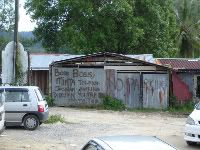
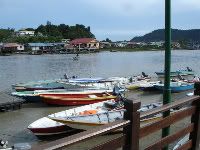
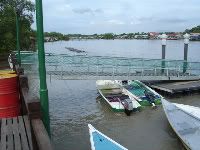
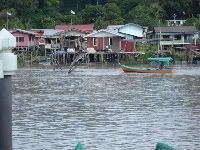
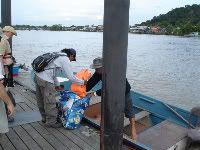
The boat ride took us from the swift currents of the turbid Sungai Bako out into the South China Sea, a coastal area frequently punctuated with permanently anchored fishing nets and populated by quite a few fishing boats.

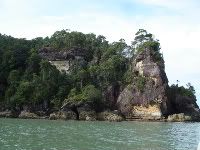
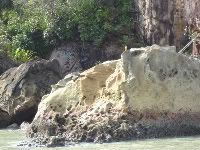
The boat pulled into an area dominated by a vast mangrove swamp, nestled within the rugged rocky coastline. After pulling up to the dock, we strolled along an elevated boardwalk for the 15 minute trek to the park headquarters. The mud flat below us was populated by thousands of mudskippers, an amphibious fish that uses its pectoral fins for propulsion and can stay out of the water for several days at a time.
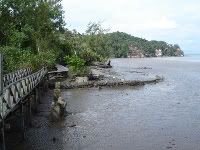
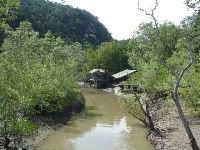

After checking in, our guide escorted the four of us up a very steep trail where grand vistas and spectacular views would await us. After a half hour of continuously inching our way over very large rocks and slippery tree roots, we stopped for a rest and were then informed that we were only a quarter of the way to the viewpoint. One of the other members of our group already had a wounded leg so after a brief powwow, we unanimously decided to branch off to a different trail whose vertical inclinations promised to be somewhat less extreme. By this point, so much sweat was poring off of me in the dense tropical humidity that my glasses kept slipping off my face and I finally opted to put them away. I figured that stumbling around with limited visibility in the jungle still beats losing my glasses permanently.
For the next hour and a half, we slogged along our new routing on the Telok Pandan Besar trail. As we proceeded on our journey, we frequently passed by large rattan trees, every surface of which was covered with fierce spines, designed to assist their growth over other plants and to deter herbivores. Our trail provided us with frequent glimpses of cliffs that descended steeply to secluded coves and beaches and to large rocky sea stacks poised imposingly along the shoreline. We rounded one sharp twist in the trail to find ourselves confronted with a very long procession of millions of ants, an immense formicid convoy with no clear beginning or end.
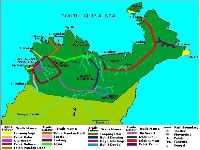
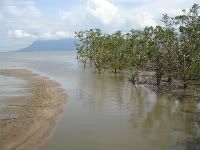
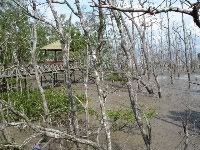

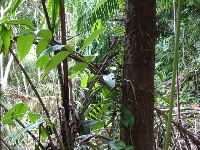
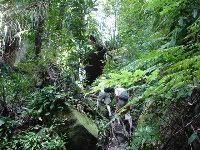

As we continued walking along the jungle trail, we heard some rustling in the leaves high above us in the canopy. We all stopped and peered upwards into the dense foliage and eventually discerned a small group of proboscis monkeys feeding amongst the tree tops.
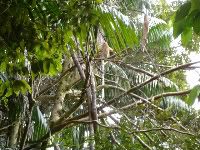

The proboscis monkeys can attain weights over 50 pounds and are endemic to the mangrove swamps and wetlands of Borneo. They are well known for their stereotypically immense nose that sometimes grows to exceed seven inches in length for males. The huge nose acts like a resonating chamber that can be used to intensify warning calls. When they become upset, they quite literally get their noses out of joint as the nose engorges with blood, thereby intensifying their warning calls.
When the Dutch began infiltrating Indonesia in the 16th century some of the locals could not help but notice the obvious similarity between their big bellies and noses with those of the proboscis monkeys. The Indonesian word for "Dutch" is belanda so, it should come as no surprise that a popular nickname for this monkey was monyet belanda, which literally means, "Dutch monkey."
My attempts to get a decent photograph of the monkeys were thwarted every time I tried. Not only were the monkeys quite high up in the treetops and partially obscured by vegetation, they kept turning away every time I snapped a picture. This was my second effort to view proboscis monkeys; the first was a couple of months ago while I was exploring the Klias river in Sabah. Those monkeys proved to be equally shy when it came to turning in my direction. So, the best that I can do under the circumstances is to offer this close-up of the secretive proboscis that I managed to dig up from deep within the zoological archives.
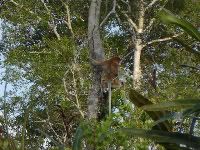
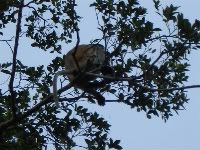
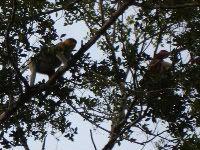


We continued on the trail for a while longer and then descended a steep incline through a cliff teaming with vegetation. The Telok Pandan Besar trail ended at a broad beach where we gathered under the roof of a small wooden hut to spend a little time relaxing, rehydrating and escaping from the relentless sun for a while. A boat was scheduled to pick us up and cart us off to our next destination and it seemed like a perfectly pleasant place to await its arrival.
When we arrived at the hut, I met an American fellow who had just flown in from Dubai with his two young sons. The boys spent much of the time scampering along the beach, clearly immune and impervious to the baking rays of the sun. Also foraging along the beach were several troops of long-tailed macaques, which, under the current circumstances, helps to explain why the animals are also often referred to as crab eating macaques in many parts of the world.
Given that I have had more than my fill of monkeys when I visited Bali the previous month, I opted to rest in the hut and stay as far away from the monkeys as I could. Besides, under the present oppressive weather conditions, the last thing I needed at this point was yet another monkey hat.
Nevertheless, none of my personal reticence precluded me from trying to coerce others to interact with the macaques. I tried everything I could think of to encourage the boys to play with the monkeys and even volunteered to donate a variety of gifts that the boys could use to lure the mischievous primates a little closer. Unfortunately, the boys ignored me completely, thus proving that they, and the monkeys, were all much smarter than I was.
After waiting for a half hour, a boat finally appeared on the distant horizon and we walked out towards it along the beach under the blazing Borneo sun. However, when we arrived at the edge of the water, it was so shallow that the boat was unable to come in close enough to pick us up. Our only possible choice was to wade out into the muddy water, nearly as hot as bath water, and then climb on board a short distance from shore.


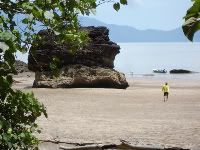
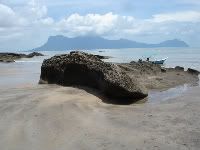
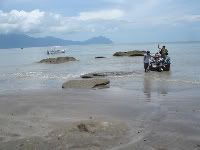
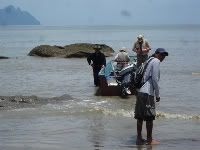
Once we were all safely aboard, the motor started right up and we soon found ourselves cruising along the coast of the peninsula. From time to time, we slowed down to inspect secluded coves and isolated beaches or came in for closer looks at rocky cliffs dripping with lush tropical vegetation. We spotted a yellow kingfisher poised on a rocky precipice and eased up to several dramatic rocky pillars, such as the famous cobra head sea stack that resides just off the shore of Teluk Pandan Kecil.
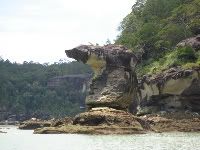
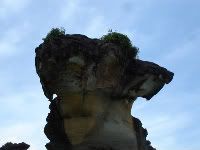
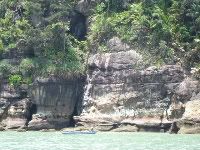

We eventually wound up back in the vicinity of the Bako park headquarters, where we endured a very long wade ashore through warm and murky mud flats. Our guide sternly warned us to watch where we were walking because catfish liked to embed themselves in the mud, exposing only their sharp dorsal spines to those unlucky enough to step on them. Given that none of us could see anything at all through the intense turbidity of the water, I am not at all sure what we could have done to avoid them. As we trundled ashore, I noticed the phrase "1492 miles" inscribed on the guideís sweatshirt and asked him what it meant. He responded that he didnít know; he just liked the shirt.

We finally ascended to the boardwalk and all of us were, fortunately, catfish free. Within the administrative complex at Teluk Assam, we were led to a small canteen where we were invited to partake in a lunch buffet. The rule was that we could make only one visit to the buffet but we could take as much as we wanted. As a result of the enormous breakfast buffet that I had enjoyed several hours ago in Kuching, I as not especially hungry.
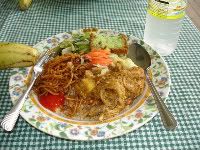
But I recall reading about of group of Taiwanese engineering students who came up with a clever way to maximize their return on investment when faced with similar restrictions at a buffet in Taipei.
When I stepped outside after lunch, I encountered a large monitor lizard resting in a wet area near the corner of the building.

A few feet away from the giant lizard, I was confronted by a huge bearded pig who had just come sauntering by to see what he could scavenge. By the time I grabbed my camera, only his rump was still in the frame. So, for educational purposes, I have provided some stock photos so you can see what he looked like:


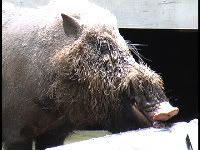


As the wild boar slogged off into the trees, we walked along a small trail that brought us alongside a variety of snakes, including a painted bronzeback and the highly venomous green pit viper, who was using its prehensile tail to coil tightly against a large tree.

As we continued our walk, we ran into a pair of French visitors, who reported that they had seen a troop of silver leaf monkeys about 20 minutes further down the trail. Quiet and docile creatures, the silver leaf monkeys resemble the evil long-tailed macaques in all but temperament so I asked the French couple if they were absolutely sure that the silver leafs they had spotted were not really long-tailed macaques.
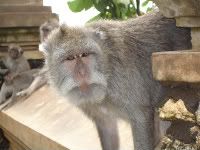

The couple were quite adamant about the identity of the primates so our group opted for a 20 minute detour so we could get a closer look. As we began to ascend a steep hill, the fellow from Phoenix decided to stay behind because his bandaged leg was beginning to hurt. After mulling it over a bit, I chose to keep him company because my gut instinct told me that the monkeys were probably just macaques and I had already surpassed my quota of long-tailed macaque interactions for the year. So I asked the other members of our group to send one of the monkeys back with a signed note saying that they were not macaques, sort of like a carrier monkey. As I had suspected, no monkeys returned with a note; my instincts that the whole thing was all a wild monkey chase turned out to be correct.
As we continued along on our originally planned itinerary, we walked along the Telok Paku trail and eventually arrived at another elevated boardwalk. At the terminus of this very long walkway, we finally descended onto the ground below, which had not yet made up its mind whether it wanted to be a sandy beach or a mud flat. Our guide led us along the edge of some very steep cliffs where the ground was a little more solid and we then found ourselves in a very narrow cave. Squeezing through the cave was a very tight fit but we eventually emerged into a secluded cove on the other side. In this area, the rocks of the cliff face were carpeted with dense clusters of carnivorous pitcher plants, some of which cascaded down from very long vines anchored much higher up on the cliff.
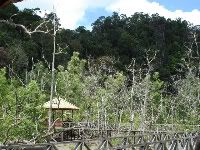
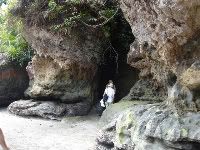
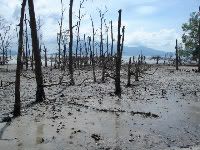
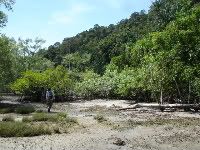
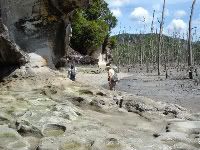
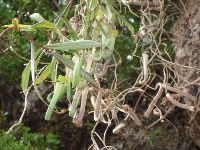
Soon enough, the ground began to morph into more mud than sand. Just as we were about to turn back, we discerned considerable movement at the tops of some nearby trees situated at the edge of the jungle. As we slowly inched our way closer, a small troop of proboscis monkeys could be seen clustered near the tops of the canopy, occasionally leaping from one tree to the next. Our guide explained that the monkeys normally would have descended from the trees and be grazing closer to the beach this time of day but it was just too hot for them. I, for one, certainly agreed with the monkeys' assessment of the weather conditions; the sudorific heat was absolutely brutal. As with all of my prior proboscis monkey encounters, I failed to get a good photograph of their unusual visage; it almost seemed like they were thumbing their noses at me.
We eventually turned away from the monkeys to start on our long trek back to the beach where a boat would pick us up for our return trip to the Bako stilt village. We walked for well over a mile under the relentlessly blazing sun until we finally reached the edge of the South China Sea. Once again, the water was so shallow that we needed to wade quite far out from shore in order for the boat to pick us up.
From that point, our trip back should have been smooth sailing but I quickly observed that we were drifting ever closer to a rocky outcropping. I turned around to see the driver frantically manipulating the outboard motor and repeatedly yanking on the starter chord. After many such attempts, the engine remained resolutely unresponsive. As we began to drift dangerously close to the rocky shore, the driver frantically grabbed an oar and paddled us out for a while so he could have another go at the engine.
Notwithstanding the possibility of being smashed against the rocks, I was not relishing the thought of spending the night in the jungle. We were all fully exposed to the blistering sun at that point and I was feeling profoundly drained from the heat and all of the dayís activities.
Courtesy of Angela, I had met two visitors from peninsular Malaysia, Azman and Idzuan, and was planning to hook up with them for dinner later that evening. Getting smashed with some cool beverage on the rocks in the comfortable Hilton club lounge was considerably more appealing then getting smashed against the rocks of Bako. And the idea of enjoying a nice dinner in a pleasant riverside seafood restaurant in Kuching was infinitely more palatable than scrounging with the monkeys on the local mud flats. Finally, just as we had all pretty much given up hope, the engine suddenly sputtered to a hesitant start and we hightailed it back to the Bako fishing village.

Once we arrived safely back at the dock, we ascended a few steps and then walked over to a shaded area to await our van ride back into Kuching.
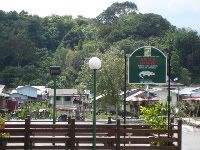
As we mounted the steps, we were overpowered by an overwhelming stench, an odor so powerful that it smelled as if something had died, come back to life and then died again from its own smell. My fellow travelers asked about the awful smell and I replied, truthfully, "dinner." Nearby, a mass of festering shrimp was fermenting odiferously in the tropical sunshine, eventually morphing from rotting seafood into the quintessential ingredient of much Malaysian cuisine, belacan.
Getting A Head in the Longhouse
When I visited the Sarawak Cultural Village a few months ago, I booked a ride on the 10 ringgit shuttle that operated from either the Holiday Inn or Crowne Plaza in downtown Kuching and then terminated at the Damai Beach Resort, about 35 km away. On the way to Damai, the shuttle dropped off passengers at the cultural village and then picked them up later for the return trip to Kuching.
The cultural village was designed and conceived to depict all of the major indigenous racial groups of Sarawak, portraying both their dwellings and lifestyle. From what I could determine, life must have been very harsh in those days and the youngsters matured at a very early age.

Seven ethnic houses represent the Malay, the Chinese, the Penan and the longhouses of the Bidayuh, Iban, Orang Ulu and the Melanau.
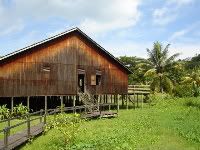
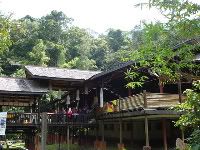
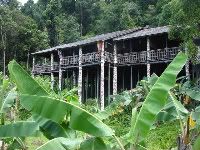
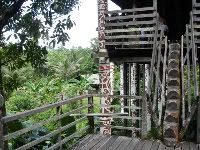
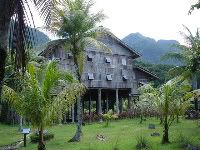


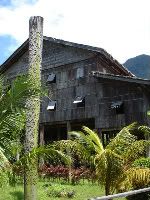
The 14 acre village is nestled in the foothills of 2658 foot Mount Santubong, which, according to legend, formed when two beautiful princesses exchanged blows and were turned into mountains by the King of Heaven. One of these mountains, Santubong, is said to resemble a woman lying on her back.
Surrounded by semi-landscaped jungle, an artificial lake situated in the middle of village was built to symbolize the proclivity of Sarawak denizens to build their abodes near bodies of water.
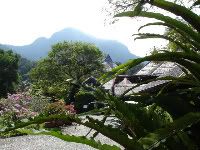
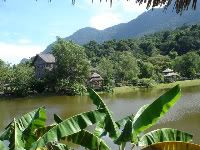

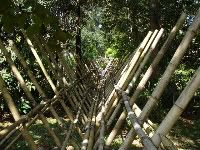
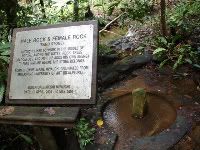
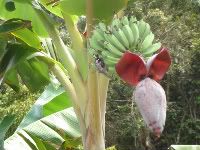
Visitors can meander around the circumference of the village and inspect all of the longhouses, chatting with each of its respective inhabitants to learn about the life, beliefs, crafts and customs of their forebears.
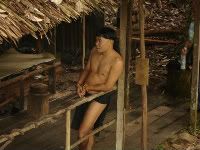
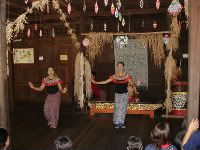
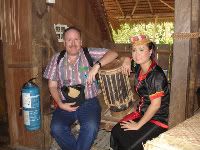
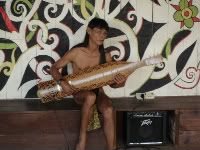
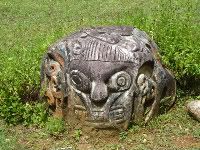

I observed most of the craft demonstrations but blew off the blow pipe exhibition because I had already successfully managed to use a blow pipe to hit a monkey on the leg. I had accomplished this feet while visiting the Monsopiad village, a 25 minute drive from Kota Kinabalu in Sabah so I figured I should quit while I was ahead. And, in the interest of full disclosure, I must confess that it was only a picture of a monkey whose leg I hit -- though, after my recent experiences in Bali, hitting the real thing would have felt mighty tempting.
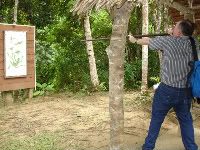
Monsopiad was a legendary Kadazan warrior whose people inhabited a region of Sabah several hundred years ago. According to local legend, when Monospiadís mother became pregnant, a sacred bird called a Bugang made a nest in the roof of the home. When Monospiad was born, so were the birdís hatchlings. This was interpreted as an omen and Monospiadís parents believed that this engendered great superpowers in their son and took special care to hone his skills.
At the time, Monospiadís village was frequently at the mercy of robbers so when Monospiad got a little bit older, he vowed to rid the village of this recurring scourge. He set about to hunt down the robbers and then returned to the village victorious, exhibiting a robberís head as proof of his conquest. Figuring that two heads were better than one, he ventured out once again and returned to the village bearing the requisite trophy of his victory. Before proudly displaying these heads in his home, he took them out into the jungle, where he hung them from trees for a while so they could dry out.
Now that their safety was ensured, the village people were ecstatic and I suppose one can forgive the young Monospiad for being just a little headstrong. The warrior soon set out upon other conquests, vowing to rid the area of all robbers and foreign "aggressors." As his collection of skulls grew ever larger, he quickly ran out of victims from whom to collect new head trophies. His pent up aggression not fully assuaged, he started dueling and provoking quarrels with everyone around him, motivated mainly by his desire to add heads to his collection.
The warrior soon set out upon other conquests, vowing to rid the area of all robbers and foreign "aggressors." As his collection of skulls grew ever larger, he quickly ran out of victims from whom to collect new head trophies. His pent up aggression not fully assuaged, he started dueling and provoking quarrels with everyone around him, motivated mainly by his desire to add heads to his collection.
At that point, the only tragic choice for the village was to rid themselves of their most respected denizen. So they summoned all of their remaining warriors who then snuck in at night and killed Monospiad after a huge and bloody battle. The power and strength originally bestowed on him by the sacred Bugang had been rescinded once he abused his gift and let his power go to his head. Although that was the end of Monospiad, his people honored his prior years of dedication by erecting a monument to him and then renamed the village in his name. To this day, one can still see 42 skulls hanging from the rafters of Monospiadís house, all "gazing" up towards the heavens.
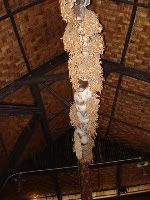
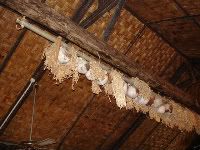
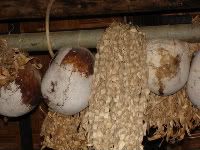
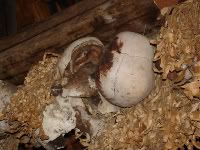
Going Ape at Semenggoh
The day after I journeyed to the Sarawak Cultural Village I ventured over to the Semenggoh Wildlife Rehabilation Centre, located 20 km from Kuching. To get there, I negotiated long and hard with one of the numerous professional "drivers" who linger outside the downtown Kuching hotels, waiting anxiously to take visitors for a ride.
At Semenggoh, one can observe orang utans in the wild, inasmuch as apes waiting to be fed at a dedicated feeding platform can be considered "wild." But, in truth, these people of the forest really are free to come and go as they please and they are, in reality, living in their natural habitat. This is not where many of these orang utans originally came from, though.
The origin of many of these apes is quite sad; many were orphaned or illegally captured, and then subsequently recovered and confiscated from their "owners." Quite a few of them had been terribly abused before finally ending up within the relatively safe realm of the sanctuary. Although these animals are free to forage on their own, food is always available twice a day on the feeding platform, just in case the orang utans are unable to gather enough of their own munchies.
A short walk along a well built plank pathway is required for humans to access the feeding platform. Buses disgorge their payload of passengers a fair distance away from the trailhead but private cars can sneak in considerably closer. The entrance itself is surrounded by an interesting assemblage of native vegetation, including pitcher plants, Sarawak pepper, wild orchids and a variety of other tropical flowers and fruits.
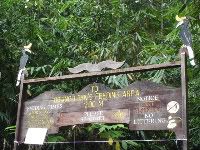
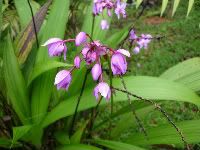
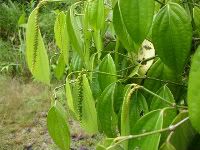
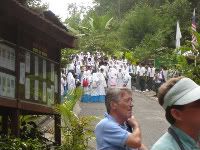
Prior to entering the inner reaches of the sanctuary, a ranger lectures visitors on what behaviors and actions should be avoided, such as flash photography and cell phone conversations, in fact, any loud conversations whatsoever. Nevertheless, I observed that these admonitions did very little to preclude such behaviors. In fact, the greatest disturbers of the peace were the very same drivers who had transported the busloads of visitors to the sanctuary.
Once assembled in front of the feeding platform, visitors are obliged to wait in the steamy jungle patiently and sweatily. Sometimes the orang utans donít show up at all, especially if they have been successful in harvesting ripe fruit on their own. After we had waited for a while, an attendant materialized bearing overflowing buckets of orang utan chow, mostly fruits, veggies, seeds and coconuts.
For quite some time, no orang utans could be seen, despite repeated loud, melodic and plaintive calls from the human caretaker. Then, slowly and surely, they began to swing in on vines from the tops of the trees, like so many furry, red Tarzans scurrying through the upper reaches of the canopy, rarely, if ever touching the ground. First one, then another, then a mother with her youngster, all accompanied by much whispering, finger pointing and camera clicking amongst the human audience.
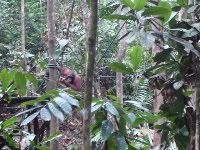
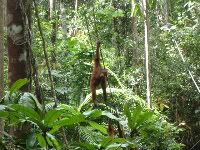
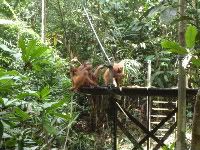

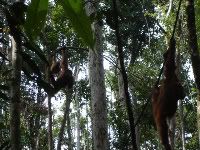
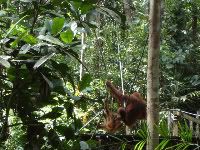


As many as seven orang utans showed up while I was there. Eventually, having had their fill of brunch, all of them disappeared back into the dense and steamy jungle, completely invisible for a while, at least until they reemerged later in the afternoon for their dinner feeding.



Next Chapter: The Hilton Batang Ai ai ai Longhouse Resort Ö
Bako National Park spans an area of 27 sq km and is situated at the tip of the Muara Tebas peninsula that juts out into the South China Sea. The park is an ecological treasure trove, comprised of seven unique ecosystems and 25 distinct vegetation types, representing nearly every species of plant found within Borneo. It is also an area of great natural beauty, its massive steep cliffs weathered over millions of years into a striking assortment of beautiful sea stacks, rugged arches and precipitous promontories.
From Kuching, one can take the Petrajaya bus No.6, a minibus or a taxi to Kampung Bako and then sign in at the registration counter. The park is accessible only via water, so a boat needs to be chartered for the 25 minute trip over to the park headquarters. From there, private guides can be hired to facilitate a variety of possible treks.
I opted for a tour package that included pickup at the Crowne Plaza, land transport to the Bako fishing village, boat transportation to the park entrance, all admission fees, guided walks along various jungle trails, lunch and return transport to the Hilton. After a 37 km ride by van from Kuching, we arrived at the stilt village situated near the mouth of the Sungai Bako. From there, I climbed aboard a small boat along with three other passengers, a fellow from Phoenix and a couple from the UK.





The boat ride took us from the swift currents of the turbid Sungai Bako out into the South China Sea, a coastal area frequently punctuated with permanently anchored fishing nets and populated by quite a few fishing boats.



The boat pulled into an area dominated by a vast mangrove swamp, nestled within the rugged rocky coastline. After pulling up to the dock, we strolled along an elevated boardwalk for the 15 minute trek to the park headquarters. The mud flat below us was populated by thousands of mudskippers, an amphibious fish that uses its pectoral fins for propulsion and can stay out of the water for several days at a time.



After checking in, our guide escorted the four of us up a very steep trail where grand vistas and spectacular views would await us. After a half hour of continuously inching our way over very large rocks and slippery tree roots, we stopped for a rest and were then informed that we were only a quarter of the way to the viewpoint. One of the other members of our group already had a wounded leg so after a brief powwow, we unanimously decided to branch off to a different trail whose vertical inclinations promised to be somewhat less extreme. By this point, so much sweat was poring off of me in the dense tropical humidity that my glasses kept slipping off my face and I finally opted to put them away. I figured that stumbling around with limited visibility in the jungle still beats losing my glasses permanently.
For the next hour and a half, we slogged along our new routing on the Telok Pandan Besar trail. As we proceeded on our journey, we frequently passed by large rattan trees, every surface of which was covered with fierce spines, designed to assist their growth over other plants and to deter herbivores. Our trail provided us with frequent glimpses of cliffs that descended steeply to secluded coves and beaches and to large rocky sea stacks poised imposingly along the shoreline. We rounded one sharp twist in the trail to find ourselves confronted with a very long procession of millions of ants, an immense formicid convoy with no clear beginning or end.







As we continued walking along the jungle trail, we heard some rustling in the leaves high above us in the canopy. We all stopped and peered upwards into the dense foliage and eventually discerned a small group of proboscis monkeys feeding amongst the tree tops.


The proboscis monkeys can attain weights over 50 pounds and are endemic to the mangrove swamps and wetlands of Borneo. They are well known for their stereotypically immense nose that sometimes grows to exceed seven inches in length for males. The huge nose acts like a resonating chamber that can be used to intensify warning calls. When they become upset, they quite literally get their noses out of joint as the nose engorges with blood, thereby intensifying their warning calls.
When the Dutch began infiltrating Indonesia in the 16th century some of the locals could not help but notice the obvious similarity between their big bellies and noses with those of the proboscis monkeys. The Indonesian word for "Dutch" is belanda so, it should come as no surprise that a popular nickname for this monkey was monyet belanda, which literally means, "Dutch monkey."

My attempts to get a decent photograph of the monkeys were thwarted every time I tried. Not only were the monkeys quite high up in the treetops and partially obscured by vegetation, they kept turning away every time I snapped a picture. This was my second effort to view proboscis monkeys; the first was a couple of months ago while I was exploring the Klias river in Sabah. Those monkeys proved to be equally shy when it came to turning in my direction. So, the best that I can do under the circumstances is to offer this close-up of the secretive proboscis that I managed to dig up from deep within the zoological archives.






We continued on the trail for a while longer and then descended a steep incline through a cliff teaming with vegetation. The Telok Pandan Besar trail ended at a broad beach where we gathered under the roof of a small wooden hut to spend a little time relaxing, rehydrating and escaping from the relentless sun for a while. A boat was scheduled to pick us up and cart us off to our next destination and it seemed like a perfectly pleasant place to await its arrival.
When we arrived at the hut, I met an American fellow who had just flown in from Dubai with his two young sons. The boys spent much of the time scampering along the beach, clearly immune and impervious to the baking rays of the sun. Also foraging along the beach were several troops of long-tailed macaques, which, under the current circumstances, helps to explain why the animals are also often referred to as crab eating macaques in many parts of the world.
Given that I have had more than my fill of monkeys when I visited Bali the previous month, I opted to rest in the hut and stay as far away from the monkeys as I could. Besides, under the present oppressive weather conditions, the last thing I needed at this point was yet another monkey hat.
Nevertheless, none of my personal reticence precluded me from trying to coerce others to interact with the macaques. I tried everything I could think of to encourage the boys to play with the monkeys and even volunteered to donate a variety of gifts that the boys could use to lure the mischievous primates a little closer. Unfortunately, the boys ignored me completely, thus proving that they, and the monkeys, were all much smarter than I was.

After waiting for a half hour, a boat finally appeared on the distant horizon and we walked out towards it along the beach under the blazing Borneo sun. However, when we arrived at the edge of the water, it was so shallow that the boat was unable to come in close enough to pick us up. Our only possible choice was to wade out into the muddy water, nearly as hot as bath water, and then climb on board a short distance from shore.






Once we were all safely aboard, the motor started right up and we soon found ourselves cruising along the coast of the peninsula. From time to time, we slowed down to inspect secluded coves and isolated beaches or came in for closer looks at rocky cliffs dripping with lush tropical vegetation. We spotted a yellow kingfisher poised on a rocky precipice and eased up to several dramatic rocky pillars, such as the famous cobra head sea stack that resides just off the shore of Teluk Pandan Kecil.




We eventually wound up back in the vicinity of the Bako park headquarters, where we endured a very long wade ashore through warm and murky mud flats. Our guide sternly warned us to watch where we were walking because catfish liked to embed themselves in the mud, exposing only their sharp dorsal spines to those unlucky enough to step on them. Given that none of us could see anything at all through the intense turbidity of the water, I am not at all sure what we could have done to avoid them. As we trundled ashore, I noticed the phrase "1492 miles" inscribed on the guideís sweatshirt and asked him what it meant. He responded that he didnít know; he just liked the shirt.

We finally ascended to the boardwalk and all of us were, fortunately, catfish free. Within the administrative complex at Teluk Assam, we were led to a small canteen where we were invited to partake in a lunch buffet. The rule was that we could make only one visit to the buffet but we could take as much as we wanted. As a result of the enormous breakfast buffet that I had enjoyed several hours ago in Kuching, I as not especially hungry.

But I recall reading about of group of Taiwanese engineering students who came up with a clever way to maximize their return on investment when faced with similar restrictions at a buffet in Taipei.

When I stepped outside after lunch, I encountered a large monitor lizard resting in a wet area near the corner of the building.

A few feet away from the giant lizard, I was confronted by a huge bearded pig who had just come sauntering by to see what he could scavenge. By the time I grabbed my camera, only his rump was still in the frame. So, for educational purposes, I have provided some stock photos so you can see what he looked like:





As the wild boar slogged off into the trees, we walked along a small trail that brought us alongside a variety of snakes, including a painted bronzeback and the highly venomous green pit viper, who was using its prehensile tail to coil tightly against a large tree.

As we continued our walk, we ran into a pair of French visitors, who reported that they had seen a troop of silver leaf monkeys about 20 minutes further down the trail. Quiet and docile creatures, the silver leaf monkeys resemble the evil long-tailed macaques in all but temperament so I asked the French couple if they were absolutely sure that the silver leafs they had spotted were not really long-tailed macaques.


The couple were quite adamant about the identity of the primates so our group opted for a 20 minute detour so we could get a closer look. As we began to ascend a steep hill, the fellow from Phoenix decided to stay behind because his bandaged leg was beginning to hurt. After mulling it over a bit, I chose to keep him company because my gut instinct told me that the monkeys were probably just macaques and I had already surpassed my quota of long-tailed macaque interactions for the year. So I asked the other members of our group to send one of the monkeys back with a signed note saying that they were not macaques, sort of like a carrier monkey. As I had suspected, no monkeys returned with a note; my instincts that the whole thing was all a wild monkey chase turned out to be correct.
As we continued along on our originally planned itinerary, we walked along the Telok Paku trail and eventually arrived at another elevated boardwalk. At the terminus of this very long walkway, we finally descended onto the ground below, which had not yet made up its mind whether it wanted to be a sandy beach or a mud flat. Our guide led us along the edge of some very steep cliffs where the ground was a little more solid and we then found ourselves in a very narrow cave. Squeezing through the cave was a very tight fit but we eventually emerged into a secluded cove on the other side. In this area, the rocks of the cliff face were carpeted with dense clusters of carnivorous pitcher plants, some of which cascaded down from very long vines anchored much higher up on the cliff.






Soon enough, the ground began to morph into more mud than sand. Just as we were about to turn back, we discerned considerable movement at the tops of some nearby trees situated at the edge of the jungle. As we slowly inched our way closer, a small troop of proboscis monkeys could be seen clustered near the tops of the canopy, occasionally leaping from one tree to the next. Our guide explained that the monkeys normally would have descended from the trees and be grazing closer to the beach this time of day but it was just too hot for them. I, for one, certainly agreed with the monkeys' assessment of the weather conditions; the sudorific heat was absolutely brutal. As with all of my prior proboscis monkey encounters, I failed to get a good photograph of their unusual visage; it almost seemed like they were thumbing their noses at me.
We eventually turned away from the monkeys to start on our long trek back to the beach where a boat would pick us up for our return trip to the Bako stilt village. We walked for well over a mile under the relentlessly blazing sun until we finally reached the edge of the South China Sea. Once again, the water was so shallow that we needed to wade quite far out from shore in order for the boat to pick us up.
From that point, our trip back should have been smooth sailing but I quickly observed that we were drifting ever closer to a rocky outcropping. I turned around to see the driver frantically manipulating the outboard motor and repeatedly yanking on the starter chord. After many such attempts, the engine remained resolutely unresponsive. As we began to drift dangerously close to the rocky shore, the driver frantically grabbed an oar and paddled us out for a while so he could have another go at the engine.
Notwithstanding the possibility of being smashed against the rocks, I was not relishing the thought of spending the night in the jungle. We were all fully exposed to the blistering sun at that point and I was feeling profoundly drained from the heat and all of the dayís activities.
Courtesy of Angela, I had met two visitors from peninsular Malaysia, Azman and Idzuan, and was planning to hook up with them for dinner later that evening. Getting smashed with some cool beverage on the rocks in the comfortable Hilton club lounge was considerably more appealing then getting smashed against the rocks of Bako. And the idea of enjoying a nice dinner in a pleasant riverside seafood restaurant in Kuching was infinitely more palatable than scrounging with the monkeys on the local mud flats. Finally, just as we had all pretty much given up hope, the engine suddenly sputtered to a hesitant start and we hightailed it back to the Bako fishing village.

Once we arrived safely back at the dock, we ascended a few steps and then walked over to a shaded area to await our van ride back into Kuching.

As we mounted the steps, we were overpowered by an overwhelming stench, an odor so powerful that it smelled as if something had died, come back to life and then died again from its own smell. My fellow travelers asked about the awful smell and I replied, truthfully, "dinner." Nearby, a mass of festering shrimp was fermenting odiferously in the tropical sunshine, eventually morphing from rotting seafood into the quintessential ingredient of much Malaysian cuisine, belacan.
Getting A Head in the Longhouse
When I visited the Sarawak Cultural Village a few months ago, I booked a ride on the 10 ringgit shuttle that operated from either the Holiday Inn or Crowne Plaza in downtown Kuching and then terminated at the Damai Beach Resort, about 35 km away. On the way to Damai, the shuttle dropped off passengers at the cultural village and then picked them up later for the return trip to Kuching.
The cultural village was designed and conceived to depict all of the major indigenous racial groups of Sarawak, portraying both their dwellings and lifestyle. From what I could determine, life must have been very harsh in those days and the youngsters matured at a very early age.


Seven ethnic houses represent the Malay, the Chinese, the Penan and the longhouses of the Bidayuh, Iban, Orang Ulu and the Melanau.








The 14 acre village is nestled in the foothills of 2658 foot Mount Santubong, which, according to legend, formed when two beautiful princesses exchanged blows and were turned into mountains by the King of Heaven. One of these mountains, Santubong, is said to resemble a woman lying on her back.
Surrounded by semi-landscaped jungle, an artificial lake situated in the middle of village was built to symbolize the proclivity of Sarawak denizens to build their abodes near bodies of water.






Visitors can meander around the circumference of the village and inspect all of the longhouses, chatting with each of its respective inhabitants to learn about the life, beliefs, crafts and customs of their forebears.






I observed most of the craft demonstrations but blew off the blow pipe exhibition because I had already successfully managed to use a blow pipe to hit a monkey on the leg. I had accomplished this feet while visiting the Monsopiad village, a 25 minute drive from Kota Kinabalu in Sabah so I figured I should quit while I was ahead. And, in the interest of full disclosure, I must confess that it was only a picture of a monkey whose leg I hit -- though, after my recent experiences in Bali, hitting the real thing would have felt mighty tempting.

Monsopiad was a legendary Kadazan warrior whose people inhabited a region of Sabah several hundred years ago. According to local legend, when Monospiadís mother became pregnant, a sacred bird called a Bugang made a nest in the roof of the home. When Monospiad was born, so were the birdís hatchlings. This was interpreted as an omen and Monospiadís parents believed that this engendered great superpowers in their son and took special care to hone his skills.
At the time, Monospiadís village was frequently at the mercy of robbers so when Monospiad got a little bit older, he vowed to rid the village of this recurring scourge. He set about to hunt down the robbers and then returned to the village victorious, exhibiting a robberís head as proof of his conquest. Figuring that two heads were better than one, he ventured out once again and returned to the village bearing the requisite trophy of his victory. Before proudly displaying these heads in his home, he took them out into the jungle, where he hung them from trees for a while so they could dry out.
Now that their safety was ensured, the village people were ecstatic and I suppose one can forgive the young Monospiad for being just a little headstrong.
 The warrior soon set out upon other conquests, vowing to rid the area of all robbers and foreign "aggressors." As his collection of skulls grew ever larger, he quickly ran out of victims from whom to collect new head trophies. His pent up aggression not fully assuaged, he started dueling and provoking quarrels with everyone around him, motivated mainly by his desire to add heads to his collection.
The warrior soon set out upon other conquests, vowing to rid the area of all robbers and foreign "aggressors." As his collection of skulls grew ever larger, he quickly ran out of victims from whom to collect new head trophies. His pent up aggression not fully assuaged, he started dueling and provoking quarrels with everyone around him, motivated mainly by his desire to add heads to his collection. At that point, the only tragic choice for the village was to rid themselves of their most respected denizen. So they summoned all of their remaining warriors who then snuck in at night and killed Monospiad after a huge and bloody battle. The power and strength originally bestowed on him by the sacred Bugang had been rescinded once he abused his gift and let his power go to his head. Although that was the end of Monospiad, his people honored his prior years of dedication by erecting a monument to him and then renamed the village in his name. To this day, one can still see 42 skulls hanging from the rafters of Monospiadís house, all "gazing" up towards the heavens.




Going Ape at Semenggoh
The day after I journeyed to the Sarawak Cultural Village I ventured over to the Semenggoh Wildlife Rehabilation Centre, located 20 km from Kuching. To get there, I negotiated long and hard with one of the numerous professional "drivers" who linger outside the downtown Kuching hotels, waiting anxiously to take visitors for a ride.

At Semenggoh, one can observe orang utans in the wild, inasmuch as apes waiting to be fed at a dedicated feeding platform can be considered "wild." But, in truth, these people of the forest really are free to come and go as they please and they are, in reality, living in their natural habitat. This is not where many of these orang utans originally came from, though.
The origin of many of these apes is quite sad; many were orphaned or illegally captured, and then subsequently recovered and confiscated from their "owners." Quite a few of them had been terribly abused before finally ending up within the relatively safe realm of the sanctuary. Although these animals are free to forage on their own, food is always available twice a day on the feeding platform, just in case the orang utans are unable to gather enough of their own munchies.
A short walk along a well built plank pathway is required for humans to access the feeding platform. Buses disgorge their payload of passengers a fair distance away from the trailhead but private cars can sneak in considerably closer. The entrance itself is surrounded by an interesting assemblage of native vegetation, including pitcher plants, Sarawak pepper, wild orchids and a variety of other tropical flowers and fruits.




Prior to entering the inner reaches of the sanctuary, a ranger lectures visitors on what behaviors and actions should be avoided, such as flash photography and cell phone conversations, in fact, any loud conversations whatsoever. Nevertheless, I observed that these admonitions did very little to preclude such behaviors. In fact, the greatest disturbers of the peace were the very same drivers who had transported the busloads of visitors to the sanctuary.

Once assembled in front of the feeding platform, visitors are obliged to wait in the steamy jungle patiently and sweatily. Sometimes the orang utans donít show up at all, especially if they have been successful in harvesting ripe fruit on their own. After we had waited for a while, an attendant materialized bearing overflowing buckets of orang utan chow, mostly fruits, veggies, seeds and coconuts.
For quite some time, no orang utans could be seen, despite repeated loud, melodic and plaintive calls from the human caretaker. Then, slowly and surely, they began to swing in on vines from the tops of the trees, like so many furry, red Tarzans scurrying through the upper reaches of the canopy, rarely, if ever touching the ground. First one, then another, then a mother with her youngster, all accompanied by much whispering, finger pointing and camera clicking amongst the human audience.








As many as seven orang utans showed up while I was there. Eventually, having had their fill of brunch, all of them disappeared back into the dense and steamy jungle, completely invisible for a while, at least until they reemerged later in the afternoon for their dinner feeding.



Next Chapter: The Hilton Batang Ai ai ai Longhouse Resort Ö
Last edited by LarryU; May 24, 2008 at 7:10 pm
#9
Original Poster
Join Date: Feb 2000
Location: Lake Oswego, OR
Programs: UA 1K 2MM, Marriott Lifetime Platinum, Hilton Diamond
Posts: 3,202
The Hilton Batang Ai ai ai Longhouse Resort
We do not target our marketing towards the American traveler Ė Quote from the GM of the Hilton Batang Ai
The area that would eventually become home to Batang Ai National Park was originally populated by the Iban, whose name for the region literally means, "the river." It was one of the last areas to come under the influence of the White Rajah, James Brooke, and its ultimate subjugation led to the slaughter of 800 of its indigenous residents. At the time, well over 40 longhouses populated the banks of the river and when the dam that formed the 80 sq km Batang Ai reservoir was finished in 1985, most of these dwellings were inundated and its residents resettled. The national park was established in 1991 and now spans an area of 240 sq km. When combined with the adjoining Lanjak-Entimau Wildlife Sanctuary in Malaysia and the Betung-Kerihun National Park in West Kalimantan, Indonesia, the region forms a much larger ecological refuge covering an area of 10,000 sq km.
The Hilton Batang Ai Resort opened on the shores of Batang Ai lake in 1995 and is managed and operated by the Hilton Kuching. On the one hand, the control that the Hilton Kuching exerts on the Batang Ai property seems to be so tight that at times it appears that the local staff and management cannot make a single decision without frequent and detailed instructions from headquarters for any and every situation, no matter how trivial. On the other hand, as a Diamond VIP member of the Hilton HHonors program, my treatment by these two properties could not have been more different, ranging from superb at the Hilton Kuching to clueless and indifferent at the Hilton Batang Ai.
On its web site, the description of the Hilton Batang Ai certainly sounded quite attractive to a former ecologist such as myself. It begins, "Set on the edge of spectacular rainforest, the Hilton Batang Ai Longhouse Resort is Hiltonís only jungle propertyÖ" However, even from its inception, the reviews of the service and treatment at this property have always been a mixed bag, ranging from tepid at best to horrific at worst.
One would think that after over 13 years in business, this property would have finally found its groove but that is most definitely not the case. In the recent past, the hotelís one saving grace was that its room rates were always very reasonable, often less than $40 USD per night. These low rates could offset some of the other high costs, such as transportation to the property and the cost of meals provided to a captive audience. This is no longer the case.
Room rates are now nearly twice what they were a year ago unless one books through a third party and thereby forgoes Hilton points and elite treatment. Then again, I could discern very little elite recognition while I was there so booking through Hilton may not produce much of a benefit anyway. The cost of meals, though never inexpensive, was now ludicrously high. In my case, each dinner priced out at 78 ringgits, an amount for which three hungry guys could dine on some very nice seafood in Kuching and still get change.
As a certified glutton for punishment, I booked not one, but two nights at this property, figuring that a two night stay would more effectively amortize both my transportation costs and the time it takes to get there. To ameliorate these costs somewhat, I booked my room as an award stay with the Diamond Desk, still a very reasonable 10,000 points per night for this category 1 property
Getting to Batang Ai requires a 250 km overland trip from Kuching to the Hilton jetty, followed by a 20 minute boat ride to the entrance of the 100 room resort, nestled serenely on the shores of the reservoir. Its web site advised that transportation arrangements should be made in advance so I sent a polite and detailed email that specified my travel dates and included all of my reservation details. After a week had elapsed, I had not received a reply to my original email so I sent another email to the manager of the Hilton Kuching and this email was ignored as well.
I then contacted the Hilton Diamond Desk, whose somewhat terse reply was that, "I guess you could call them directly." As an admittedly unrelated aside, when I recently needed to resolve an unsettled transportation issue for a Starwood property in Bali, the platinum concierge was on the phone directly with the property within a minute, took care of the issue right away and even followed up with me afterwards. From this, you can conclude what you will about the quality of support that Hilton HHonors customer service provides to its elite guests, at least compared to benefits provided by Starwood Preferred Guest.
Given that I would already be in Kuching for several days before starting my journey to Batang Ai, I scheduled my transportation directly with a concierge on the club floor of the Hilton Kuching. At the time, the cost of the transportation listed on the web site was 110 ringgits but on the morning of my departure, I was provided with a voucher listing a rate of 145 ringgits. By the time I arrived outside to wait for the shuttle van, another Hilton staffer told me the rate actually should have been closer to 400 ringgits but they were doing me a big favor.
Later on, during a very lengthy check-in process, a staff member at the Batang Ai asked me to sign a receipt for 248 ringgits, which I refused to do. Please note that guests are not obliged to make travel arrangements through the Hilton Kuching but can avail themselves of the services of any one of the myriad travel agencies that inhabit Kuching, probably at a lower cost and more honest treatment.
Please note that guests are not obliged to make travel arrangements through the Hilton Kuching but can avail themselves of the services of any one of the myriad travel agencies that inhabit Kuching, probably at a lower cost and more honest treatment.
The trip out to the dam took exactly four hours, including a rest stop at Lachau, where the driver grabbed lunch and guests can avail themselves of a pay toilet and some small shops. If you are intending to load up on snacks in an attempt to sidestep some of the usurious food prices at Batang Ai, this will be your last chance to do so. The road itself is fully paved, at least until one comes within a couple of miles of the dam. If you are expecting to traverse a pockmarked crater-filled dirt road, the quality of the surface will greatly exceed your expectations. If you are anticipating a modern, smooth, evenly paved roadway, then you will be slightly disappointed.
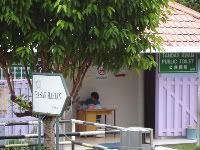
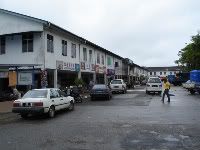
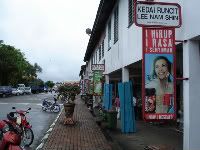


Once we arrived in the vicinity of the Hilton jetty, I was led to a small covered waiting area from where one can wait for the arrival of the boat, well protected from the sun or any inclement weather, should there be any. After 15 minutes, I could see a boat on its way across the lake, so I walked down a paved driveway and hopped aboard, seemingly accompanied mostly by local folk.

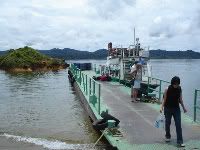
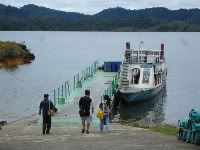
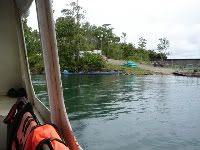

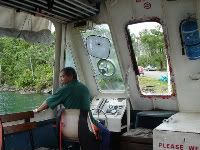
After a 20 minute cruise across the calm lake, the expansive Hilton Batang Ai property came into view, its dark brown, longhouse style buildings blending in naturally with the surrounding lush green landscape.
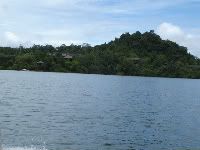
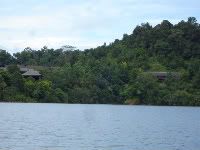
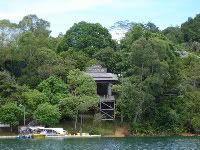
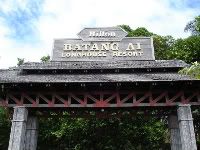
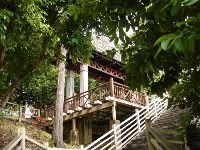
Once the boat pulled up to the Hilton Batang Ai dock, two friendly staff members assisted me up several flights of stairs and into the lobby, where we sat on a couch and talked for about 20 minutes. I learned that the hotel expected to serve about 24 guests on that Thursday evening but they anticipated that this number would double for the weekend rush the following night. I also learned that the majority of visitors are typically affiliated with various package tours and relatively few of them are Americans. Indeed, based on subsequent conversations with some of the other guests during my visit, this turned out to be a very accurate assessment. Most of the visitors spend a day or two but I was astonished to learn that there was currently one guest in residence who was currently in the midst of a 30 day stay and had already been there previously. Yikes.
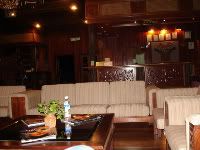
I was trying to be as polite as I could as I sat there and pondered why I was not checking in. Early on, when I asked the staff members about it, they explained that there was already a guest standing by the front desk. But that guest had long since wandered off and here I was still sitting on the couch. I ultimately just thanked the staffers for the pleasant chat and ambled over to the front desk on my own, standing right next to the silver Hilton HHonors plaque.
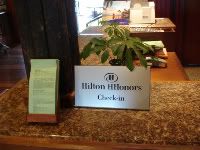
I presented the front desk clerk with all of my credentials, including my Hilton HHonors Diamond card, a credit card and a printout of my two night award certificate, clearly bearing the words, "Diamond Redemption." Perhaps it was me but nearly everything I did or said seemed to confuse her. I asked about breakfast, about a diamond upgrade and about bottled water in the room. I could not get a straight answer about anything. I don't think it was a language barrier because I encountered very few communications issues with any other staff members and I interacted with many of them.
When she presented me with a transportation receipt for 248 ringgits, I showed her the voucher issued by the Hilton Kuching, clearly spelling out a price of 145 ringgits in bold letters. She responded that she would need to get instructions from the Hilton Kuching, which seemed to be the standard response to even the most minor question during my stay.
On the lengthy walk to my room, I learned that only a few of the buildings on the property are currently open for guests due to very low occupancy. The room itself was very small and dingy and I could not understand why something better was not available, especially when one considers that there were very few other guests at the hotel. When I asked about bottled water and one of the staffers pointed to the tap, I had had enough and told them I would be returning to the lobby.
Once back at the front desk, I asked to speak to the manager on duty and was eventually greeted by Jalan. I explained my concerns and disappointments to him and he said that though the computer system had my Hilton HHonors number, it did not indicate anything about my elite status. This response certainly seemed very strange to me given that I made the reservation through the diamond desk and had received several subsequent reminders from Hilton about my upcoming stay. The Hilton Kuching certainly seemed very well aware of my status and they metaphorically constitute the puppeteer who pulls the strings of the Batang Ai marionette. And I suppose that the Hilton Diamond membership card that I presented when I initially checked in was not functioning well either.
Nevertheless, Jalan eventually straightened everything out both pleasantly and graciously. I was reassigned to a spacious duplex suite a short walk away from the main building. The bedroom was located upstairs and, though not as cool as downstairs, had its own air conditioning unit and a ceiling fan so it was eminently survivable. There was a bathroom on both levels and downstairs was a minibar that contained two complimentary bottles of water. ^
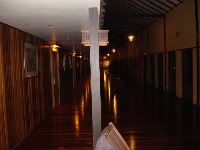
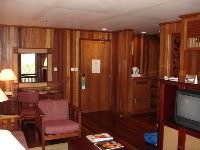
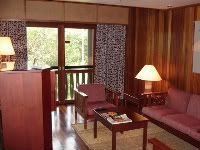
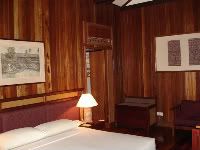
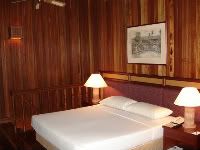
After I settled into my room, I went for a long walk around the very beautiful property. From my longhouse, I walked past the pool, back through the lobby and the restaurant and then descended down towards the dock and waterfront.


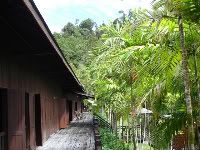
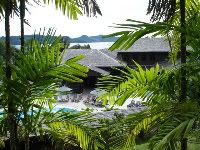
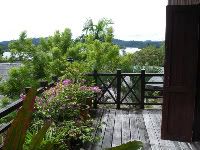
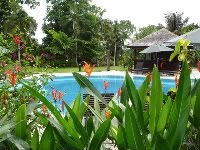
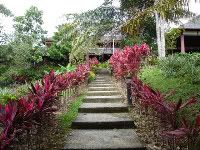

I walked as much as I could around the well landscaped grounds, richly planted with a nice variety of flowers, fruit trees and other attractive vegetation.
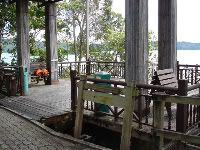
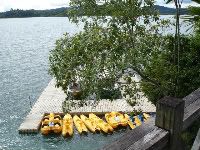
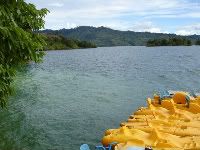

Corn-ucopia
At 7:00 PM, I materialized at the entrance of the restaurant for dinner, where one can enjoy numerous dishes derived from a wide variety of local jungle fare:
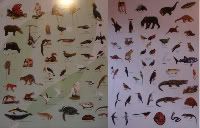
OK, I'm just kidding about that, that's actually a list of creatures that you are not supposed to eat. Each night, a buffet dinner is available in the Nanga Mepi restaurant, according to a schedule mounted on a wall not very far from the entrance to the restaurant.
Each night, a buffet dinner is available in the Nanga Mepi restaurant, according to a schedule mounted on a wall not very far from the entrance to the restaurant.
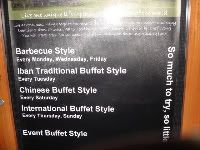
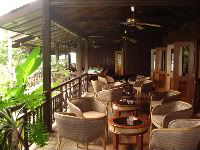
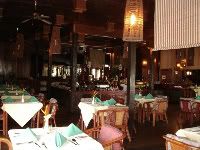
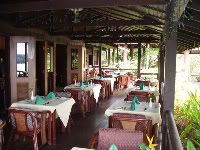
The cost of the buffet dinner amounted to a very expensive 78 ringgits but an ala carte menu is available if you ask for it. The presentation of the buffet is actually very attractive and I thought that the food for dinner was fairly decent. I was less impressed with breakfast, which I found to be unimaginative and bland. Of course, I readily confess that I had been quite spoiled by the superb breakfast fare provided by the Hilton Kuching and the The Westin Kuala Lumpur.
Overall, the service and staff at all of the meals were very friendly and attentive. Perhaps a little too attentive when one considers the very high ratio of staff members to guests.
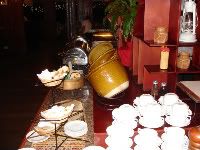
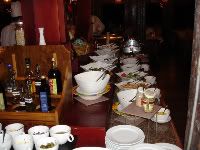
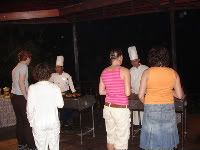

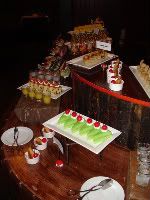
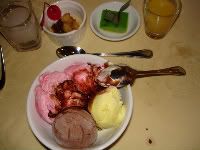
I wrapped up dinner by sampling a diverse assortment of flavorful and attractive cakes, fruit and ice cream. The latter was available in three flavors, chocolate, strawberry and what I initially assumed was a yellowish tinted vanilla but actually turned out to be corn flavored. If you are unsure about whether or not you will enjoy corn ice cream, just try to recall the taste of canned creamed corn. You can now imagine the taste of corn ice cream. It appeared that nobody else was willing to try the corn ice cream except for me so I had a second helping because it was looking very lonely and neglected on the buffet.
From what I understand, the dominant player in the local ice cream market, Nestle, plans to introduce other popular local flavors into East Malaysia such as sago and yam. As odd as some of these ice cream varieties may seem, they are still fairly innocuous when compared to some of the more interesting and bizarre flavors such as raw horse flesh and other exotic flavors that one may encounter in Japan.
Each evening, the hotel advertises a free video presentation and nature talk. When I arrived at the designated room at 9:00 PM, all of the windows were closed and both the ceiling fan and air conditioning were initially turned off. The nature video itself was entertaining enough but it seemed somewhat incongruous that it focused on the orang utans inhabiting Sepilok, which is a sanctuary located in Sabah. I would have thought it would have been more appropriate to play a video emphasizing some aspect of nature endemic to Sarawak but what do I know about running a longhouse resort in Sarawak. The next evening turned out to be a repeat performance, including both the airless room and precisely the same Sepilok video. From what I learned, they have evidently replayed the same video every night since the inception of the hotel.
The next evening turned out to be a repeat performance, including both the airless room and precisely the same Sepilok video. From what I learned, they have evidently replayed the same video every night since the inception of the hotel. 
Prior to heading back to my room, I inspected the list of activities that were available to guests. I signed up for the free morning sunrise walk and was instructed to present myself in the lobby promptly at 5:45 AM. I also signed up for a one hour nature walk that would begin later in the morning at a cost of five ringgits for the walk plus an additional five ringgits for an optional bottle of water. I also contemplated booking a fishing trip but, like most of the other activities, it was priced for a minimum of two people and I was unwilling to bear the entire cost of this activity alone. On the way back to my room, I picked up a brochure listing these very same activities and could not help but notice that the prices listed on the printout were completely different from those on public display in the lobby.
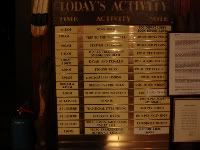
Learning the Ropes on the Canopy Walk
The next morning, I woke up early from a sleep that proved to be quite difficult because the soundproofing between rooms was so poor that I could hear every disgusting gasp, snort, retch and wheeze from the unhappy guest in the adjoining room. In fact, he sounded so bad at times that I had briefly contemplated notifying the hotel staff that the fellow might require some medical attention. As I left the bedroom, I encountered an unfortunate room design flaw. There is no light switch at the top of the stairs to illuminate the lower level so one is forced to stumble down the oddly pitched stairs in complete darkness and then fumble around for a light switch downstairs.
I arrived in the lobby a little before 5:45 AM and by 6:10 AM, nobody had shown up to lead the hike. After some friendly prompting on my part, a fellow eventually materialized and off we went, just the two of us, towards a point of land about a 10 minute walk from the lobby. To be honest, he seemed a little bit surprised that anyone showed up at all so I would guess that guests attending these early morning strolls must be relatively rare. We talked quietly for a bit but he seemed more interested in smoking than anything else and soon we just stood in silence and listened to the sounds of all of the birds who had arisen early to greet the dawn.
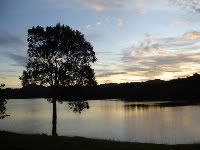
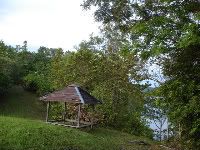
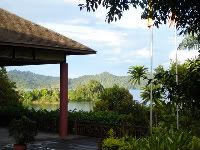
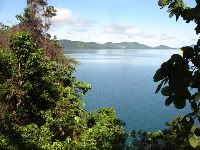

At 10:00 AM, I met two guests from Holland in the lobby and then embarked on the brief nature walk with a guide, Peter. We sauntered around the property for a short while and then undertook a steep but very quick climb that eventually placed us at the foot of an old grave in the middle of the jungle. At one end of the grave was a large ceramic jar and a couple of smaller empty glass bottles, both very well weathered and partially covered with moss. Scattered amongst the leaves that littered the moist surface of the grave were a large number of ringgits, mostly coins but there was also a smaller tray containing some paper currency.

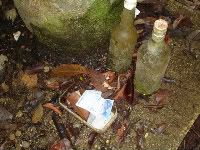
Ancestor worship is a fundamental component of Iban spirituality because of the firm belief that the dead can influence and be influenced by their living descendants. The living hope that their ancestors will look favorably on them or, at the very least, not screw around with them. From what I understand, once a year the family of the deceased gather by the grave to have a picnic to honor their ancestors. Of course, extra food and drink is brought along to share with the dead.
From the gravesite, we walked a bit further through the jungle until we found ourselves at the threshold of an elevated rope walkway, wending its way amongst the treetops suspended 30 meters above the ground. Semi-firm footing was provided by well-aged narrow wooden planks that often groaned and squeaked under the weight of my steps. The suspended walkway wobbled considerably as I slowly inched my way along, tightly clutching the web of rope netting that held it precariously off the ground.
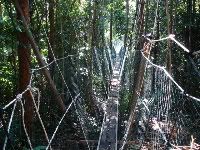
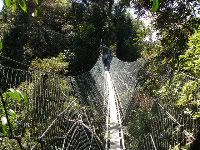
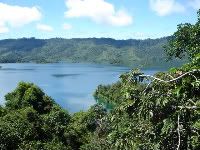
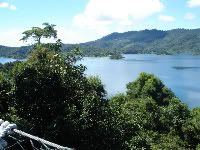
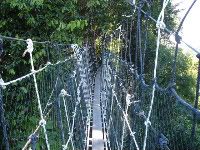
Halfway along the canopy walk, I arrived at a wooden tree platform, elevated 40 meters above the ground. From there, I was afforded stunning views of the turquoise waters of Batang Ai Lake, rendered an even more intense blue because of its juxtaposition against the verdant green backdrop of the surrounding terrain. From the platform, I ascended a rickety wooden ladder that gave way to another rope walkway, this one deployed on a sharp incline. That walkway terminated at another viewing platform, affording additional stunning views of the surrounding landscape.
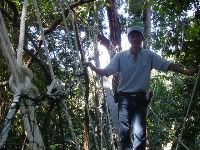
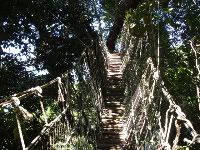


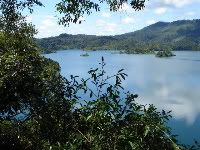
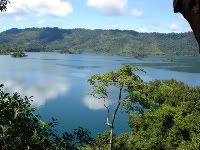
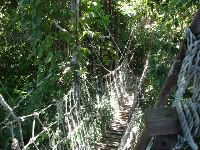


At the conclusion of the nature walk, we returned to the environs of the Hilton an hour after it had begun. Afterwards, I continued wandering around the area for a bit on my own, walking down each trail I could find until I could go no further. Along the way, I examined a variety of interesting fruits and flowers and spotted a fish farm anchored serenely in the middle of the calm lake, evidently holding red tilapia until they were large enough to eat.
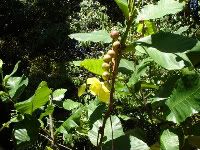
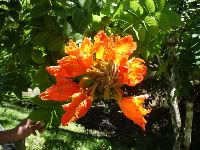
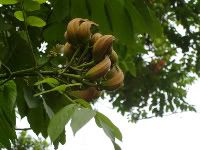
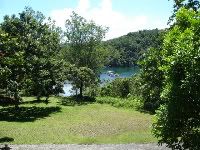
When I returned to my room to relax and cool off a bit, I found that it had been fully serviced by housekeeping but my two small bottles of water had not been replaced. Various staff members in the lobby stared it me blankly when I asked for two more bottles until Jalan wandered by and took care of it. Sort of.
When I returned to the room about an hour later, I found two new bottles of water in the room. However, upon closer inspection, I could readily see that they were not sealed! So, I would presume that hotel employees must retrieve discarded water bottles from the garbage, refill them with some species of water and then redeploy the bottles back to the guest rooms. This rather defeats the intent and purpose of bottled water, in my humble opinion.
So, I would presume that hotel employees must retrieve discarded water bottles from the garbage, refill them with some species of water and then redeploy the bottles back to the guest rooms. This rather defeats the intent and purpose of bottled water, in my humble opinion. 
Later on, I decided to sit out by the pool a bit, protected from the searing sun by the ample shade provided by a very large umbrella. Even with that, conditions were still somewhat uncomfortable due to the thick and dense humidity. One other guest showed up while I was there and then she too wandered off, presumably to cooler pastures. I must confess that I was not especially disappointed when the skies began to darken and the hotel staff scurried out and take down the large umbrellas, forcing me to go indoors for a bit and replenish my air conditioning deficiency.
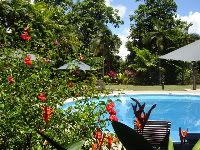

Yours is a Very Bad Longhouse*
Given some of my unsatisfactory and profoundly bewildering interactions with the front desk staff thus far, I reasoned that it might behoove me to budget just a little extra time for me to checkout. So, I wandered over to the front desk immediately after breakfast, figuring that a full four hours before my noon checkout might be a sufficient amount of time for this complicated task.
The desk clerk presented me with a bill that contained some very interesting charges indeed, including about 30 ringgits worth of erroneous minibar fees and room charges in the amount of 332.35 ringgits per night! I asked the desk clerk why I have any room charges on an award stay and she seemed not to understand. I wrote the word "award" on the bill right next to the charge and underlined it, all to no avail. I showed her my diamond card and pointed to the silver Hilton HHonors plaque positioned prominently on the front desk that was seemingly deployed only for decoration.
She claimed the computer system had no evidence of the award redemption nor even of my Hilton HHonors membership. I was inundated with a wave of dťjŗ vu as I thought back to my prolonged and confusing check-in difficulties just two days prior. Clearly at a communications impasse, I ran off to my room and returned to the front desk clutching a copy of both my reservation confirmation and my award certificate.
A reasonable person would have concluded by now that all of this documentation should have successfully resolved this issue, a problem that should never have occurred in the first place. But it didn't. Still unwilling or unable to either grasp or acknowledge that I have already paid for their hospitality via the currency of Hilton points, the desk clerk finally responded with the all too familiar mantra that she will need to call the Hilton Kuching for instructions.
I retreated to a comfortable corner of the couch and observed her efforts from a safe distance. Phone calls were made, faxes were exchanged and there I sat. After nearly one hour of patiently twiddling my thumbs in the lobby, I approached the front desk and asked the desk clerk whether the problem had been fixed. When she responded with a simple, "No," I quietly and firmly instructed her to summon the general manager immediately. It was now after 9:00 AM and she explained that he was still in his suite. "Please ask him to come to the front desk," I repeated, before returning to my couch.
"Please ask him to come to the front desk," I repeated, before returning to my couch.
Fifteen minutes later, Jonathan walked slowly into the lobby and stopped for chitchat with various people along the way, with an air sort of like Kurtz overseeing his minions in the heart of darkness. He did not seem to be in much of a hurry and neither made eye contact nor attempted to approach me. I finally approached him and attempted to explain the problem. He also appeared to be unable to grasp the evidently difficult concept of an award stay. In all of their years of operation, could I have really been the only guest foolish enough to waste my hard earned Hilton points at this property? I presented the manager with a copy of my of my documentation and he stared at the sheet of paper for a full five minutes before acknowledging that it does indeed have the word "award" printed on it.
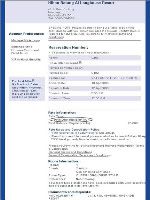
But even that acknowledgement was seemingly insufficient to convince him to take some sort of action and actually fix the problem! "What would you like me to do?," he asked. I patiently explained that a good start would be to remove the room charges for the award stay, which he finally but reluctantly agreed to do. And while he was at it, remove the erroneous minibar charges as well.
I told the GM that I cannot understand how a simple and straightforward award reservation made directly with Hilton personnel could not be acknowledged by his property. Why would a reservation show up correctly in every Hilton mediated computer system except theirs? How can a property exhibiting the Hilton icon for more than 13 years, appear to have neither the interest nor inclination to honor the word "honors" in Hilton HHonors?
He thought all of this through and then slowly replied, "We do not target our marketing towards the American traveler." Perhaps he is correct. At the very least, they certainly do not appear to be targeting visitors who have even the most remote acquaintance with Hilton HHonors. Of the various guests with whom I spoke, not one of them was a member of the Hilton HHonors program nor demonstrated even the slightest familiarity with it.
I told the GM that I was very unhappy about all of the issues that I had encountered during my stay. I wasted more than an hour checking in and nearly two hours this morning and felt that it was not reasonable for the hotel to steal so much vacation time from me. He thought about it a bit and then offered me a cup of coffee. I explained to him that three hours of my time is worth a lot more than that and asked him to remove one of the dinner charges as compensation for my time. With some reluctance, he said that he would do it. After finally obtaining a revised copy of my bill, I wandered back to my room to wait for the appointed hour at which I could finally make my escape from this place by boat.
I explained to him that three hours of my time is worth a lot more than that and asked him to remove one of the dinner charges as compensation for my time. With some reluctance, he said that he would do it. After finally obtaining a revised copy of my bill, I wandered back to my room to wait for the appointed hour at which I could finally make my escape from this place by boat.
I returned to the lobby promptly at noon and then wandered towards the dock, accompanied by two couples, one from the UK and one from Australia. On the way down, we passed a large assemblage of children, who had just arrived at the Hilton Batang Ai, evidently part of a school outing.
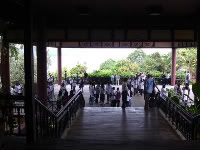
After a wait of about 10 minutes, the boat pulled into the dock and then shoved off a few minutes later for the return ride back to the Hilton pier near the dam.

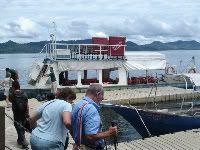
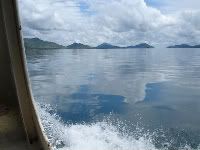
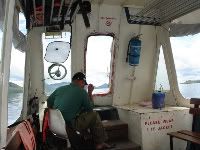

Sizzling Serian
On the long ride back to Kuching, I shared some tales of the Batang Ai with the four other travelers in the van. They told me about a French woman who was furious because she had paid a fee to play tennis but when she arrived at the court at 10:00 AM, it was covered with dead tree limbs and other large chunks of detritus. Explaining to the staff that the tennis court was completely unplayable, she asked to have it readied for use as soon as possible. She checked several times throughout the day and nothing had been done about it so she eventually escalated the problem to the manager. By 4:00 PM that afternoon, the court still had not been cleaned up. One thing is very clear, the Hilton Batang Ai is probably one of the most ineptly managed hotels I have ever visited.
As we continued along on our way back to Kuching, we stopped at the Lachau rest stop again, where the driver grabbed a late lunch and one of the passengers stoked her lungs with numerous cigarettes. Once on the road again, dark storm clouds began forming in the southern mountains that demark the border between Sarawak and Kalimantan, Indonesia. It began to rain torrentially for a while but the precipitation dissipated by the time we reached the outskirts of Serian.
Serian's main claim to fame is that its one of the primary areas in the region for growing the "delicious" Durian. In fact, the town has constructed a large monument to the malodorous fruit, positioned prominently in the middle of its central market.
As we drove along the Pan Borneo highway through Serian, our driver announced that, "This is Serian Town. Last year this was on fire." He added, "This is a new one."

I would guess that fire must be a relatively common occurrence here because, according to one web page, "In this land, fire rules supreme." There is even a slide show of the fire, which gutted 27 companies in 75-year-old buildings over a two block area.
After arriving back in Kuching in the midst of rush hour, the other passengers were dropped off respectively at the Holiday Inn and the Crowne Plaza; I returned back to the Hilton. After checking in, Angela called to see if I wanted to have dinner with her and Idzuan and Azman on the other side of the river. However, I decided to wimp out for the evening, preferring to relax and vegetate in the Hilton club lounge and regale the concierges with exciting tales of the Hilton Batang Ai Ai Ai.
Next Chapter: Jungle Grub Ö
The area that would eventually become home to Batang Ai National Park was originally populated by the Iban, whose name for the region literally means, "the river." It was one of the last areas to come under the influence of the White Rajah, James Brooke, and its ultimate subjugation led to the slaughter of 800 of its indigenous residents. At the time, well over 40 longhouses populated the banks of the river and when the dam that formed the 80 sq km Batang Ai reservoir was finished in 1985, most of these dwellings were inundated and its residents resettled. The national park was established in 1991 and now spans an area of 240 sq km. When combined with the adjoining Lanjak-Entimau Wildlife Sanctuary in Malaysia and the Betung-Kerihun National Park in West Kalimantan, Indonesia, the region forms a much larger ecological refuge covering an area of 10,000 sq km.
The Hilton Batang Ai Resort opened on the shores of Batang Ai lake in 1995 and is managed and operated by the Hilton Kuching. On the one hand, the control that the Hilton Kuching exerts on the Batang Ai property seems to be so tight that at times it appears that the local staff and management cannot make a single decision without frequent and detailed instructions from headquarters for any and every situation, no matter how trivial. On the other hand, as a Diamond VIP member of the Hilton HHonors program, my treatment by these two properties could not have been more different, ranging from superb at the Hilton Kuching to clueless and indifferent at the Hilton Batang Ai.

On its web site, the description of the Hilton Batang Ai certainly sounded quite attractive to a former ecologist such as myself. It begins, "Set on the edge of spectacular rainforest, the Hilton Batang Ai Longhouse Resort is Hiltonís only jungle propertyÖ" However, even from its inception, the reviews of the service and treatment at this property have always been a mixed bag, ranging from tepid at best to horrific at worst.
One would think that after over 13 years in business, this property would have finally found its groove but that is most definitely not the case. In the recent past, the hotelís one saving grace was that its room rates were always very reasonable, often less than $40 USD per night. These low rates could offset some of the other high costs, such as transportation to the property and the cost of meals provided to a captive audience. This is no longer the case.
Room rates are now nearly twice what they were a year ago unless one books through a third party and thereby forgoes Hilton points and elite treatment. Then again, I could discern very little elite recognition while I was there so booking through Hilton may not produce much of a benefit anyway. The cost of meals, though never inexpensive, was now ludicrously high. In my case, each dinner priced out at 78 ringgits, an amount for which three hungry guys could dine on some very nice seafood in Kuching and still get change.
As a certified glutton for punishment, I booked not one, but two nights at this property, figuring that a two night stay would more effectively amortize both my transportation costs and the time it takes to get there. To ameliorate these costs somewhat, I booked my room as an award stay with the Diamond Desk, still a very reasonable 10,000 points per night for this category 1 property
Getting to Batang Ai requires a 250 km overland trip from Kuching to the Hilton jetty, followed by a 20 minute boat ride to the entrance of the 100 room resort, nestled serenely on the shores of the reservoir. Its web site advised that transportation arrangements should be made in advance so I sent a polite and detailed email that specified my travel dates and included all of my reservation details. After a week had elapsed, I had not received a reply to my original email so I sent another email to the manager of the Hilton Kuching and this email was ignored as well.

I then contacted the Hilton Diamond Desk, whose somewhat terse reply was that, "I guess you could call them directly." As an admittedly unrelated aside, when I recently needed to resolve an unsettled transportation issue for a Starwood property in Bali, the platinum concierge was on the phone directly with the property within a minute, took care of the issue right away and even followed up with me afterwards. From this, you can conclude what you will about the quality of support that Hilton HHonors customer service provides to its elite guests, at least compared to benefits provided by Starwood Preferred Guest.
Given that I would already be in Kuching for several days before starting my journey to Batang Ai, I scheduled my transportation directly with a concierge on the club floor of the Hilton Kuching. At the time, the cost of the transportation listed on the web site was 110 ringgits but on the morning of my departure, I was provided with a voucher listing a rate of 145 ringgits. By the time I arrived outside to wait for the shuttle van, another Hilton staffer told me the rate actually should have been closer to 400 ringgits but they were doing me a big favor.

Later on, during a very lengthy check-in process, a staff member at the Batang Ai asked me to sign a receipt for 248 ringgits, which I refused to do.
 Please note that guests are not obliged to make travel arrangements through the Hilton Kuching but can avail themselves of the services of any one of the myriad travel agencies that inhabit Kuching, probably at a lower cost and more honest treatment.
Please note that guests are not obliged to make travel arrangements through the Hilton Kuching but can avail themselves of the services of any one of the myriad travel agencies that inhabit Kuching, probably at a lower cost and more honest treatment.The trip out to the dam took exactly four hours, including a rest stop at Lachau, where the driver grabbed lunch and guests can avail themselves of a pay toilet and some small shops. If you are intending to load up on snacks in an attempt to sidestep some of the usurious food prices at Batang Ai, this will be your last chance to do so. The road itself is fully paved, at least until one comes within a couple of miles of the dam. If you are expecting to traverse a pockmarked crater-filled dirt road, the quality of the surface will greatly exceed your expectations. If you are anticipating a modern, smooth, evenly paved roadway, then you will be slightly disappointed.





Once we arrived in the vicinity of the Hilton jetty, I was led to a small covered waiting area from where one can wait for the arrival of the boat, well protected from the sun or any inclement weather, should there be any. After 15 minutes, I could see a boat on its way across the lake, so I walked down a paved driveway and hopped aboard, seemingly accompanied mostly by local folk.






After a 20 minute cruise across the calm lake, the expansive Hilton Batang Ai property came into view, its dark brown, longhouse style buildings blending in naturally with the surrounding lush green landscape.





Once the boat pulled up to the Hilton Batang Ai dock, two friendly staff members assisted me up several flights of stairs and into the lobby, where we sat on a couch and talked for about 20 minutes. I learned that the hotel expected to serve about 24 guests on that Thursday evening but they anticipated that this number would double for the weekend rush the following night. I also learned that the majority of visitors are typically affiliated with various package tours and relatively few of them are Americans. Indeed, based on subsequent conversations with some of the other guests during my visit, this turned out to be a very accurate assessment. Most of the visitors spend a day or two but I was astonished to learn that there was currently one guest in residence who was currently in the midst of a 30 day stay and had already been there previously. Yikes.


I was trying to be as polite as I could as I sat there and pondered why I was not checking in. Early on, when I asked the staff members about it, they explained that there was already a guest standing by the front desk. But that guest had long since wandered off and here I was still sitting on the couch. I ultimately just thanked the staffers for the pleasant chat and ambled over to the front desk on my own, standing right next to the silver Hilton HHonors plaque.

I presented the front desk clerk with all of my credentials, including my Hilton HHonors Diamond card, a credit card and a printout of my two night award certificate, clearly bearing the words, "Diamond Redemption." Perhaps it was me but nearly everything I did or said seemed to confuse her. I asked about breakfast, about a diamond upgrade and about bottled water in the room. I could not get a straight answer about anything. I don't think it was a language barrier because I encountered very few communications issues with any other staff members and I interacted with many of them.
When she presented me with a transportation receipt for 248 ringgits, I showed her the voucher issued by the Hilton Kuching, clearly spelling out a price of 145 ringgits in bold letters. She responded that she would need to get instructions from the Hilton Kuching, which seemed to be the standard response to even the most minor question during my stay.
On the lengthy walk to my room, I learned that only a few of the buildings on the property are currently open for guests due to very low occupancy. The room itself was very small and dingy and I could not understand why something better was not available, especially when one considers that there were very few other guests at the hotel. When I asked about bottled water and one of the staffers pointed to the tap, I had had enough and told them I would be returning to the lobby.
Once back at the front desk, I asked to speak to the manager on duty and was eventually greeted by Jalan. I explained my concerns and disappointments to him and he said that though the computer system had my Hilton HHonors number, it did not indicate anything about my elite status. This response certainly seemed very strange to me given that I made the reservation through the diamond desk and had received several subsequent reminders from Hilton about my upcoming stay. The Hilton Kuching certainly seemed very well aware of my status and they metaphorically constitute the puppeteer who pulls the strings of the Batang Ai marionette. And I suppose that the Hilton Diamond membership card that I presented when I initially checked in was not functioning well either.

Nevertheless, Jalan eventually straightened everything out both pleasantly and graciously. I was reassigned to a spacious duplex suite a short walk away from the main building. The bedroom was located upstairs and, though not as cool as downstairs, had its own air conditioning unit and a ceiling fan so it was eminently survivable. There was a bathroom on both levels and downstairs was a minibar that contained two complimentary bottles of water. ^





After I settled into my room, I went for a long walk around the very beautiful property. From my longhouse, I walked past the pool, back through the lobby and the restaurant and then descended down towards the dock and waterfront.








I walked as much as I could around the well landscaped grounds, richly planted with a nice variety of flowers, fruit trees and other attractive vegetation.




Corn-ucopia
At 7:00 PM, I materialized at the entrance of the restaurant for dinner, where one can enjoy numerous dishes derived from a wide variety of local jungle fare:

OK, I'm just kidding about that, that's actually a list of creatures that you are not supposed to eat.
 Each night, a buffet dinner is available in the Nanga Mepi restaurant, according to a schedule mounted on a wall not very far from the entrance to the restaurant.
Each night, a buffet dinner is available in the Nanga Mepi restaurant, according to a schedule mounted on a wall not very far from the entrance to the restaurant.



The cost of the buffet dinner amounted to a very expensive 78 ringgits but an ala carte menu is available if you ask for it. The presentation of the buffet is actually very attractive and I thought that the food for dinner was fairly decent. I was less impressed with breakfast, which I found to be unimaginative and bland. Of course, I readily confess that I had been quite spoiled by the superb breakfast fare provided by the Hilton Kuching and the The Westin Kuala Lumpur.
Overall, the service and staff at all of the meals were very friendly and attentive. Perhaps a little too attentive when one considers the very high ratio of staff members to guests.






I wrapped up dinner by sampling a diverse assortment of flavorful and attractive cakes, fruit and ice cream. The latter was available in three flavors, chocolate, strawberry and what I initially assumed was a yellowish tinted vanilla but actually turned out to be corn flavored. If you are unsure about whether or not you will enjoy corn ice cream, just try to recall the taste of canned creamed corn. You can now imagine the taste of corn ice cream. It appeared that nobody else was willing to try the corn ice cream except for me so I had a second helping because it was looking very lonely and neglected on the buffet.

From what I understand, the dominant player in the local ice cream market, Nestle, plans to introduce other popular local flavors into East Malaysia such as sago and yam. As odd as some of these ice cream varieties may seem, they are still fairly innocuous when compared to some of the more interesting and bizarre flavors such as raw horse flesh and other exotic flavors that one may encounter in Japan.

Each evening, the hotel advertises a free video presentation and nature talk. When I arrived at the designated room at 9:00 PM, all of the windows were closed and both the ceiling fan and air conditioning were initially turned off. The nature video itself was entertaining enough but it seemed somewhat incongruous that it focused on the orang utans inhabiting Sepilok, which is a sanctuary located in Sabah. I would have thought it would have been more appropriate to play a video emphasizing some aspect of nature endemic to Sarawak but what do I know about running a longhouse resort in Sarawak.
 The next evening turned out to be a repeat performance, including both the airless room and precisely the same Sepilok video. From what I learned, they have evidently replayed the same video every night since the inception of the hotel.
The next evening turned out to be a repeat performance, including both the airless room and precisely the same Sepilok video. From what I learned, they have evidently replayed the same video every night since the inception of the hotel. 
Prior to heading back to my room, I inspected the list of activities that were available to guests. I signed up for the free morning sunrise walk and was instructed to present myself in the lobby promptly at 5:45 AM. I also signed up for a one hour nature walk that would begin later in the morning at a cost of five ringgits for the walk plus an additional five ringgits for an optional bottle of water. I also contemplated booking a fishing trip but, like most of the other activities, it was priced for a minimum of two people and I was unwilling to bear the entire cost of this activity alone. On the way back to my room, I picked up a brochure listing these very same activities and could not help but notice that the prices listed on the printout were completely different from those on public display in the lobby.


Learning the Ropes on the Canopy Walk
The next morning, I woke up early from a sleep that proved to be quite difficult because the soundproofing between rooms was so poor that I could hear every disgusting gasp, snort, retch and wheeze from the unhappy guest in the adjoining room. In fact, he sounded so bad at times that I had briefly contemplated notifying the hotel staff that the fellow might require some medical attention. As I left the bedroom, I encountered an unfortunate room design flaw. There is no light switch at the top of the stairs to illuminate the lower level so one is forced to stumble down the oddly pitched stairs in complete darkness and then fumble around for a light switch downstairs.
I arrived in the lobby a little before 5:45 AM and by 6:10 AM, nobody had shown up to lead the hike. After some friendly prompting on my part, a fellow eventually materialized and off we went, just the two of us, towards a point of land about a 10 minute walk from the lobby. To be honest, he seemed a little bit surprised that anyone showed up at all so I would guess that guests attending these early morning strolls must be relatively rare. We talked quietly for a bit but he seemed more interested in smoking than anything else and soon we just stood in silence and listened to the sounds of all of the birds who had arisen early to greet the dawn.





At 10:00 AM, I met two guests from Holland in the lobby and then embarked on the brief nature walk with a guide, Peter. We sauntered around the property for a short while and then undertook a steep but very quick climb that eventually placed us at the foot of an old grave in the middle of the jungle. At one end of the grave was a large ceramic jar and a couple of smaller empty glass bottles, both very well weathered and partially covered with moss. Scattered amongst the leaves that littered the moist surface of the grave were a large number of ringgits, mostly coins but there was also a smaller tray containing some paper currency.


Ancestor worship is a fundamental component of Iban spirituality because of the firm belief that the dead can influence and be influenced by their living descendants. The living hope that their ancestors will look favorably on them or, at the very least, not screw around with them. From what I understand, once a year the family of the deceased gather by the grave to have a picnic to honor their ancestors. Of course, extra food and drink is brought along to share with the dead.
From the gravesite, we walked a bit further through the jungle until we found ourselves at the threshold of an elevated rope walkway, wending its way amongst the treetops suspended 30 meters above the ground. Semi-firm footing was provided by well-aged narrow wooden planks that often groaned and squeaked under the weight of my steps. The suspended walkway wobbled considerably as I slowly inched my way along, tightly clutching the web of rope netting that held it precariously off the ground.





Halfway along the canopy walk, I arrived at a wooden tree platform, elevated 40 meters above the ground. From there, I was afforded stunning views of the turquoise waters of Batang Ai Lake, rendered an even more intense blue because of its juxtaposition against the verdant green backdrop of the surrounding terrain. From the platform, I ascended a rickety wooden ladder that gave way to another rope walkway, this one deployed on a sharp incline. That walkway terminated at another viewing platform, affording additional stunning views of the surrounding landscape.









At the conclusion of the nature walk, we returned to the environs of the Hilton an hour after it had begun. Afterwards, I continued wandering around the area for a bit on my own, walking down each trail I could find until I could go no further. Along the way, I examined a variety of interesting fruits and flowers and spotted a fish farm anchored serenely in the middle of the calm lake, evidently holding red tilapia until they were large enough to eat.




When I returned to my room to relax and cool off a bit, I found that it had been fully serviced by housekeeping but my two small bottles of water had not been replaced. Various staff members in the lobby stared it me blankly when I asked for two more bottles until Jalan wandered by and took care of it. Sort of.
When I returned to the room about an hour later, I found two new bottles of water in the room. However, upon closer inspection, I could readily see that they were not sealed!
 So, I would presume that hotel employees must retrieve discarded water bottles from the garbage, refill them with some species of water and then redeploy the bottles back to the guest rooms. This rather defeats the intent and purpose of bottled water, in my humble opinion.
So, I would presume that hotel employees must retrieve discarded water bottles from the garbage, refill them with some species of water and then redeploy the bottles back to the guest rooms. This rather defeats the intent and purpose of bottled water, in my humble opinion. 
Later on, I decided to sit out by the pool a bit, protected from the searing sun by the ample shade provided by a very large umbrella. Even with that, conditions were still somewhat uncomfortable due to the thick and dense humidity. One other guest showed up while I was there and then she too wandered off, presumably to cooler pastures. I must confess that I was not especially disappointed when the skies began to darken and the hotel staff scurried out and take down the large umbrellas, forcing me to go indoors for a bit and replenish my air conditioning deficiency.


Yours is a Very Bad Longhouse*
Given some of my unsatisfactory and profoundly bewildering interactions with the front desk staff thus far, I reasoned that it might behoove me to budget just a little extra time for me to checkout. So, I wandered over to the front desk immediately after breakfast, figuring that a full four hours before my noon checkout might be a sufficient amount of time for this complicated task.

The desk clerk presented me with a bill that contained some very interesting charges indeed, including about 30 ringgits worth of erroneous minibar fees and room charges in the amount of 332.35 ringgits per night! I asked the desk clerk why I have any room charges on an award stay and she seemed not to understand. I wrote the word "award" on the bill right next to the charge and underlined it, all to no avail. I showed her my diamond card and pointed to the silver Hilton HHonors plaque positioned prominently on the front desk that was seemingly deployed only for decoration.
She claimed the computer system had no evidence of the award redemption nor even of my Hilton HHonors membership. I was inundated with a wave of dťjŗ vu as I thought back to my prolonged and confusing check-in difficulties just two days prior. Clearly at a communications impasse, I ran off to my room and returned to the front desk clutching a copy of both my reservation confirmation and my award certificate.
A reasonable person would have concluded by now that all of this documentation should have successfully resolved this issue, a problem that should never have occurred in the first place. But it didn't. Still unwilling or unable to either grasp or acknowledge that I have already paid for their hospitality via the currency of Hilton points, the desk clerk finally responded with the all too familiar mantra that she will need to call the Hilton Kuching for instructions.

I retreated to a comfortable corner of the couch and observed her efforts from a safe distance. Phone calls were made, faxes were exchanged and there I sat. After nearly one hour of patiently twiddling my thumbs in the lobby, I approached the front desk and asked the desk clerk whether the problem had been fixed. When she responded with a simple, "No," I quietly and firmly instructed her to summon the general manager immediately. It was now after 9:00 AM and she explained that he was still in his suite.
 "Please ask him to come to the front desk," I repeated, before returning to my couch.
"Please ask him to come to the front desk," I repeated, before returning to my couch.Fifteen minutes later, Jonathan walked slowly into the lobby and stopped for chitchat with various people along the way, with an air sort of like Kurtz overseeing his minions in the heart of darkness. He did not seem to be in much of a hurry and neither made eye contact nor attempted to approach me. I finally approached him and attempted to explain the problem. He also appeared to be unable to grasp the evidently difficult concept of an award stay. In all of their years of operation, could I have really been the only guest foolish enough to waste my hard earned Hilton points at this property? I presented the manager with a copy of my of my documentation and he stared at the sheet of paper for a full five minutes before acknowledging that it does indeed have the word "award" printed on it.


But even that acknowledgement was seemingly insufficient to convince him to take some sort of action and actually fix the problem! "What would you like me to do?," he asked. I patiently explained that a good start would be to remove the room charges for the award stay, which he finally but reluctantly agreed to do. And while he was at it, remove the erroneous minibar charges as well.
I told the GM that I cannot understand how a simple and straightforward award reservation made directly with Hilton personnel could not be acknowledged by his property. Why would a reservation show up correctly in every Hilton mediated computer system except theirs? How can a property exhibiting the Hilton icon for more than 13 years, appear to have neither the interest nor inclination to honor the word "honors" in Hilton HHonors?
He thought all of this through and then slowly replied, "We do not target our marketing towards the American traveler." Perhaps he is correct. At the very least, they certainly do not appear to be targeting visitors who have even the most remote acquaintance with Hilton HHonors. Of the various guests with whom I spoke, not one of them was a member of the Hilton HHonors program nor demonstrated even the slightest familiarity with it.
I told the GM that I was very unhappy about all of the issues that I had encountered during my stay. I wasted more than an hour checking in and nearly two hours this morning and felt that it was not reasonable for the hotel to steal so much vacation time from me. He thought about it a bit and then offered me a cup of coffee.
 I explained to him that three hours of my time is worth a lot more than that and asked him to remove one of the dinner charges as compensation for my time. With some reluctance, he said that he would do it. After finally obtaining a revised copy of my bill, I wandered back to my room to wait for the appointed hour at which I could finally make my escape from this place by boat.
I explained to him that three hours of my time is worth a lot more than that and asked him to remove one of the dinner charges as compensation for my time. With some reluctance, he said that he would do it. After finally obtaining a revised copy of my bill, I wandered back to my room to wait for the appointed hour at which I could finally make my escape from this place by boat.I returned to the lobby promptly at noon and then wandered towards the dock, accompanied by two couples, one from the UK and one from Australia. On the way down, we passed a large assemblage of children, who had just arrived at the Hilton Batang Ai, evidently part of a school outing.

After a wait of about 10 minutes, the boat pulled into the dock and then shoved off a few minutes later for the return ride back to the Hilton pier near the dam.





Sizzling Serian
On the long ride back to Kuching, I shared some tales of the Batang Ai with the four other travelers in the van. They told me about a French woman who was furious because she had paid a fee to play tennis but when she arrived at the court at 10:00 AM, it was covered with dead tree limbs and other large chunks of detritus. Explaining to the staff that the tennis court was completely unplayable, she asked to have it readied for use as soon as possible. She checked several times throughout the day and nothing had been done about it so she eventually escalated the problem to the manager. By 4:00 PM that afternoon, the court still had not been cleaned up. One thing is very clear, the Hilton Batang Ai is probably one of the most ineptly managed hotels I have ever visited.

As we continued along on our way back to Kuching, we stopped at the Lachau rest stop again, where the driver grabbed a late lunch and one of the passengers stoked her lungs with numerous cigarettes. Once on the road again, dark storm clouds began forming in the southern mountains that demark the border between Sarawak and Kalimantan, Indonesia. It began to rain torrentially for a while but the precipitation dissipated by the time we reached the outskirts of Serian.
Serian's main claim to fame is that its one of the primary areas in the region for growing the "delicious" Durian. In fact, the town has constructed a large monument to the malodorous fruit, positioned prominently in the middle of its central market.
As we drove along the Pan Borneo highway through Serian, our driver announced that, "This is Serian Town. Last year this was on fire." He added, "This is a new one."

I would guess that fire must be a relatively common occurrence here because, according to one web page, "In this land, fire rules supreme." There is even a slide show of the fire, which gutted 27 companies in 75-year-old buildings over a two block area.
After arriving back in Kuching in the midst of rush hour, the other passengers were dropped off respectively at the Holiday Inn and the Crowne Plaza; I returned back to the Hilton. After checking in, Angela called to see if I wanted to have dinner with her and Idzuan and Azman on the other side of the river. However, I decided to wimp out for the evening, preferring to relax and vegetate in the Hilton club lounge and regale the concierges with exciting tales of the Hilton Batang Ai Ai Ai.
Next Chapter: Jungle Grub Ö
#10
Join Date: Aug 2001
Location: Portland, OR
Programs: NW Plat (now they call it DL Diamond) 1MM, soon to be DL Plat, Hilton Diamond, SPG Gold, Dusit Gold
Posts: 2,706
"As a certified glutton for punishment, I booked not one, but two nights at this property, figuring that a two night stay would more effectively amortize both my transportation costs and the time it takes to get there."
We talked about all the issues (albeit not award redemption because in the past one would not bother redeeming 10k points for a $30 stay), but since you like me had to see for yourself. Now you've been there, seen it and suffered the indignity of 2 nights at Batang Ai. Excellent documentation, better than my Batang Ai trip report of about 3 years ago. You did get a nicer suite than mine, really, a bath upstairs, and excellent idea and much better than the ladder like stairs at 2 a.m. But then again you are an American Diamond member and my stay was as a lowly gold. But, I got points for my stay.
BTW: My room was next to a couple having non-stop noisy sex. Peter informed me that all the animals had been eaten.
On the issue of mistiming, take it up with the manager of that department who rides the 8 ringit bus. He is the guy who gets off at the gas station.
We talked about all the issues (albeit not award redemption because in the past one would not bother redeeming 10k points for a $30 stay), but since you like me had to see for yourself. Now you've been there, seen it and suffered the indignity of 2 nights at Batang Ai. Excellent documentation, better than my Batang Ai trip report of about 3 years ago. You did get a nicer suite than mine, really, a bath upstairs, and excellent idea and much better than the ladder like stairs at 2 a.m. But then again you are an American Diamond member and my stay was as a lowly gold. But, I got points for my stay.
BTW: My room was next to a couple having non-stop noisy sex. Peter informed me that all the animals had been eaten.
On the issue of mistiming, take it up with the manager of that department who rides the 8 ringit bus. He is the guy who gets off at the gas station.
#11
Original Poster
Join Date: Feb 2000
Location: Lake Oswego, OR
Programs: UA 1K 2MM, Marriott Lifetime Platinum, Hilton Diamond
Posts: 3,202
LOL. I don't recall Peter mentioning that all of the animals had been eaten but several of the staff did mention that there were very few fish in the lake. I guess that would explain why the only mammal I saw was a very nervous looking squirrel who was obviously too quick for them. I would think that the sign near the restaurant listing all of the wildlife that one is not supposed to eat appears rather superfluous under these circumstances.
#12
Original Poster
Join Date: Feb 2000
Location: Lake Oswego, OR
Programs: UA 1K 2MM, Marriott Lifetime Platinum, Hilton Diamond
Posts: 3,202
Jungle Grub
Pets or Food
The last time I visited a street fair in Borneo was in the middle of January, when I roamed around the Sunday market on Gaya Street in Kota Kinabalu. Without a doubt, they certainly offered an interesting and varied array of goods and services, including foot massages by blind masseurs and an extensive variety of exotic foods, both cooked and live.
As I wandered around the open air market, I came across a vendor selling live birds and yet another hawking plump and juicy sago worms, at one time an important dietary staple amongst the indigenous tribes of Sarawak and Sabah. I am told that the proper way to eat one is to hold it by its head, insert the wriggling body into oneís mouth and then bite the head off, which is discarded. I am not ashamed to admit that I didnít try any and neither did any of the worm vendors, despite my repeated teasing and cajoling. If you prefer your sago worms cooked, here is a recipe for Sago Delight. Well, at least now I know what to do if I want to get some good grub.
Well, at least now I know what to do if I want to get some good grub. 

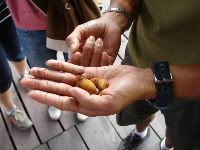

Continuing my stroll through the market, I arrived at a vendor selling numerous varieties of live tropical fish and I marveled at the fact that the fish were all still very much alive despite the oppressive heat. Given the inverse relationship between temperature and the dissolved oxygen content of water, I would have figured that any water held at such a high ambient temperature would have been virtually anoxic.
Situated next to the tropical fish stall, another vendor was hawking somewhat larger fish, many dead but others still alive, confined in a varied assemblage of diminutive aquaria. Whether they were pets or food was not as clear but I am guessing that they were intended to be food, even though the size of some of the fish was quite similar to the ones intended to be pets. In front of the very same stall, I observed a number of shoppers peering into several large plastic garbage cans. When I peeked inside the containers, I found a dozen or so sea turtles, constituting several different species, all clearly destined for the cooking pot. Next to that stall, another merchant was displaying several dozen puppies, some confined within cages barely larger than their bodies.
Next to that stall, another merchant was displaying several dozen puppies, some confined within cages barely larger than their bodies.
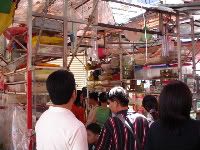
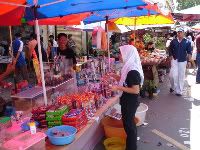
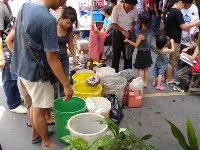
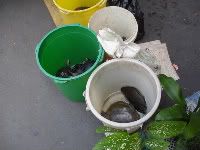
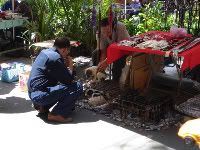
In Kuching, Pasar Minggu, the Sunday market is significantly larger than the one in Kota Kinabalu so I figured it would be a very interesting place to explore. Given that it was a fair distance west of the Hilton and I have a tendency to get lost quite easily, I decided to take a taxi to get there and would then work my way back to the Hilton by foot.
The Sunday market, which actually opens on Saturday afternoon, was indeed quite expansive. I arrived at about 10:30 on Sunday morning, considerably later than I had intended, so the ambient temperature was intensely scorching by the time I got there. It was so hot that I have no doubt that one could literally fry eggs on the sidewalk. Although I couldnít find any eggs sizzling on the cement, there were certainly plenty of other goodies being squeezed, fried, grilled, brewed and baked, albeit not on the ground.
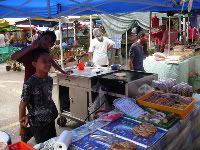
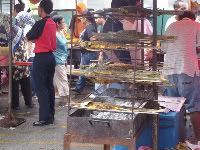

The market would be shutting down by 1:00 PM or so but even at that late hour, it was packed with people, most of whom appeared to be local rather than tourists. The hawkers themselves appeared to be an equal mix of Chinese, Malay and Bidayuh ethnicities, the latter group having journeyed into town from various longhouses situated on the outskirts of Kuching. Aisle after aisle of vendors hawked a myriad bounty of vegetables and fruits, all gathered from the farmland and jungles surrounding Kuching.

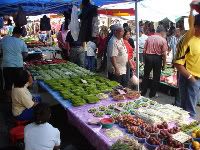



In one area of the market, hawkers were selling a wide variety of live plants and flowers. In other sections, stall after stall contained large tables laden with heaping mounds of coffee, dried fish, herbs, spices and mushrooms.
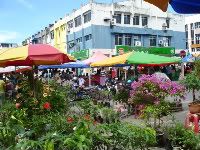


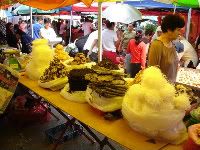
Several vendors could be seen squeezing out fresh sugar cane juice, almost certainly much healthier than the sugar "can" juice that had been offered at the Hilton breakfast buffet.
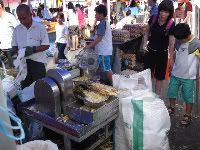
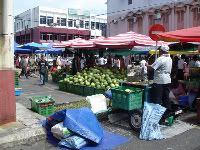

Fish and sea creatures of all shapes and sizes were available for purchase, some of them clearly for pets:
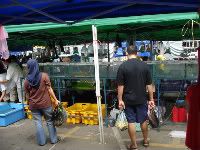
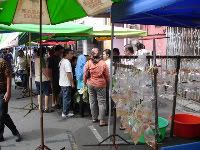
And some probably not:
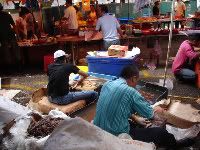

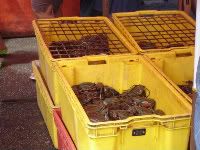
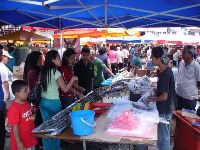

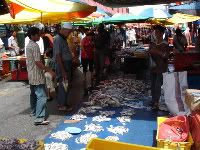

I did not encounter any fat, juicy squirming grubs like I had seen earlier in Kota Kinabalu so I guess they must have already sold out. There were some live partridges for sale, as well as some small live snakes, though I am not at all sure whether the latter were intended as pets or food. And amongst the complex variety of native crafts for sale, by far the most exotic had to be the large inflatable free range Homers that could be seen hanging from the eaves of a nearby building.


By the time I left the Sunday Market, it was nearly 1:00 PM. As I strolled slowly back towards the Hilton in the heat, I stopped briefly at the Sarawak Museum, where I enjoyed their comprehensive exhibits of local flora, fauna and native crafts. As is the case for all museums in Kuching, the cost of admission was free. And the value of the air conditioning was priceless.
My Village Skull House
On my last night in Kuching, I decided to invite Idzuan and Azman over to the Hilton club lounge to relax and enjoy some munchies and beverages on the 12th floor. We chatted for a bit and then watched as the cloudy sky grew dark and the light rain that had been threatening periodically throughout the day had finally seemed to come to an end. Although the lounge appetizers took the edge off of our appetites a bit, all three of us were hankering for something a bit more substantial so we decided to seek out some good seafood in a small village across the river.
After crossing the busy Jalan Tunku Abdul Rahman, we trundled over to a small dock and waited for one of the many sampans to make its way across the river and pick us up. The long wooden boats can accommodate about 12 passengers or so and we were the last ones to clamber on board and into the darkness by the edge of the river. The operator used a pair of scissor-like oars mounted on the bow of the boat to make his way a bit off shore and then started a small motor to finish the trip somewhat noisily towards the opposing pier on the other side of the river. As we exited the boat, Azman paid the driver about 30 sen each for our passage.
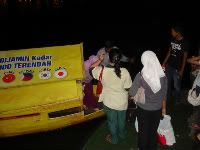
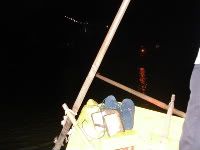
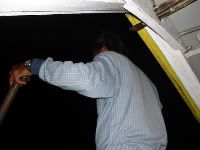
Once safely deposited on the opposing shore, we strode along the streets of a small kampung, where Moslem prayers filled the air over loudspeakers. A few minutes later, we wandered into yet another small Kampung, also well equipped with its own set of religious broadcast capabilities. In short order, we entered a small house, where we all took off our shoes and then wandered into a moderately sized living room. In one corner of the room was a large aquarium housing a hungry looking Arowana and some very nervous looking smaller fish. A coffee table in the center of the room held a pair of large intricately adorned wooden boxes comprised of six individual compartments. Within each compartment were strips of cake sporting a wide variety of colors and tastes.
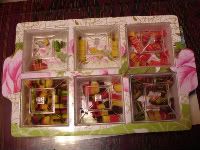
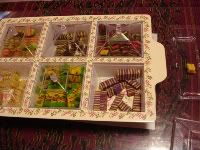
Azman and Idzuan dug right in so I was obliged to do so as well. Besides, free food is clearly the universal icon for hungry guys throughout the world. After gorging on as many of the free cake samples as I could, I followed the guys into the next room, which was evidently a sales area. Shelf after shelf held stacks of the colorful cakes, all clearly marked with both flavor and price. I confess to still being somewhat bewildered and confused by all of the goodies so I asked my companions what exactly I was looking at. "Kek Lapis," they quickly replied, figuring that this short response would provide me with all of the answers I would need.
Correctly sensing a continuing spark of confusion and uncertainty from me, they added, "thatís the world famous Sarawak Layer Cake!" The two of them walked gleefully amongst the shelves, stacking their arms high with layer cakes representing a veritable rainbow of flavors and colors. World famous the cakes may have been but I am not ashamed to admit that their renown had not quite made it across to my side of the Pacific, let alone to the distant land of New York City, where I grew up. Or if it had been famous in the states, I guess I wasnít paying sufficient attention. No matter, it certainly tasted decent enough and, whereas I had no immediate plans to make a purchase (preferring to travel as light as possible), I was happy enough to enjoy their interest and enthusiasm vicariously.
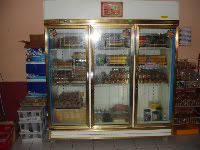
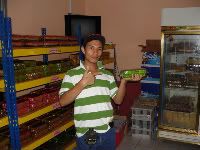
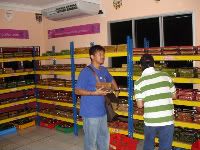

Some discussions in Malay ensued between the guys and the proprietor and, in short order, all three of us where invited into the "factory," situated just behind the main sales room. We all watched as a craftsman sliced and weaved the cakes together into numerous and varied attractive designs, his dexterous fingers swiftly manipulating the multihued layers and evidencing many years of skill and experience. As he worked on the cakes, I teased him a bit by asking why a man who was so artistically fashioning the famous Sarawak Layer Cake was wearing a sweatshirt emblazoned with Mount Kinabalu, a blatant symbol of Sabah tourism.
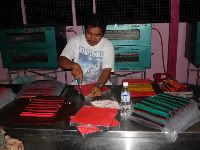
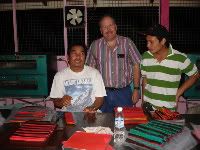
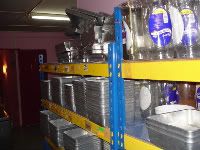
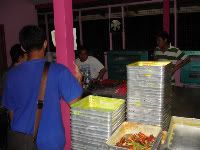
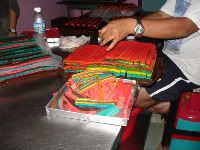

As the guys were paying for their mountain of Kek Lapis, the proprietor insisted I take one of the cakes with me as both a souvenir and a symbol of his hospitality. After exiting the factory and retrieving our shoes, I figured we would be heading back to the dock given that I was fairly full of Kek Lapis by then.
But we continued walking through the village and soon arrived within the domain of a sprawling outdoor seafood restaurant called, My Village Barok. As we settled into a private circular table off to the side, I was told it was built to resemble a baruk, the structure in which the original Iban denizens of Borneo traditionally stored head trophies.
After taking our seats and placing a drink order, we descended the simple wooden steps of our baruk and walked towards a counter that had been erected in front of the open air kitchen. The counter displayed a wide selection of fresh fish, live crabs and jungle vegetation, all eagerly clamoring for our inspection and purchase.

Though we had gorged ourselves on abundant helpings of Hilton snacks and Sarawak Kek Lapis, we ordered two chilli crabs, one whole fish, some specially prepared prawns, stir fried jungle fern, rice and a big portion of tom yum soup. Knowing my lack of enthusiasm for belacan, Azman and Idzuan kindly made quite sure that the smelly ingredient was used in generous abundance in as many dishes as possible.
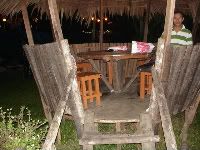
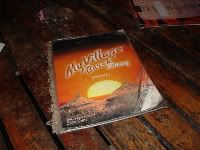
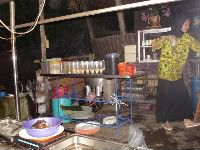
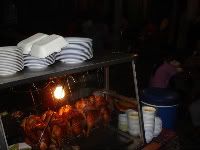
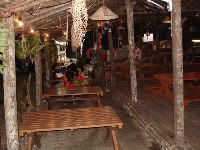
After all of our dishes had arrived, I began to chew on some belacan infused jungle fern and noticed that copious amounts of dirty-looking black liquid oozed out every time I look a bite. Soon enough, there was nothing edible left on our table, it was just a mass of prawn tails, fish bones, crab shells and dirty black jungle fern slime. The total cost for this huge seafood repast was approximately 60 ringgits. ^
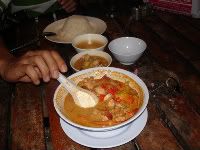

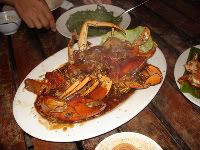
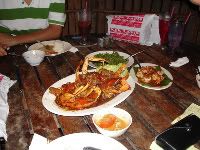
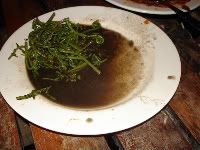
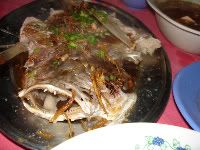
It was not until 10:30 PM before we arrived back at the dock to await our sampan journey back towards the Hilton side of the river. We were somewhat disappointed to arrive back at the dock so late because the tariff for sampan transportation triples at that time of night so it would now cost us a hefty 90 sen per person. As we waited for the boat to pick us up, several fisherman stood on the side of the dock holding lanterns. "Fishing for squid," they told us, as our small boat pulled in and we gingerly climbed on board and drifted into the darkness of the Sungai Sarawak.
As we waited for the boat to pick us up, several fisherman stood on the side of the dock holding lanterns. "Fishing for squid," they told us, as our small boat pulled in and we gingerly climbed on board and drifted into the darkness of the Sungai Sarawak.
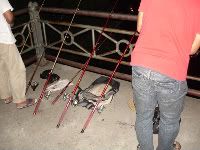
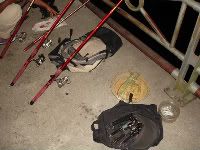
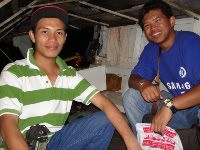
While we were plodding noisily across the river in our sampan, Angela called to say that she would like to have breakfast with me the next morning at the Hilton. I also learned that Idzuan and Azman were both on my Air Asia flight back to Kuala Lumpur the following afternoon and they kindly offered to give me a ride to the airport. Our flight was scheduled to depart at 3:05 PM and they explained that they planned to arrive about 45 minutes before departure.
Keeping in mind that they needed to return their rental car and also knowing that I liked to board early so I could snag a roomy seat in row one, I figured it might behoove me to make my own way to the airport on Tuesday. Besides, I explained, if there is one thing I have learned after flying nearly 2,000,000 million miles on UA and a smattering of miles on a variety of other airlines, it nearly always pays to arrive at the airport somewhat early. There is typically a great deal of uncertainty when flying and one can never be sure what the travel gods have in store. Little did I know at the time that this simple statement would turn out to be profoundly and sadly omniscient.
Final Chapter: Fight or Flight Ö
The last time I visited a street fair in Borneo was in the middle of January, when I roamed around the Sunday market on Gaya Street in Kota Kinabalu. Without a doubt, they certainly offered an interesting and varied array of goods and services, including foot massages by blind masseurs and an extensive variety of exotic foods, both cooked and live.
As I wandered around the open air market, I came across a vendor selling live birds and yet another hawking plump and juicy sago worms, at one time an important dietary staple amongst the indigenous tribes of Sarawak and Sabah. I am told that the proper way to eat one is to hold it by its head, insert the wriggling body into oneís mouth and then bite the head off, which is discarded. I am not ashamed to admit that I didnít try any and neither did any of the worm vendors, despite my repeated teasing and cajoling. If you prefer your sago worms cooked, here is a recipe for Sago Delight.
 Well, at least now I know what to do if I want to get some good grub.
Well, at least now I know what to do if I want to get some good grub. 



Continuing my stroll through the market, I arrived at a vendor selling numerous varieties of live tropical fish and I marveled at the fact that the fish were all still very much alive despite the oppressive heat. Given the inverse relationship between temperature and the dissolved oxygen content of water, I would have figured that any water held at such a high ambient temperature would have been virtually anoxic.
Situated next to the tropical fish stall, another vendor was hawking somewhat larger fish, many dead but others still alive, confined in a varied assemblage of diminutive aquaria. Whether they were pets or food was not as clear but I am guessing that they were intended to be food, even though the size of some of the fish was quite similar to the ones intended to be pets. In front of the very same stall, I observed a number of shoppers peering into several large plastic garbage cans. When I peeked inside the containers, I found a dozen or so sea turtles, constituting several different species, all clearly destined for the cooking pot.
 Next to that stall, another merchant was displaying several dozen puppies, some confined within cages barely larger than their bodies.
Next to that stall, another merchant was displaying several dozen puppies, some confined within cages barely larger than their bodies. 




In Kuching, Pasar Minggu, the Sunday market is significantly larger than the one in Kota Kinabalu so I figured it would be a very interesting place to explore. Given that it was a fair distance west of the Hilton and I have a tendency to get lost quite easily, I decided to take a taxi to get there and would then work my way back to the Hilton by foot.
The Sunday market, which actually opens on Saturday afternoon, was indeed quite expansive. I arrived at about 10:30 on Sunday morning, considerably later than I had intended, so the ambient temperature was intensely scorching by the time I got there. It was so hot that I have no doubt that one could literally fry eggs on the sidewalk. Although I couldnít find any eggs sizzling on the cement, there were certainly plenty of other goodies being squeezed, fried, grilled, brewed and baked, albeit not on the ground.



The market would be shutting down by 1:00 PM or so but even at that late hour, it was packed with people, most of whom appeared to be local rather than tourists. The hawkers themselves appeared to be an equal mix of Chinese, Malay and Bidayuh ethnicities, the latter group having journeyed into town from various longhouses situated on the outskirts of Kuching. Aisle after aisle of vendors hawked a myriad bounty of vegetables and fruits, all gathered from the farmland and jungles surrounding Kuching.





In one area of the market, hawkers were selling a wide variety of live plants and flowers. In other sections, stall after stall contained large tables laden with heaping mounds of coffee, dried fish, herbs, spices and mushrooms.




Several vendors could be seen squeezing out fresh sugar cane juice, almost certainly much healthier than the sugar "can" juice that had been offered at the Hilton breakfast buffet.



Fish and sea creatures of all shapes and sizes were available for purchase, some of them clearly for pets:


And some probably not:







I did not encounter any fat, juicy squirming grubs like I had seen earlier in Kota Kinabalu so I guess they must have already sold out. There were some live partridges for sale, as well as some small live snakes, though I am not at all sure whether the latter were intended as pets or food. And amongst the complex variety of native crafts for sale, by far the most exotic had to be the large inflatable free range Homers that could be seen hanging from the eaves of a nearby building.


By the time I left the Sunday Market, it was nearly 1:00 PM. As I strolled slowly back towards the Hilton in the heat, I stopped briefly at the Sarawak Museum, where I enjoyed their comprehensive exhibits of local flora, fauna and native crafts. As is the case for all museums in Kuching, the cost of admission was free. And the value of the air conditioning was priceless.

My Village Skull House
On my last night in Kuching, I decided to invite Idzuan and Azman over to the Hilton club lounge to relax and enjoy some munchies and beverages on the 12th floor. We chatted for a bit and then watched as the cloudy sky grew dark and the light rain that had been threatening periodically throughout the day had finally seemed to come to an end. Although the lounge appetizers took the edge off of our appetites a bit, all three of us were hankering for something a bit more substantial so we decided to seek out some good seafood in a small village across the river.
After crossing the busy Jalan Tunku Abdul Rahman, we trundled over to a small dock and waited for one of the many sampans to make its way across the river and pick us up. The long wooden boats can accommodate about 12 passengers or so and we were the last ones to clamber on board and into the darkness by the edge of the river. The operator used a pair of scissor-like oars mounted on the bow of the boat to make his way a bit off shore and then started a small motor to finish the trip somewhat noisily towards the opposing pier on the other side of the river. As we exited the boat, Azman paid the driver about 30 sen each for our passage.



Once safely deposited on the opposing shore, we strode along the streets of a small kampung, where Moslem prayers filled the air over loudspeakers. A few minutes later, we wandered into yet another small Kampung, also well equipped with its own set of religious broadcast capabilities. In short order, we entered a small house, where we all took off our shoes and then wandered into a moderately sized living room. In one corner of the room was a large aquarium housing a hungry looking Arowana and some very nervous looking smaller fish. A coffee table in the center of the room held a pair of large intricately adorned wooden boxes comprised of six individual compartments. Within each compartment were strips of cake sporting a wide variety of colors and tastes.


Azman and Idzuan dug right in so I was obliged to do so as well. Besides, free food is clearly the universal icon for hungry guys throughout the world. After gorging on as many of the free cake samples as I could, I followed the guys into the next room, which was evidently a sales area. Shelf after shelf held stacks of the colorful cakes, all clearly marked with both flavor and price. I confess to still being somewhat bewildered and confused by all of the goodies so I asked my companions what exactly I was looking at. "Kek Lapis," they quickly replied, figuring that this short response would provide me with all of the answers I would need.
Correctly sensing a continuing spark of confusion and uncertainty from me, they added, "thatís the world famous Sarawak Layer Cake!" The two of them walked gleefully amongst the shelves, stacking their arms high with layer cakes representing a veritable rainbow of flavors and colors. World famous the cakes may have been but I am not ashamed to admit that their renown had not quite made it across to my side of the Pacific, let alone to the distant land of New York City, where I grew up. Or if it had been famous in the states, I guess I wasnít paying sufficient attention. No matter, it certainly tasted decent enough and, whereas I had no immediate plans to make a purchase (preferring to travel as light as possible), I was happy enough to enjoy their interest and enthusiasm vicariously.




Some discussions in Malay ensued between the guys and the proprietor and, in short order, all three of us where invited into the "factory," situated just behind the main sales room. We all watched as a craftsman sliced and weaved the cakes together into numerous and varied attractive designs, his dexterous fingers swiftly manipulating the multihued layers and evidencing many years of skill and experience. As he worked on the cakes, I teased him a bit by asking why a man who was so artistically fashioning the famous Sarawak Layer Cake was wearing a sweatshirt emblazoned with Mount Kinabalu, a blatant symbol of Sabah tourism.






As the guys were paying for their mountain of Kek Lapis, the proprietor insisted I take one of the cakes with me as both a souvenir and a symbol of his hospitality. After exiting the factory and retrieving our shoes, I figured we would be heading back to the dock given that I was fairly full of Kek Lapis by then.

But we continued walking through the village and soon arrived within the domain of a sprawling outdoor seafood restaurant called, My Village Barok. As we settled into a private circular table off to the side, I was told it was built to resemble a baruk, the structure in which the original Iban denizens of Borneo traditionally stored head trophies.

After taking our seats and placing a drink order, we descended the simple wooden steps of our baruk and walked towards a counter that had been erected in front of the open air kitchen. The counter displayed a wide selection of fresh fish, live crabs and jungle vegetation, all eagerly clamoring for our inspection and purchase.

Though we had gorged ourselves on abundant helpings of Hilton snacks and Sarawak Kek Lapis, we ordered two chilli crabs, one whole fish, some specially prepared prawns, stir fried jungle fern, rice and a big portion of tom yum soup. Knowing my lack of enthusiasm for belacan, Azman and Idzuan kindly made quite sure that the smelly ingredient was used in generous abundance in as many dishes as possible.






After all of our dishes had arrived, I began to chew on some belacan infused jungle fern and noticed that copious amounts of dirty-looking black liquid oozed out every time I look a bite. Soon enough, there was nothing edible left on our table, it was just a mass of prawn tails, fish bones, crab shells and dirty black jungle fern slime. The total cost for this huge seafood repast was approximately 60 ringgits. ^






It was not until 10:30 PM before we arrived back at the dock to await our sampan journey back towards the Hilton side of the river. We were somewhat disappointed to arrive back at the dock so late because the tariff for sampan transportation triples at that time of night so it would now cost us a hefty 90 sen per person.
 As we waited for the boat to pick us up, several fisherman stood on the side of the dock holding lanterns. "Fishing for squid," they told us, as our small boat pulled in and we gingerly climbed on board and drifted into the darkness of the Sungai Sarawak.
As we waited for the boat to pick us up, several fisherman stood on the side of the dock holding lanterns. "Fishing for squid," they told us, as our small boat pulled in and we gingerly climbed on board and drifted into the darkness of the Sungai Sarawak.


While we were plodding noisily across the river in our sampan, Angela called to say that she would like to have breakfast with me the next morning at the Hilton. I also learned that Idzuan and Azman were both on my Air Asia flight back to Kuala Lumpur the following afternoon and they kindly offered to give me a ride to the airport. Our flight was scheduled to depart at 3:05 PM and they explained that they planned to arrive about 45 minutes before departure.
Keeping in mind that they needed to return their rental car and also knowing that I liked to board early so I could snag a roomy seat in row one, I figured it might behoove me to make my own way to the airport on Tuesday. Besides, I explained, if there is one thing I have learned after flying nearly 2,000,000 million miles on UA and a smattering of miles on a variety of other airlines, it nearly always pays to arrive at the airport somewhat early. There is typically a great deal of uncertainty when flying and one can never be sure what the travel gods have in store. Little did I know at the time that this simple statement would turn out to be profoundly and sadly omniscient.

Final Chapter: Fight or Flight Ö
#13
Join Date: Mar 2008
Location: Scotland
Programs: PC Spire Amb, HH Diamond, A3 Gold, Cathay Gold
Posts: 187
Amazingly detailed TR so far LarryU - kek lapis is delicious isn't it? Making notes for my own trip later this year and Tourism Malaysia should recruit you 
All thats left is to for you to conquer Mt Kinabalu!

All thats left is to for you to conquer Mt Kinabalu!
#15
Original Poster
Join Date: Feb 2000
Location: Lake Oswego, OR
Programs: UA 1K 2MM, Marriott Lifetime Platinum, Hilton Diamond
Posts: 3,202
Eating copious amounts of belacan was not so much my idea as it was that of my dinner companions, who made quite sure that all of our food was well doused with generous quantities of the redolent shrimp paste. All I can say is that I am very thankful that there did not appear to be any belacan flavored kek lapis available.





















